Research Methodology Assignment
VerifiedAdded on 2020/10/05
|51
|20504
|460
AI Summary
The provided document is an assignment that requires students to analyze and understand various research methods and studies related to organizational theory, innovation management, and social sciences. The assignment includes a list of references from academic journals and books, which provides a detailed overview of the topic. It also mentions specific research studies and articles that have been published in renowned journals, such as the Journal of Management, Orphanet Journal of Rare Diseases, and Energy. The assignment is likely to be used by students who are studying research methods, organizational theory, innovation management, or social sciences.
Contribute Materials
Your contribution can guide someone’s learning journey. Share your
documents today.
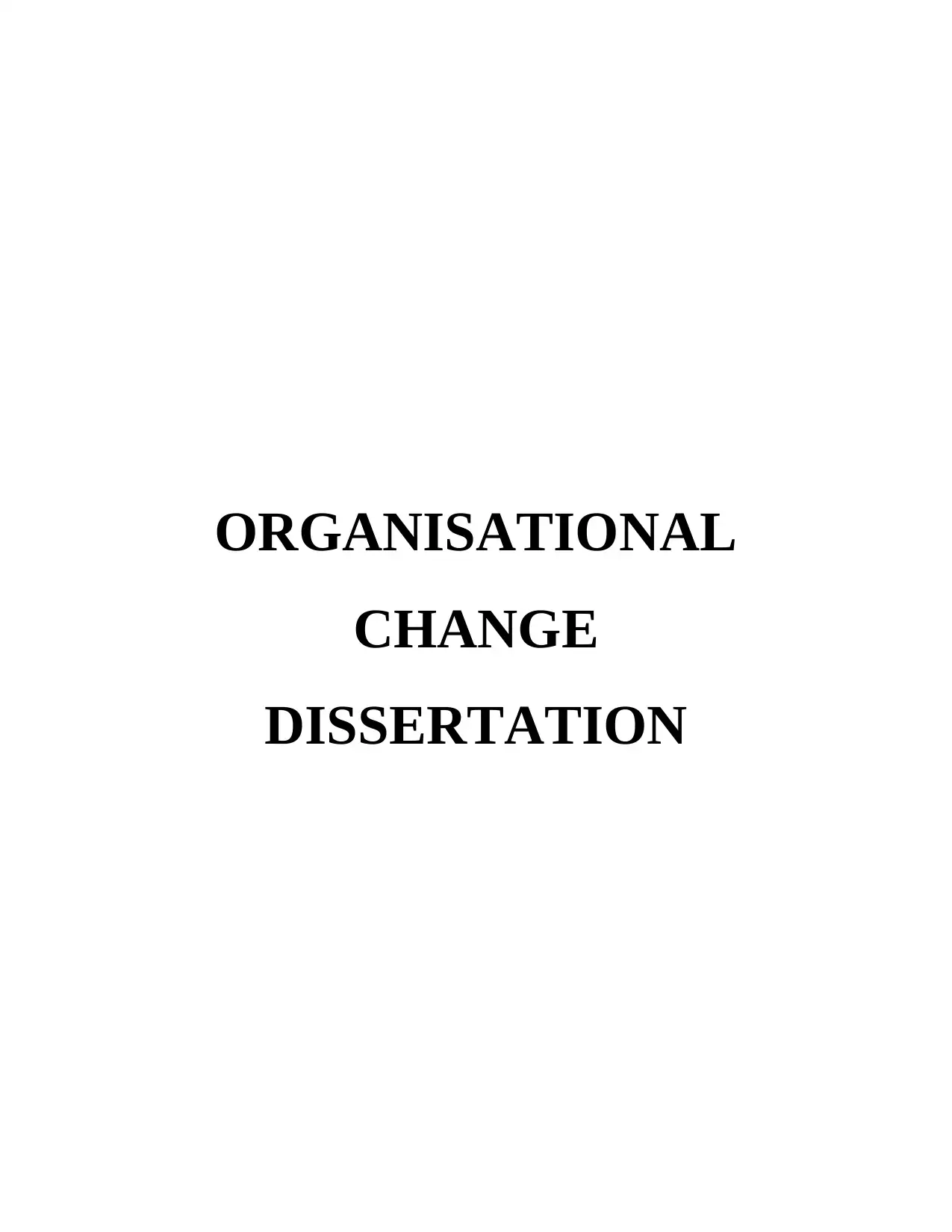
ORGANISATIONAL
CHANGE
DISSERTATION
CHANGE
DISSERTATION
Secure Best Marks with AI Grader
Need help grading? Try our AI Grader for instant feedback on your assignments.
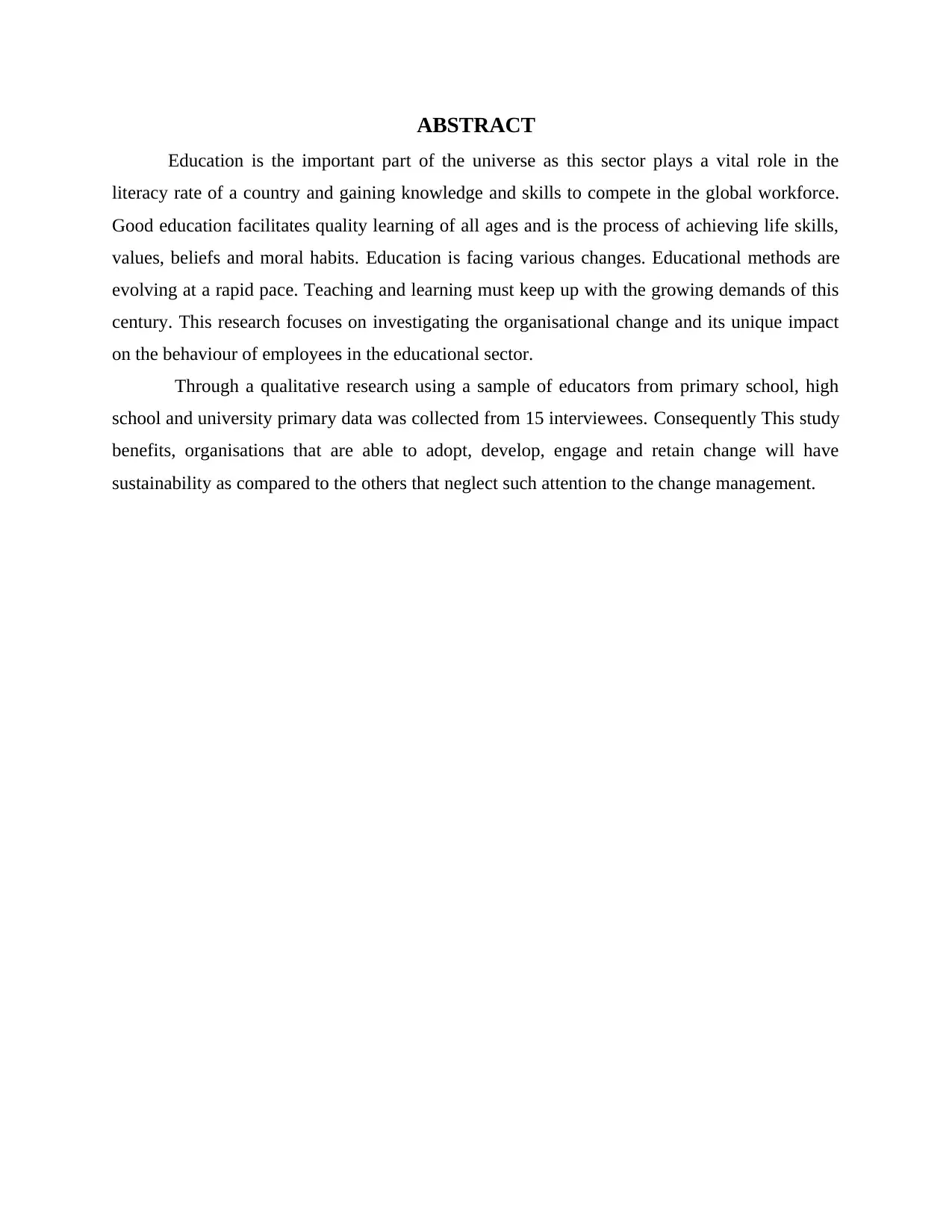
ABSTRACT
Education is the important part of the universe as this sector plays a vital role in the
literacy rate of a country and gaining knowledge and skills to compete in the global workforce.
Good education facilitates quality learning of all ages and is the process of achieving life skills,
values, beliefs and moral habits. Education is facing various changes. Educational methods are
evolving at a rapid pace. Teaching and learning must keep up with the growing demands of this
century. This research focuses on investigating the organisational change and its unique impact
on the behaviour of employees in the educational sector.
Through a qualitative research using a sample of educators from primary school, high
school and university primary data was collected from 15 interviewees. Consequently This study
benefits, organisations that are able to adopt, develop, engage and retain change will have
sustainability as compared to the others that neglect such attention to the change management.
Education is the important part of the universe as this sector plays a vital role in the
literacy rate of a country and gaining knowledge and skills to compete in the global workforce.
Good education facilitates quality learning of all ages and is the process of achieving life skills,
values, beliefs and moral habits. Education is facing various changes. Educational methods are
evolving at a rapid pace. Teaching and learning must keep up with the growing demands of this
century. This research focuses on investigating the organisational change and its unique impact
on the behaviour of employees in the educational sector.
Through a qualitative research using a sample of educators from primary school, high
school and university primary data was collected from 15 interviewees. Consequently This study
benefits, organisations that are able to adopt, develop, engage and retain change will have
sustainability as compared to the others that neglect such attention to the change management.
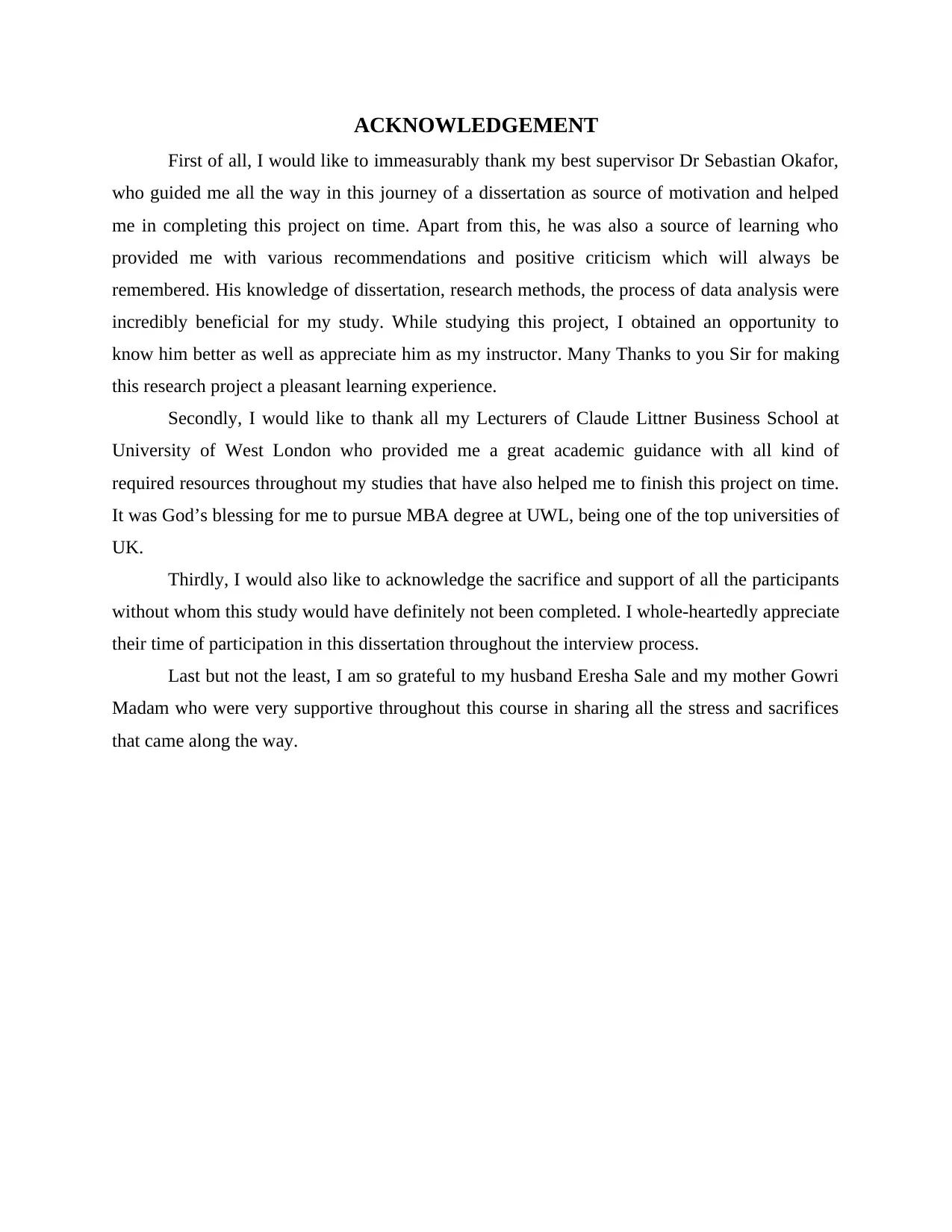
ACKNOWLEDGEMENT
First of all, I would like to immeasurably thank my best supervisor Dr Sebastian Okafor,
who guided me all the way in this journey of a dissertation as source of motivation and helped
me in completing this project on time. Apart from this, he was also a source of learning who
provided me with various recommendations and positive criticism which will always be
remembered. His knowledge of dissertation, research methods, the process of data analysis were
incredibly beneficial for my study. While studying this project, I obtained an opportunity to
know him better as well as appreciate him as my instructor. Many Thanks to you Sir for making
this research project a pleasant learning experience.
Secondly, I would like to thank all my Lecturers of Claude Littner Business School at
University of West London who provided me a great academic guidance with all kind of
required resources throughout my studies that have also helped me to finish this project on time.
It was God’s blessing for me to pursue MBA degree at UWL, being one of the top universities of
UK.
Thirdly, I would also like to acknowledge the sacrifice and support of all the participants
without whom this study would have definitely not been completed. I whole-heartedly appreciate
their time of participation in this dissertation throughout the interview process.
Last but not the least, I am so grateful to my husband Eresha Sale and my mother Gowri
Madam who were very supportive throughout this course in sharing all the stress and sacrifices
that came along the way.
First of all, I would like to immeasurably thank my best supervisor Dr Sebastian Okafor,
who guided me all the way in this journey of a dissertation as source of motivation and helped
me in completing this project on time. Apart from this, he was also a source of learning who
provided me with various recommendations and positive criticism which will always be
remembered. His knowledge of dissertation, research methods, the process of data analysis were
incredibly beneficial for my study. While studying this project, I obtained an opportunity to
know him better as well as appreciate him as my instructor. Many Thanks to you Sir for making
this research project a pleasant learning experience.
Secondly, I would like to thank all my Lecturers of Claude Littner Business School at
University of West London who provided me a great academic guidance with all kind of
required resources throughout my studies that have also helped me to finish this project on time.
It was God’s blessing for me to pursue MBA degree at UWL, being one of the top universities of
UK.
Thirdly, I would also like to acknowledge the sacrifice and support of all the participants
without whom this study would have definitely not been completed. I whole-heartedly appreciate
their time of participation in this dissertation throughout the interview process.
Last but not the least, I am so grateful to my husband Eresha Sale and my mother Gowri
Madam who were very supportive throughout this course in sharing all the stress and sacrifices
that came along the way.
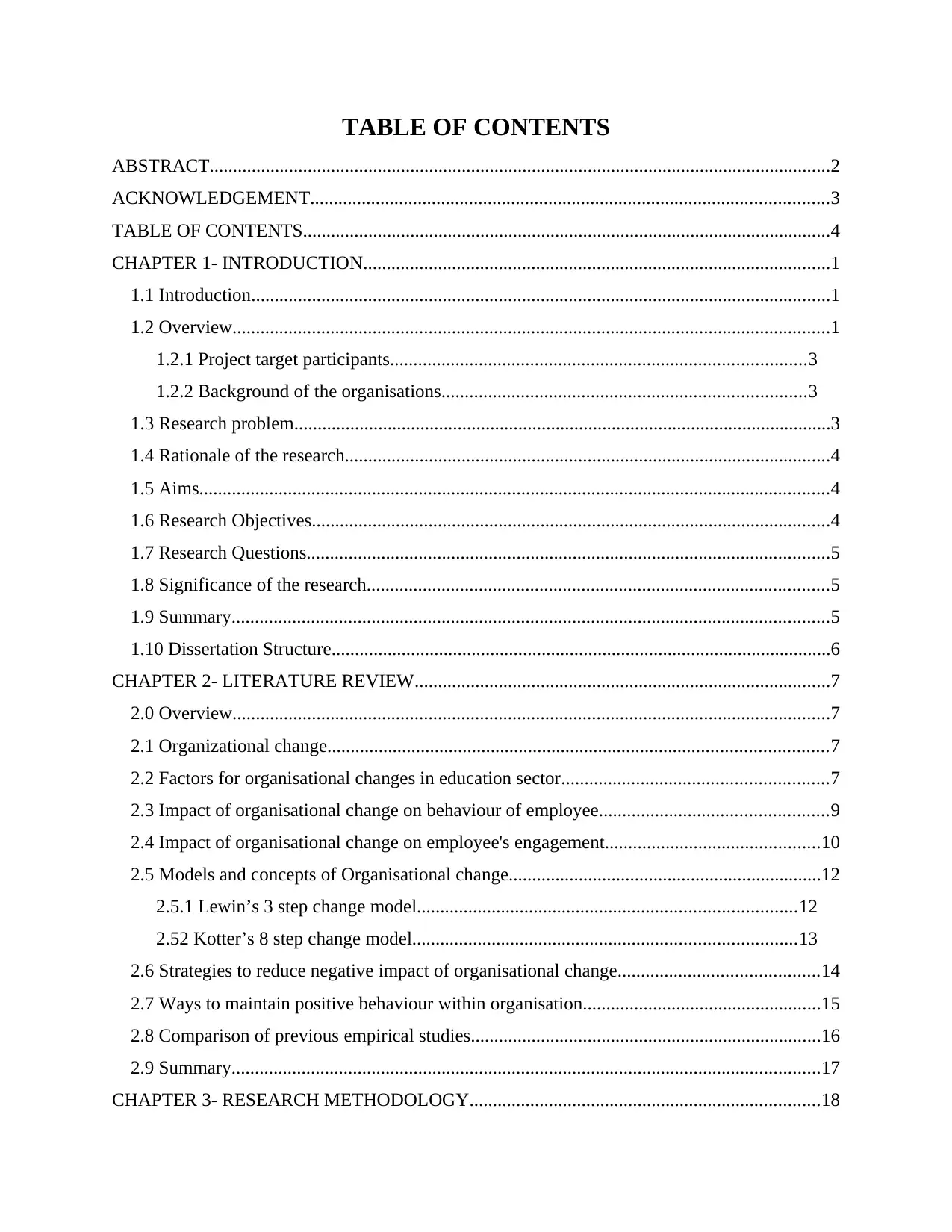
TABLE OF CONTENTS
ABSTRACT.....................................................................................................................................2
ACKNOWLEDGEMENT...............................................................................................................3
TABLE OF CONTENTS.................................................................................................................4
CHAPTER 1- INTRODUCTION....................................................................................................1
1.1 Introduction............................................................................................................................1
1.2 Overview................................................................................................................................1
1.2.1 Project target participants.........................................................................................3
1.2.2 Background of the organisations..............................................................................3
1.3 Research problem...................................................................................................................3
1.4 Rationale of the research........................................................................................................4
1.5 Aims.......................................................................................................................................4
1.6 Research Objectives...............................................................................................................4
1.7 Research Questions................................................................................................................5
1.8 Significance of the research...................................................................................................5
1.9 Summary................................................................................................................................5
1.10 Dissertation Structure...........................................................................................................6
CHAPTER 2- LITERATURE REVIEW.........................................................................................7
2.0 Overview................................................................................................................................7
2.1 Organizational change...........................................................................................................7
2.2 Factors for organisational changes in education sector.........................................................7
2.3 Impact of organisational change on behaviour of employee.................................................9
2.4 Impact of organisational change on employee's engagement..............................................10
2.5 Models and concepts of Organisational change...................................................................12
2.5.1 Lewin’s 3 step change model.................................................................................12
2.52 Kotter’s 8 step change model..................................................................................13
2.6 Strategies to reduce negative impact of organisational change...........................................14
2.7 Ways to maintain positive behaviour within organisation...................................................15
2.8 Comparison of previous empirical studies...........................................................................16
2.9 Summary..............................................................................................................................17
CHAPTER 3- RESEARCH METHODOLOGY...........................................................................18
ABSTRACT.....................................................................................................................................2
ACKNOWLEDGEMENT...............................................................................................................3
TABLE OF CONTENTS.................................................................................................................4
CHAPTER 1- INTRODUCTION....................................................................................................1
1.1 Introduction............................................................................................................................1
1.2 Overview................................................................................................................................1
1.2.1 Project target participants.........................................................................................3
1.2.2 Background of the organisations..............................................................................3
1.3 Research problem...................................................................................................................3
1.4 Rationale of the research........................................................................................................4
1.5 Aims.......................................................................................................................................4
1.6 Research Objectives...............................................................................................................4
1.7 Research Questions................................................................................................................5
1.8 Significance of the research...................................................................................................5
1.9 Summary................................................................................................................................5
1.10 Dissertation Structure...........................................................................................................6
CHAPTER 2- LITERATURE REVIEW.........................................................................................7
2.0 Overview................................................................................................................................7
2.1 Organizational change...........................................................................................................7
2.2 Factors for organisational changes in education sector.........................................................7
2.3 Impact of organisational change on behaviour of employee.................................................9
2.4 Impact of organisational change on employee's engagement..............................................10
2.5 Models and concepts of Organisational change...................................................................12
2.5.1 Lewin’s 3 step change model.................................................................................12
2.52 Kotter’s 8 step change model..................................................................................13
2.6 Strategies to reduce negative impact of organisational change...........................................14
2.7 Ways to maintain positive behaviour within organisation...................................................15
2.8 Comparison of previous empirical studies...........................................................................16
2.9 Summary..............................................................................................................................17
CHAPTER 3- RESEARCH METHODOLOGY...........................................................................18
Secure Best Marks with AI Grader
Need help grading? Try our AI Grader for instant feedback on your assignments.
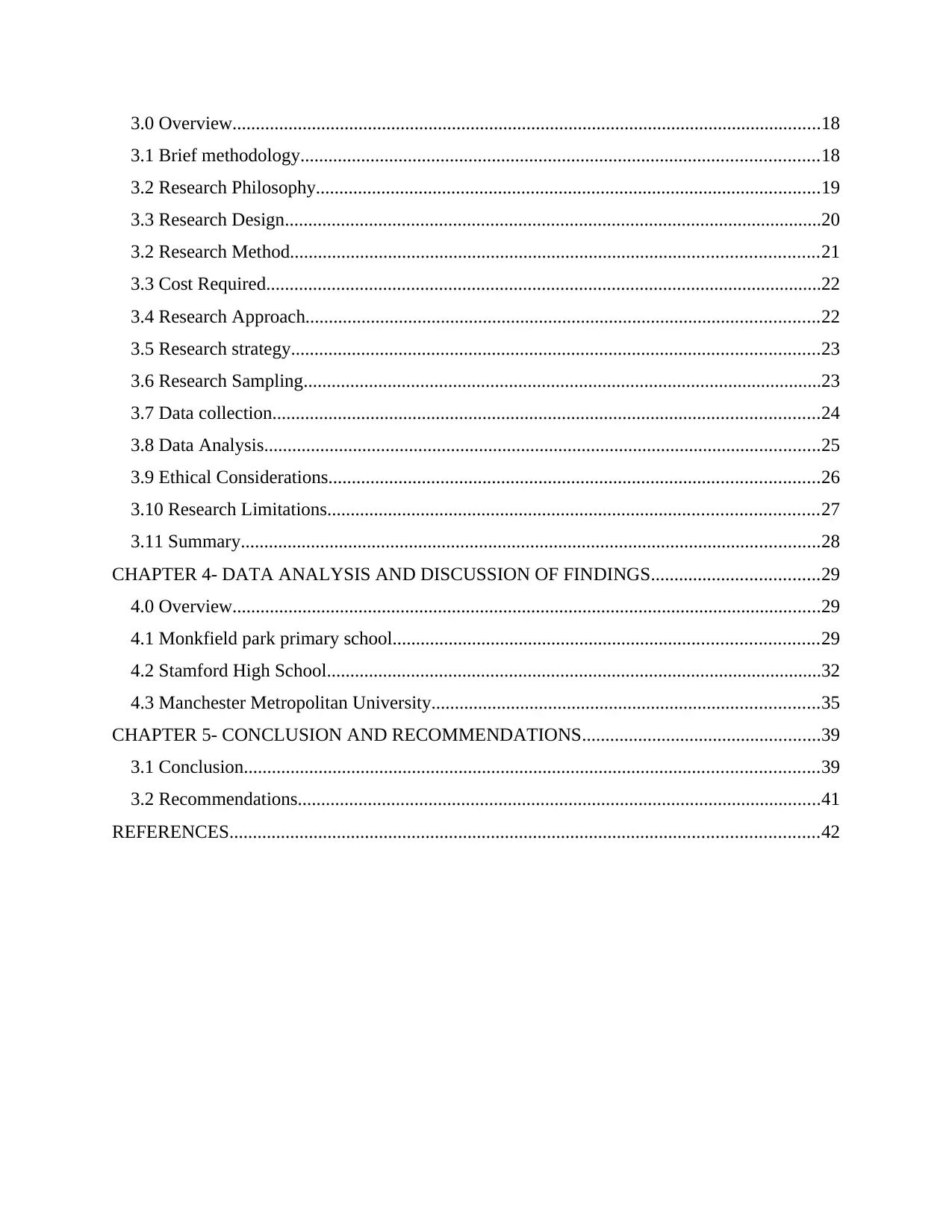
3.0 Overview..............................................................................................................................18
3.1 Brief methodology...............................................................................................................18
3.2 Research Philosophy............................................................................................................19
3.3 Research Design...................................................................................................................20
3.2 Research Method.................................................................................................................21
3.3 Cost Required.......................................................................................................................22
3.4 Research Approach..............................................................................................................22
3.5 Research strategy.................................................................................................................23
3.6 Research Sampling...............................................................................................................23
3.7 Data collection.....................................................................................................................24
3.8 Data Analysis.......................................................................................................................25
3.9 Ethical Considerations.........................................................................................................26
3.10 Research Limitations.........................................................................................................27
3.11 Summary............................................................................................................................28
CHAPTER 4- DATA ANALYSIS AND DISCUSSION OF FINDINGS....................................29
4.0 Overview..............................................................................................................................29
4.1 Monkfield park primary school...........................................................................................29
4.2 Stamford High School..........................................................................................................32
4.3 Manchester Metropolitan University...................................................................................35
CHAPTER 5- CONCLUSION AND RECOMMENDATIONS...................................................39
3.1 Conclusion...........................................................................................................................39
3.2 Recommendations................................................................................................................41
REFERENCES..............................................................................................................................42
3.1 Brief methodology...............................................................................................................18
3.2 Research Philosophy............................................................................................................19
3.3 Research Design...................................................................................................................20
3.2 Research Method.................................................................................................................21
3.3 Cost Required.......................................................................................................................22
3.4 Research Approach..............................................................................................................22
3.5 Research strategy.................................................................................................................23
3.6 Research Sampling...............................................................................................................23
3.7 Data collection.....................................................................................................................24
3.8 Data Analysis.......................................................................................................................25
3.9 Ethical Considerations.........................................................................................................26
3.10 Research Limitations.........................................................................................................27
3.11 Summary............................................................................................................................28
CHAPTER 4- DATA ANALYSIS AND DISCUSSION OF FINDINGS....................................29
4.0 Overview..............................................................................................................................29
4.1 Monkfield park primary school...........................................................................................29
4.2 Stamford High School..........................................................................................................32
4.3 Manchester Metropolitan University...................................................................................35
CHAPTER 5- CONCLUSION AND RECOMMENDATIONS...................................................39
3.1 Conclusion...........................................................................................................................39
3.2 Recommendations................................................................................................................41
REFERENCES..............................................................................................................................42

CHAPTER 1- INTRODUCTION
1.1 Introduction
This research investigates the unique impact of organisational change on the behaviour of
employees in the Educational sector. This research will be cased on Case studies of the
University, Secondary school and Primary school in the UK.
1.2 Overview
The educational sector holds a unique position both within developed and developing
countries. It not only plays a crucial role in the overall literacy rate of the nation, but it is a
source of social justice by decreasing poverty and inequality while providing the economy with
an educated workforce (Abeysekera and Dawson, 2015). It not only plays a vital role in the
country’s economy, also plays a crucial role in overall literacy rate of the nation. This sector can
be broadly categorised into three groups: schools (including pre-primary, primary and secondary
schools and colleges), universities and training institutions such as industry/job-oriented
education (Hatch, Morrison and Secker, 2017). It is very essential for the overall growth of the
country, there are various government rules, regulations and guidelines that are important for
each and every school and university to adhere. These guidelines include various teaching
techniques, course materials which are necessary and used to be taught to the students by the
universities and schools, because the students are the ones who will be learning and gaining
knowledge from these organisations. All countries have different kind of educational structure
depending or according to their government guidelines, based on this they have defined their
own educational framework (Van der Voet and Vermeeren, 2017).
All the organisations within the educational sector have different level of structure that
increases their flexibility (O'Brien and Pipkin, 2017). It further helps the organisation to maintain
a positive culture within their university or school. This positive culture helps the individuals in
gaining required information or knowledge so that students can learn in an efficient and effective
manner. However, this positive culture and gaining of knowledge completely depends upon the
employees so called- professors and teachers of the organisation (Alharbi and et.al., 2019). Any
changes within the structure of the organisation will impact on its positive culture which will
further directly or indirectly impact on the behaviour of all the employees especially in education
sector. This change in structure or technology etc. can have a huge impact on overall
1
1.1 Introduction
This research investigates the unique impact of organisational change on the behaviour of
employees in the Educational sector. This research will be cased on Case studies of the
University, Secondary school and Primary school in the UK.
1.2 Overview
The educational sector holds a unique position both within developed and developing
countries. It not only plays a crucial role in the overall literacy rate of the nation, but it is a
source of social justice by decreasing poverty and inequality while providing the economy with
an educated workforce (Abeysekera and Dawson, 2015). It not only plays a vital role in the
country’s economy, also plays a crucial role in overall literacy rate of the nation. This sector can
be broadly categorised into three groups: schools (including pre-primary, primary and secondary
schools and colleges), universities and training institutions such as industry/job-oriented
education (Hatch, Morrison and Secker, 2017). It is very essential for the overall growth of the
country, there are various government rules, regulations and guidelines that are important for
each and every school and university to adhere. These guidelines include various teaching
techniques, course materials which are necessary and used to be taught to the students by the
universities and schools, because the students are the ones who will be learning and gaining
knowledge from these organisations. All countries have different kind of educational structure
depending or according to their government guidelines, based on this they have defined their
own educational framework (Van der Voet and Vermeeren, 2017).
All the organisations within the educational sector have different level of structure that
increases their flexibility (O'Brien and Pipkin, 2017). It further helps the organisation to maintain
a positive culture within their university or school. This positive culture helps the individuals in
gaining required information or knowledge so that students can learn in an efficient and effective
manner. However, this positive culture and gaining of knowledge completely depends upon the
employees so called- professors and teachers of the organisation (Alharbi and et.al., 2019). Any
changes within the structure of the organisation will impact on its positive culture which will
further directly or indirectly impact on the behaviour of all the employees especially in education
sector. This change in structure or technology etc. can have a huge impact on overall
1

performance of the employees, their work engagement within the organisation, their behaviour
towards their colleagues, towards the way of teaching etc (Denis, ferlie and van gestel, 2015).
Organisational change can be defined as a change in organisation’s culture, structure,
procedures, processes and technology (Budd, 2017). These changes within the company directly
will impact the overall performance of the organisation. These organisational changes are quite
important to be observed and maintained, especially in the educational sector, as impact of such
changes can be either positive or negative. These changes could further impact on the behaviour
of the employees of any university or schools and also can have effect on the way of their
teaching style. Success and failure of an organisation are the main reasons of organisational
change that impacts on the overall performance of the employees (Arokiasamy and et.al., 2016).
The result of failure or success in the organisation's strategies, technologies, systems etc can
either increase the flexibility of the organisation or can decrease their work efficiency. Thereby,
positive culture within the universities or schools will either increase or decrease.
These changes are mostly seen and are required in universities, colleges or schools so that
their knowledge level can be increased by bringing some changes within the employees of the
schools and university. It is important to be noticed that these changes can impact an
organisation both positively and negatively which completely depends upon the type of changes
that has been done. So, all the changes are brought within the organisation should be verified
before implementing as it can reduce the overall efficiency of an employee, can negatively
impact their behaviour and might not be able to cope up with those changes (Denis, Ferlie and
Van Gestel, 2015). Verification of such changes can be measured by implementing several
strategies and measuring their impact on the organisation, implementing mitigation strategies etc.
In educational sector these changes can influence overall level of education within the
organisation, enhance or degrade work performance of the employees in order to attain higher
goals and objectives and if changes are not implemented correctly it can make it much difficult
for the organisation to attain and achieve their goals, objectives or targets that can bring changes
in leadership or in roles, due to which the external support will also be impacted. As a result,
complexity within the organisation will either decrease or increase (Avidov-Ungar, 2015). So, in
order to increase employee engagement, enhance their performance, bring positive changes
within their behaviour, for which it is important to know the factors due to which organisational
changes are brought and impacts they have on the organisation’s performance.
2
towards their colleagues, towards the way of teaching etc (Denis, ferlie and van gestel, 2015).
Organisational change can be defined as a change in organisation’s culture, structure,
procedures, processes and technology (Budd, 2017). These changes within the company directly
will impact the overall performance of the organisation. These organisational changes are quite
important to be observed and maintained, especially in the educational sector, as impact of such
changes can be either positive or negative. These changes could further impact on the behaviour
of the employees of any university or schools and also can have effect on the way of their
teaching style. Success and failure of an organisation are the main reasons of organisational
change that impacts on the overall performance of the employees (Arokiasamy and et.al., 2016).
The result of failure or success in the organisation's strategies, technologies, systems etc can
either increase the flexibility of the organisation or can decrease their work efficiency. Thereby,
positive culture within the universities or schools will either increase or decrease.
These changes are mostly seen and are required in universities, colleges or schools so that
their knowledge level can be increased by bringing some changes within the employees of the
schools and university. It is important to be noticed that these changes can impact an
organisation both positively and negatively which completely depends upon the type of changes
that has been done. So, all the changes are brought within the organisation should be verified
before implementing as it can reduce the overall efficiency of an employee, can negatively
impact their behaviour and might not be able to cope up with those changes (Denis, Ferlie and
Van Gestel, 2015). Verification of such changes can be measured by implementing several
strategies and measuring their impact on the organisation, implementing mitigation strategies etc.
In educational sector these changes can influence overall level of education within the
organisation, enhance or degrade work performance of the employees in order to attain higher
goals and objectives and if changes are not implemented correctly it can make it much difficult
for the organisation to attain and achieve their goals, objectives or targets that can bring changes
in leadership or in roles, due to which the external support will also be impacted. As a result,
complexity within the organisation will either decrease or increase (Avidov-Ungar, 2015). So, in
order to increase employee engagement, enhance their performance, bring positive changes
within their behaviour, for which it is important to know the factors due to which organisational
changes are brought and impacts they have on the organisation’s performance.
2
Paraphrase This Document
Need a fresh take? Get an instant paraphrase of this document with our AI Paraphraser
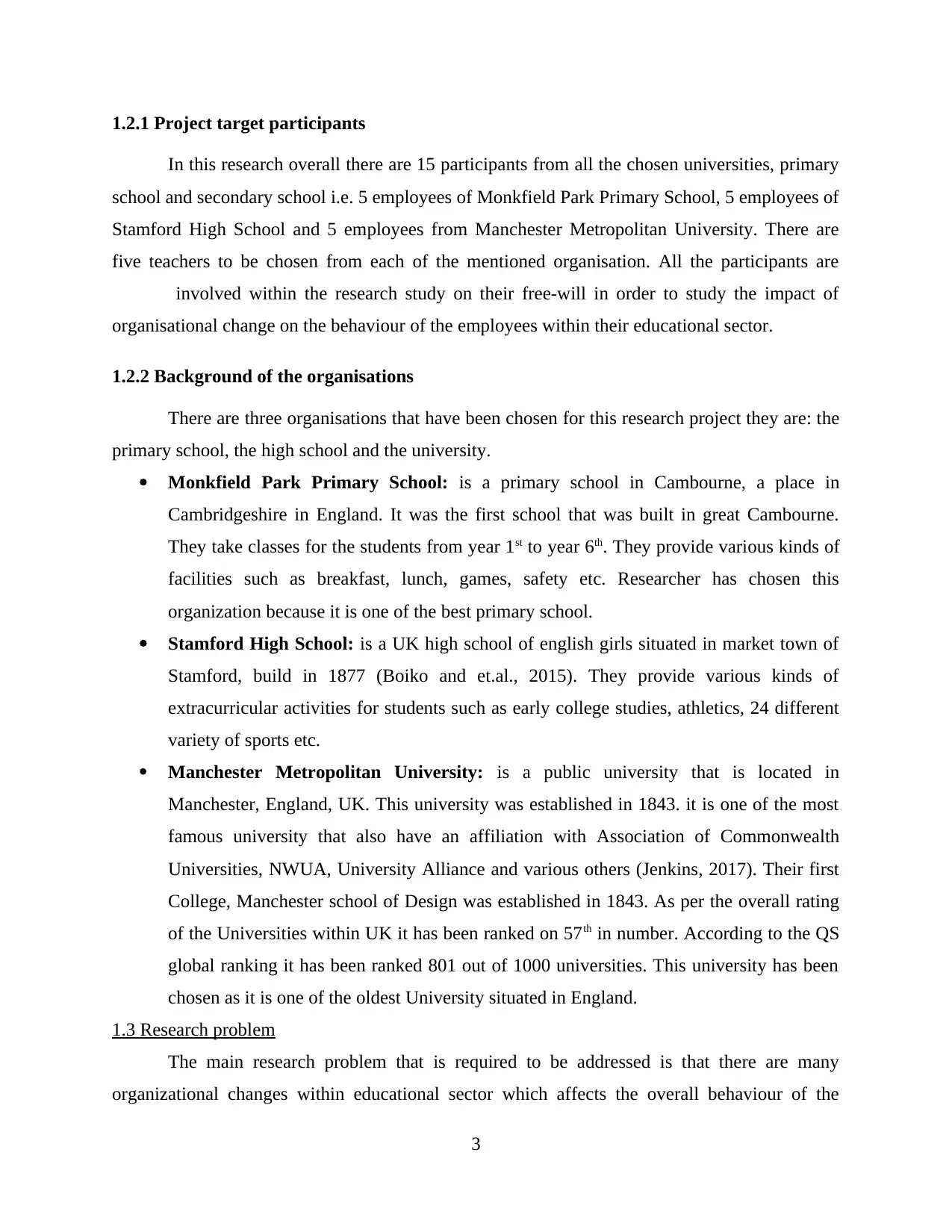
1.2.1 Project target participants
In this research overall there are 15 participants from all the chosen universities, primary
school and secondary school i.e. 5 employees of Monkfield Park Primary School, 5 employees of
Stamford High School and 5 employees from Manchester Metropolitan University. There are
five teachers to be chosen from each of the mentioned organisation. All the participants are
involved within the research study on their free-will in order to study the impact of
organisational change on the behaviour of the employees within their educational sector.
1.2.2 Background of the organisations
There are three organisations that have been chosen for this research project they are: the
primary school, the high school and the university.
Monkfield Park Primary School: is a primary school in Cambourne, a place in
Cambridgeshire in England. It was the first school that was built in great Cambourne.
They take classes for the students from year 1st to year 6th. They provide various kinds of
facilities such as breakfast, lunch, games, safety etc. Researcher has chosen this
organization because it is one of the best primary school.
Stamford High School: is a UK high school of english girls situated in market town of
Stamford, build in 1877 (Boiko and et.al., 2015). They provide various kinds of
extracurricular activities for students such as early college studies, athletics, 24 different
variety of sports etc.
Manchester Metropolitan University: is a public university that is located in
Manchester, England, UK. This university was established in 1843. it is one of the most
famous university that also have an affiliation with Association of Commonwealth
Universities, NWUA, University Alliance and various others (Jenkins, 2017). Their first
College, Manchester school of Design was established in 1843. As per the overall rating
of the Universities within UK it has been ranked on 57th in number. According to the QS
global ranking it has been ranked 801 out of 1000 universities. This university has been
chosen as it is one of the oldest University situated in England.
1.3 Research problem
The main research problem that is required to be addressed is that there are many
organizational changes within educational sector which affects the overall behaviour of the
3
In this research overall there are 15 participants from all the chosen universities, primary
school and secondary school i.e. 5 employees of Monkfield Park Primary School, 5 employees of
Stamford High School and 5 employees from Manchester Metropolitan University. There are
five teachers to be chosen from each of the mentioned organisation. All the participants are
involved within the research study on their free-will in order to study the impact of
organisational change on the behaviour of the employees within their educational sector.
1.2.2 Background of the organisations
There are three organisations that have been chosen for this research project they are: the
primary school, the high school and the university.
Monkfield Park Primary School: is a primary school in Cambourne, a place in
Cambridgeshire in England. It was the first school that was built in great Cambourne.
They take classes for the students from year 1st to year 6th. They provide various kinds of
facilities such as breakfast, lunch, games, safety etc. Researcher has chosen this
organization because it is one of the best primary school.
Stamford High School: is a UK high school of english girls situated in market town of
Stamford, build in 1877 (Boiko and et.al., 2015). They provide various kinds of
extracurricular activities for students such as early college studies, athletics, 24 different
variety of sports etc.
Manchester Metropolitan University: is a public university that is located in
Manchester, England, UK. This university was established in 1843. it is one of the most
famous university that also have an affiliation with Association of Commonwealth
Universities, NWUA, University Alliance and various others (Jenkins, 2017). Their first
College, Manchester school of Design was established in 1843. As per the overall rating
of the Universities within UK it has been ranked on 57th in number. According to the QS
global ranking it has been ranked 801 out of 1000 universities. This university has been
chosen as it is one of the oldest University situated in England.
1.3 Research problem
The main research problem that is required to be addressed is that there are many
organizational changes within educational sector which affects the overall behaviour of the
3
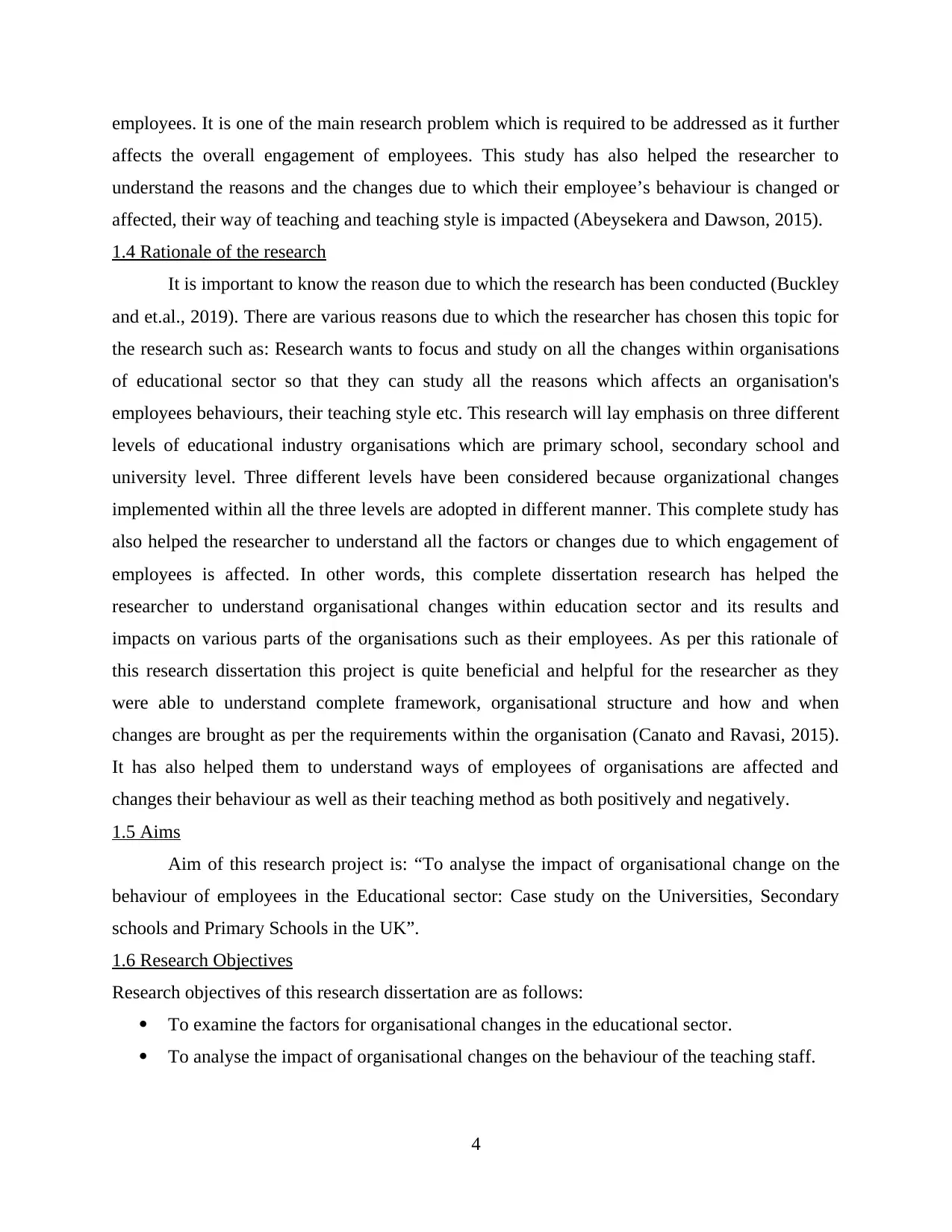
employees. It is one of the main research problem which is required to be addressed as it further
affects the overall engagement of employees. This study has also helped the researcher to
understand the reasons and the changes due to which their employee’s behaviour is changed or
affected, their way of teaching and teaching style is impacted (Abeysekera and Dawson, 2015).
1.4 Rationale of the research
It is important to know the reason due to which the research has been conducted (Buckley
and et.al., 2019). There are various reasons due to which the researcher has chosen this topic for
the research such as: Research wants to focus and study on all the changes within organisations
of educational sector so that they can study all the reasons which affects an organisation's
employees behaviours, their teaching style etc. This research will lay emphasis on three different
levels of educational industry organisations which are primary school, secondary school and
university level. Three different levels have been considered because organizational changes
implemented within all the three levels are adopted in different manner. This complete study has
also helped the researcher to understand all the factors or changes due to which engagement of
employees is affected. In other words, this complete dissertation research has helped the
researcher to understand organisational changes within education sector and its results and
impacts on various parts of the organisations such as their employees. As per this rationale of
this research dissertation this project is quite beneficial and helpful for the researcher as they
were able to understand complete framework, organisational structure and how and when
changes are brought as per the requirements within the organisation (Canato and Ravasi, 2015).
It has also helped them to understand ways of employees of organisations are affected and
changes their behaviour as well as their teaching method as both positively and negatively.
1.5 Aims
Aim of this research project is: “To analyse the impact of organisational change on the
behaviour of employees in the Educational sector: Case study on the Universities, Secondary
schools and Primary Schools in the UK”.
1.6 Research Objectives
Research objectives of this research dissertation are as follows:
To examine the factors for organisational changes in the educational sector.
To analyse the impact of organisational changes on the behaviour of the teaching staff.
4
affects the overall engagement of employees. This study has also helped the researcher to
understand the reasons and the changes due to which their employee’s behaviour is changed or
affected, their way of teaching and teaching style is impacted (Abeysekera and Dawson, 2015).
1.4 Rationale of the research
It is important to know the reason due to which the research has been conducted (Buckley
and et.al., 2019). There are various reasons due to which the researcher has chosen this topic for
the research such as: Research wants to focus and study on all the changes within organisations
of educational sector so that they can study all the reasons which affects an organisation's
employees behaviours, their teaching style etc. This research will lay emphasis on three different
levels of educational industry organisations which are primary school, secondary school and
university level. Three different levels have been considered because organizational changes
implemented within all the three levels are adopted in different manner. This complete study has
also helped the researcher to understand all the factors or changes due to which engagement of
employees is affected. In other words, this complete dissertation research has helped the
researcher to understand organisational changes within education sector and its results and
impacts on various parts of the organisations such as their employees. As per this rationale of
this research dissertation this project is quite beneficial and helpful for the researcher as they
were able to understand complete framework, organisational structure and how and when
changes are brought as per the requirements within the organisation (Canato and Ravasi, 2015).
It has also helped them to understand ways of employees of organisations are affected and
changes their behaviour as well as their teaching method as both positively and negatively.
1.5 Aims
Aim of this research project is: “To analyse the impact of organisational change on the
behaviour of employees in the Educational sector: Case study on the Universities, Secondary
schools and Primary Schools in the UK”.
1.6 Research Objectives
Research objectives of this research dissertation are as follows:
To examine the factors for organisational changes in the educational sector.
To analyse the impact of organisational changes on the behaviour of the teaching staff.
4
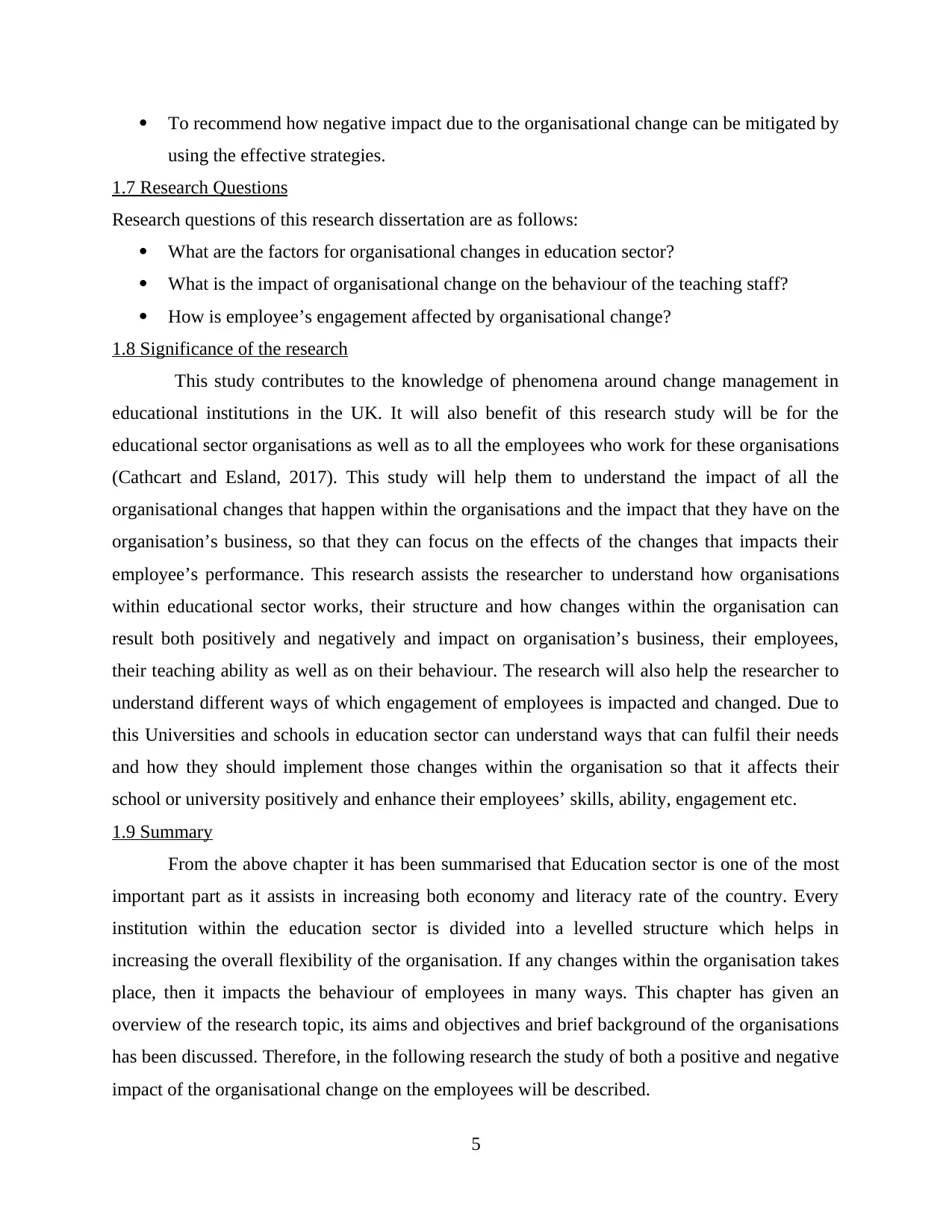
To recommend how negative impact due to the organisational change can be mitigated by
using the effective strategies.
1.7 Research Questions
Research questions of this research dissertation are as follows:
What are the factors for organisational changes in education sector?
What is the impact of organisational change on the behaviour of the teaching staff?
How is employee’s engagement affected by organisational change?
1.8 Significance of the research
This study contributes to the knowledge of phenomena around change management in
educational institutions in the UK. It will also benefit of this research study will be for the
educational sector organisations as well as to all the employees who work for these organisations
(Cathcart and Esland, 2017). This study will help them to understand the impact of all the
organisational changes that happen within the organisations and the impact that they have on the
organisation’s business, so that they can focus on the effects of the changes that impacts their
employee’s performance. This research assists the researcher to understand how organisations
within educational sector works, their structure and how changes within the organisation can
result both positively and negatively and impact on organisation’s business, their employees,
their teaching ability as well as on their behaviour. The research will also help the researcher to
understand different ways of which engagement of employees is impacted and changed. Due to
this Universities and schools in education sector can understand ways that can fulfil their needs
and how they should implement those changes within the organisation so that it affects their
school or university positively and enhance their employees’ skills, ability, engagement etc.
1.9 Summary
From the above chapter it has been summarised that Education sector is one of the most
important part as it assists in increasing both economy and literacy rate of the country. Every
institution within the education sector is divided into a levelled structure which helps in
increasing the overall flexibility of the organisation. If any changes within the organisation takes
place, then it impacts the behaviour of employees in many ways. This chapter has given an
overview of the research topic, its aims and objectives and brief background of the organisations
has been discussed. Therefore, in the following research the study of both a positive and negative
impact of the organisational change on the employees will be described.
5
using the effective strategies.
1.7 Research Questions
Research questions of this research dissertation are as follows:
What are the factors for organisational changes in education sector?
What is the impact of organisational change on the behaviour of the teaching staff?
How is employee’s engagement affected by organisational change?
1.8 Significance of the research
This study contributes to the knowledge of phenomena around change management in
educational institutions in the UK. It will also benefit of this research study will be for the
educational sector organisations as well as to all the employees who work for these organisations
(Cathcart and Esland, 2017). This study will help them to understand the impact of all the
organisational changes that happen within the organisations and the impact that they have on the
organisation’s business, so that they can focus on the effects of the changes that impacts their
employee’s performance. This research assists the researcher to understand how organisations
within educational sector works, their structure and how changes within the organisation can
result both positively and negatively and impact on organisation’s business, their employees,
their teaching ability as well as on their behaviour. The research will also help the researcher to
understand different ways of which engagement of employees is impacted and changed. Due to
this Universities and schools in education sector can understand ways that can fulfil their needs
and how they should implement those changes within the organisation so that it affects their
school or university positively and enhance their employees’ skills, ability, engagement etc.
1.9 Summary
From the above chapter it has been summarised that Education sector is one of the most
important part as it assists in increasing both economy and literacy rate of the country. Every
institution within the education sector is divided into a levelled structure which helps in
increasing the overall flexibility of the organisation. If any changes within the organisation takes
place, then it impacts the behaviour of employees in many ways. This chapter has given an
overview of the research topic, its aims and objectives and brief background of the organisations
has been discussed. Therefore, in the following research the study of both a positive and negative
impact of the organisational change on the employees will be described.
5
Secure Best Marks with AI Grader
Need help grading? Try our AI Grader for instant feedback on your assignments.
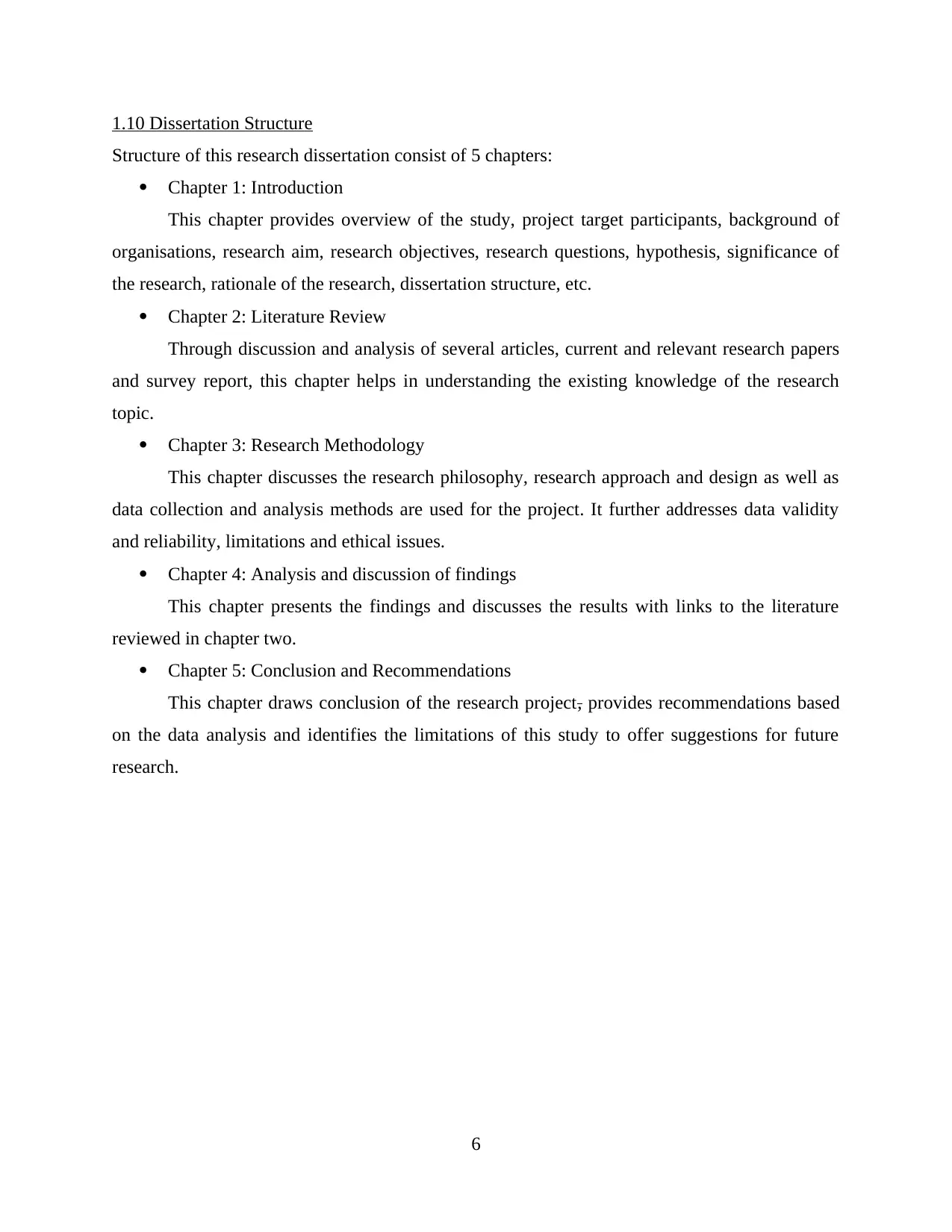
1.10 Dissertation Structure
Structure of this research dissertation consist of 5 chapters:
Chapter 1: Introduction
This chapter provides overview of the study, project target participants, background of
organisations, research aim, research objectives, research questions, hypothesis, significance of
the research, rationale of the research, dissertation structure, etc.
Chapter 2: Literature Review
Through discussion and analysis of several articles, current and relevant research papers
and survey report, this chapter helps in understanding the existing knowledge of the research
topic.
Chapter 3: Research Methodology
This chapter discusses the research philosophy, research approach and design as well as
data collection and analysis methods are used for the project. It further addresses data validity
and reliability, limitations and ethical issues.
Chapter 4: Analysis and discussion of findings
This chapter presents the findings and discusses the results with links to the literature
reviewed in chapter two.
Chapter 5: Conclusion and Recommendations
This chapter draws conclusion of the research project, provides recommendations based
on the data analysis and identifies the limitations of this study to offer suggestions for future
research.
6
Structure of this research dissertation consist of 5 chapters:
Chapter 1: Introduction
This chapter provides overview of the study, project target participants, background of
organisations, research aim, research objectives, research questions, hypothesis, significance of
the research, rationale of the research, dissertation structure, etc.
Chapter 2: Literature Review
Through discussion and analysis of several articles, current and relevant research papers
and survey report, this chapter helps in understanding the existing knowledge of the research
topic.
Chapter 3: Research Methodology
This chapter discusses the research philosophy, research approach and design as well as
data collection and analysis methods are used for the project. It further addresses data validity
and reliability, limitations and ethical issues.
Chapter 4: Analysis and discussion of findings
This chapter presents the findings and discusses the results with links to the literature
reviewed in chapter two.
Chapter 5: Conclusion and Recommendations
This chapter draws conclusion of the research project, provides recommendations based
on the data analysis and identifies the limitations of this study to offer suggestions for future
research.
6
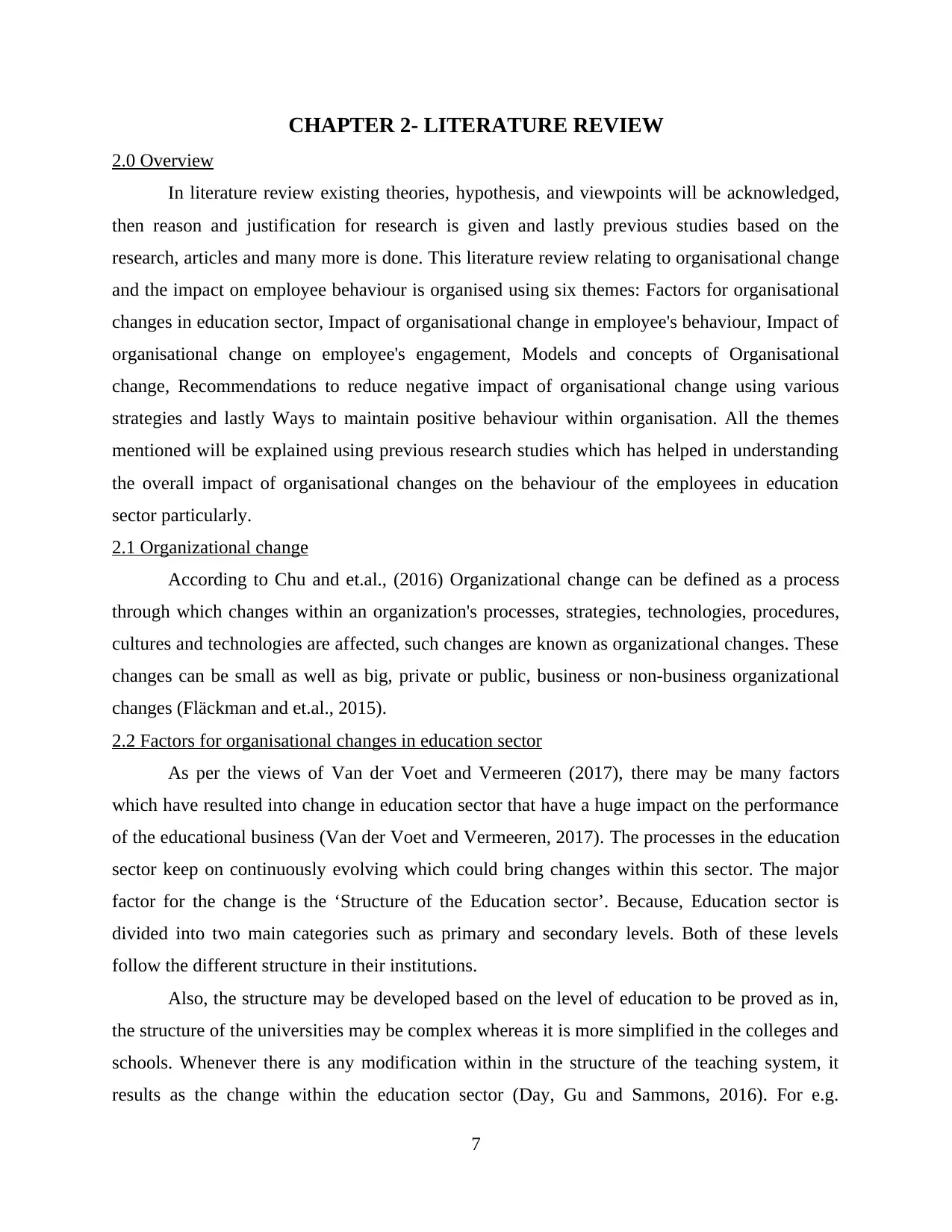
CHAPTER 2- LITERATURE REVIEW
2.0 Overview
In literature review existing theories, hypothesis, and viewpoints will be acknowledged,
then reason and justification for research is given and lastly previous studies based on the
research, articles and many more is done. This literature review relating to organisational change
and the impact on employee behaviour is organised using six themes: Factors for organisational
changes in education sector, Impact of organisational change in employee's behaviour, Impact of
organisational change on employee's engagement, Models and concepts of Organisational
change, Recommendations to reduce negative impact of organisational change using various
strategies and lastly Ways to maintain positive behaviour within organisation. All the themes
mentioned will be explained using previous research studies which has helped in understanding
the overall impact of organisational changes on the behaviour of the employees in education
sector particularly.
2.1 Organizational change
According to Chu and et.al., (2016) Organizational change can be defined as a process
through which changes within an organization's processes, strategies, technologies, procedures,
cultures and technologies are affected, such changes are known as organizational changes. These
changes can be small as well as big, private or public, business or non-business organizational
changes (Fläckman and et.al., 2015).
2.2 Factors for organisational changes in education sector
As per the views of Van der Voet and Vermeeren (2017), there may be many factors
which have resulted into change in education sector that have a huge impact on the performance
of the educational business (Van der Voet and Vermeeren, 2017). The processes in the education
sector keep on continuously evolving which could bring changes within this sector. The major
factor for the change is the ‘Structure of the Education sector’. Because, Education sector is
divided into two main categories such as primary and secondary levels. Both of these levels
follow the different structure in their institutions.
Also, the structure may be developed based on the level of education to be proved as in,
the structure of the universities may be complex whereas it is more simplified in the colleges and
schools. Whenever there is any modification within in the structure of the teaching system, it
results as the change within the education sector (Day, Gu and Sammons, 2016). For e.g.
7
2.0 Overview
In literature review existing theories, hypothesis, and viewpoints will be acknowledged,
then reason and justification for research is given and lastly previous studies based on the
research, articles and many more is done. This literature review relating to organisational change
and the impact on employee behaviour is organised using six themes: Factors for organisational
changes in education sector, Impact of organisational change in employee's behaviour, Impact of
organisational change on employee's engagement, Models and concepts of Organisational
change, Recommendations to reduce negative impact of organisational change using various
strategies and lastly Ways to maintain positive behaviour within organisation. All the themes
mentioned will be explained using previous research studies which has helped in understanding
the overall impact of organisational changes on the behaviour of the employees in education
sector particularly.
2.1 Organizational change
According to Chu and et.al., (2016) Organizational change can be defined as a process
through which changes within an organization's processes, strategies, technologies, procedures,
cultures and technologies are affected, such changes are known as organizational changes. These
changes can be small as well as big, private or public, business or non-business organizational
changes (Fläckman and et.al., 2015).
2.2 Factors for organisational changes in education sector
As per the views of Van der Voet and Vermeeren (2017), there may be many factors
which have resulted into change in education sector that have a huge impact on the performance
of the educational business (Van der Voet and Vermeeren, 2017). The processes in the education
sector keep on continuously evolving which could bring changes within this sector. The major
factor for the change is the ‘Structure of the Education sector’. Because, Education sector is
divided into two main categories such as primary and secondary levels. Both of these levels
follow the different structure in their institutions.
Also, the structure may be developed based on the level of education to be proved as in,
the structure of the universities may be complex whereas it is more simplified in the colleges and
schools. Whenever there is any modification within in the structure of the teaching system, it
results as the change within the education sector (Day, Gu and Sammons, 2016). For e.g.
7
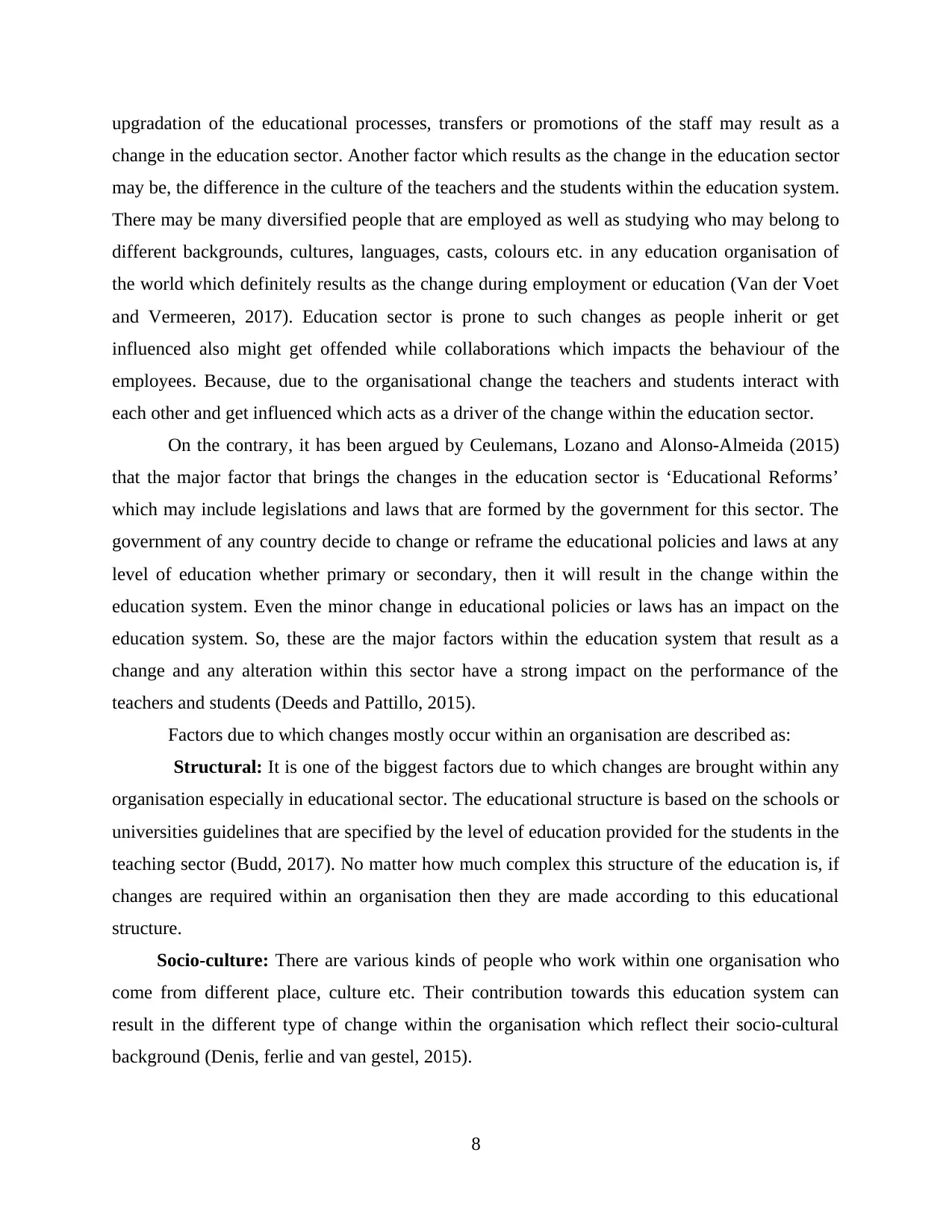
upgradation of the educational processes, transfers or promotions of the staff may result as a
change in the education sector. Another factor which results as the change in the education sector
may be, the difference in the culture of the teachers and the students within the education system.
There may be many diversified people that are employed as well as studying who may belong to
different backgrounds, cultures, languages, casts, colours etc. in any education organisation of
the world which definitely results as the change during employment or education (Van der Voet
and Vermeeren, 2017). Education sector is prone to such changes as people inherit or get
influenced also might get offended while collaborations which impacts the behaviour of the
employees. Because, due to the organisational change the teachers and students interact with
each other and get influenced which acts as a driver of the change within the education sector.
On the contrary, it has been argued by Ceulemans, Lozano and Alonso-Almeida (2015)
that the major factor that brings the changes in the education sector is ‘Educational Reforms’
which may include legislations and laws that are formed by the government for this sector. The
government of any country decide to change or reframe the educational policies and laws at any
level of education whether primary or secondary, then it will result in the change within the
education system. Even the minor change in educational policies or laws has an impact on the
education system. So, these are the major factors within the education system that result as a
change and any alteration within this sector have a strong impact on the performance of the
teachers and students (Deeds and Pattillo, 2015).
Factors due to which changes mostly occur within an organisation are described as:
Structural: It is one of the biggest factors due to which changes are brought within any
organisation especially in educational sector. The educational structure is based on the schools or
universities guidelines that are specified by the level of education provided for the students in the
teaching sector (Budd, 2017). No matter how much complex this structure of the education is, if
changes are required within an organisation then they are made according to this educational
structure.
Socio-culture: There are various kinds of people who work within one organisation who
come from different place, culture etc. Their contribution towards this education system can
result in the different type of change within the organisation which reflect their socio-cultural
background (Denis, ferlie and van gestel, 2015).
8
change in the education sector. Another factor which results as the change in the education sector
may be, the difference in the culture of the teachers and the students within the education system.
There may be many diversified people that are employed as well as studying who may belong to
different backgrounds, cultures, languages, casts, colours etc. in any education organisation of
the world which definitely results as the change during employment or education (Van der Voet
and Vermeeren, 2017). Education sector is prone to such changes as people inherit or get
influenced also might get offended while collaborations which impacts the behaviour of the
employees. Because, due to the organisational change the teachers and students interact with
each other and get influenced which acts as a driver of the change within the education sector.
On the contrary, it has been argued by Ceulemans, Lozano and Alonso-Almeida (2015)
that the major factor that brings the changes in the education sector is ‘Educational Reforms’
which may include legislations and laws that are formed by the government for this sector. The
government of any country decide to change or reframe the educational policies and laws at any
level of education whether primary or secondary, then it will result in the change within the
education system. Even the minor change in educational policies or laws has an impact on the
education system. So, these are the major factors within the education system that result as a
change and any alteration within this sector have a strong impact on the performance of the
teachers and students (Deeds and Pattillo, 2015).
Factors due to which changes mostly occur within an organisation are described as:
Structural: It is one of the biggest factors due to which changes are brought within any
organisation especially in educational sector. The educational structure is based on the schools or
universities guidelines that are specified by the level of education provided for the students in the
teaching sector (Budd, 2017). No matter how much complex this structure of the education is, if
changes are required within an organisation then they are made according to this educational
structure.
Socio-culture: There are various kinds of people who work within one organisation who
come from different place, culture etc. Their contribution towards this education system can
result in the different type of change within the organisation which reflect their socio-cultural
background (Denis, ferlie and van gestel, 2015).
8
Paraphrase This Document
Need a fresh take? Get an instant paraphrase of this document with our AI Paraphraser
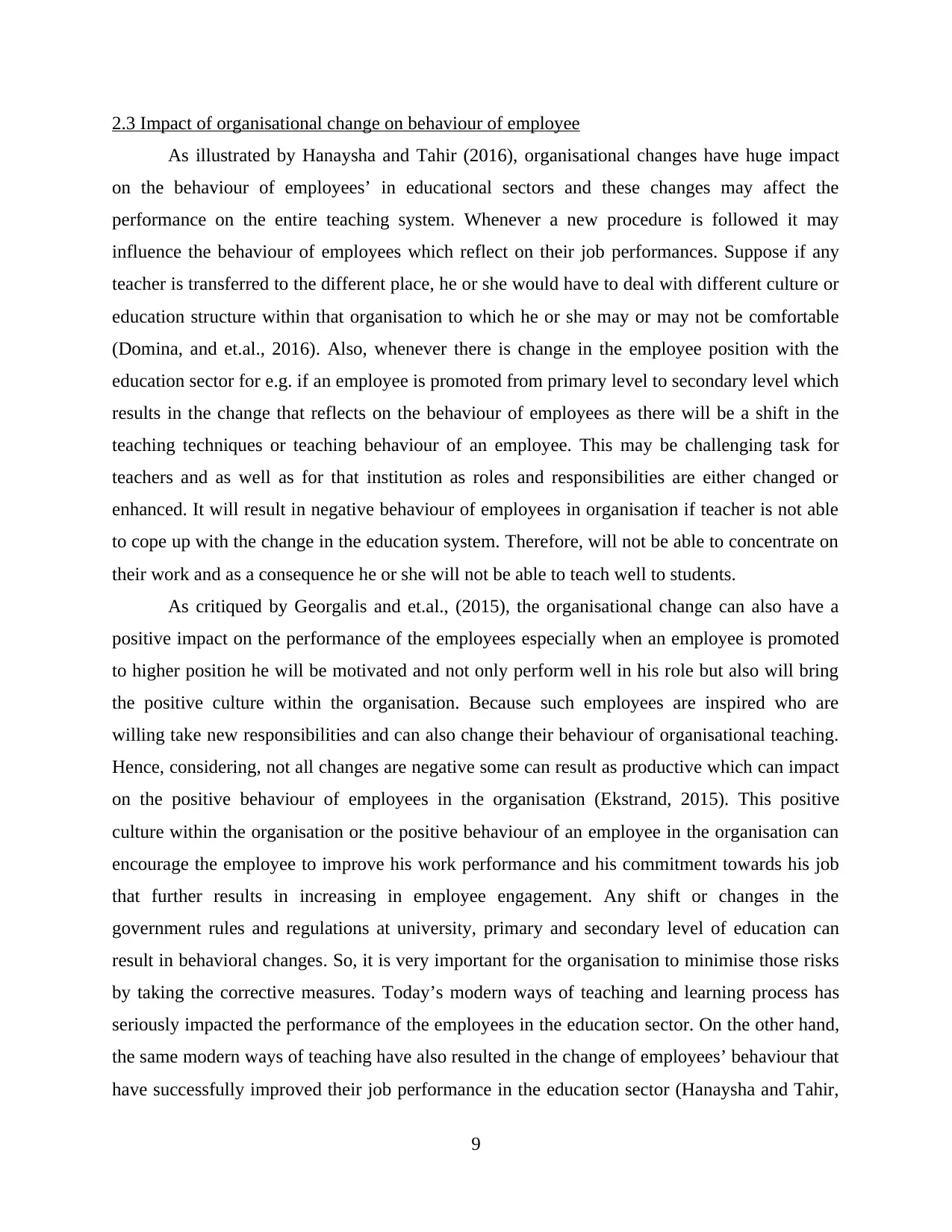
2.3 Impact of organisational change on behaviour of employee
As illustrated by Hanaysha and Tahir (2016), organisational changes have huge impact
on the behaviour of employees’ in educational sectors and these changes may affect the
performance on the entire teaching system. Whenever a new procedure is followed it may
influence the behaviour of employees which reflect on their job performances. Suppose if any
teacher is transferred to the different place, he or she would have to deal with different culture or
education structure within that organisation to which he or she may or may not be comfortable
(Domina, and et.al., 2016). Also, whenever there is change in the employee position with the
education sector for e.g. if an employee is promoted from primary level to secondary level which
results in the change that reflects on the behaviour of employees as there will be a shift in the
teaching techniques or teaching behaviour of an employee. This may be challenging task for
teachers and as well as for that institution as roles and responsibilities are either changed or
enhanced. It will result in negative behaviour of employees in organisation if teacher is not able
to cope up with the change in the education system. Therefore, will not be able to concentrate on
their work and as a consequence he or she will not be able to teach well to students.
As critiqued by Georgalis and et.al., (2015), the organisational change can also have a
positive impact on the performance of the employees especially when an employee is promoted
to higher position he will be motivated and not only perform well in his role but also will bring
the positive culture within the organisation. Because such employees are inspired who are
willing take new responsibilities and can also change their behaviour of organisational teaching.
Hence, considering, not all changes are negative some can result as productive which can impact
on the positive behaviour of employees in the organisation (Ekstrand, 2015). This positive
culture within the organisation or the positive behaviour of an employee in the organisation can
encourage the employee to improve his work performance and his commitment towards his job
that further results in increasing in employee engagement. Any shift or changes in the
government rules and regulations at university, primary and secondary level of education can
result in behavioral changes. So, it is very important for the organisation to minimise those risks
by taking the corrective measures. Today’s modern ways of teaching and learning process has
seriously impacted the performance of the employees in the education sector. On the other hand,
the same modern ways of teaching have also resulted in the change of employees’ behaviour that
have successfully improved their job performance in the education sector (Hanaysha and Tahir,
9
As illustrated by Hanaysha and Tahir (2016), organisational changes have huge impact
on the behaviour of employees’ in educational sectors and these changes may affect the
performance on the entire teaching system. Whenever a new procedure is followed it may
influence the behaviour of employees which reflect on their job performances. Suppose if any
teacher is transferred to the different place, he or she would have to deal with different culture or
education structure within that organisation to which he or she may or may not be comfortable
(Domina, and et.al., 2016). Also, whenever there is change in the employee position with the
education sector for e.g. if an employee is promoted from primary level to secondary level which
results in the change that reflects on the behaviour of employees as there will be a shift in the
teaching techniques or teaching behaviour of an employee. This may be challenging task for
teachers and as well as for that institution as roles and responsibilities are either changed or
enhanced. It will result in negative behaviour of employees in organisation if teacher is not able
to cope up with the change in the education system. Therefore, will not be able to concentrate on
their work and as a consequence he or she will not be able to teach well to students.
As critiqued by Georgalis and et.al., (2015), the organisational change can also have a
positive impact on the performance of the employees especially when an employee is promoted
to higher position he will be motivated and not only perform well in his role but also will bring
the positive culture within the organisation. Because such employees are inspired who are
willing take new responsibilities and can also change their behaviour of organisational teaching.
Hence, considering, not all changes are negative some can result as productive which can impact
on the positive behaviour of employees in the organisation (Ekstrand, 2015). This positive
culture within the organisation or the positive behaviour of an employee in the organisation can
encourage the employee to improve his work performance and his commitment towards his job
that further results in increasing in employee engagement. Any shift or changes in the
government rules and regulations at university, primary and secondary level of education can
result in behavioral changes. So, it is very important for the organisation to minimise those risks
by taking the corrective measures. Today’s modern ways of teaching and learning process has
seriously impacted the performance of the employees in the education sector. On the other hand,
the same modern ways of teaching have also resulted in the change of employees’ behaviour that
have successfully improved their job performance in the education sector (Hanaysha and Tahir,
9

2016). Thus, it has become important for education sector to implement the change in such a way
that it will influence the behaviour of the employees in the positive manner which will result in
improving the performance of the employees within the education system that helps to educate
the students in order to make them as the valuable citizens of the nation.
2.4 Impact of organisational change on employee's engagement
According to Sims McDonald and Annulis, (2019) ‘Employee Engagement’ in education
system consists of different activities to keep educators motivated in order to perform in their job
role and responsibilities in an excellent manner for better productivity of the education system.
‘Change management’ in the educational sector mainly focuses on making positive changes
possibly within the organisation for maintaining the productivity of their teaching system
through creative innovations (Stensaker, 2018). There are many changes that can be
implemented by the different organisations in order to improve the quality of the whole
education system. Educational systems are mainly based on the traditional principles. It is
extremely important to an educational organisation to keep upgrading the level of delivery
system to improve the quality of educational teaching processes to the students. This is the main
reason why changes are implemented in the educational system that will impact on the change
management as both positive and negative on the employee engagement (Lewis, 2019).
As per Singh, (2016) if the innovative changes in the organisation are good then it can
improve performance and motivation of staff and this will further improve stability of the
education system. Employee engagement in the organisation is based on the type of change
implemented in the education system. If the changes are supporting to an employee, then the
changes will be accepted by them and consequently an implementation of this change will be
valued or improved (Fernandes, 2019). For e.g. if the organisation is devising to bring the change
in the universities, colleges and schools which increases the work load of the employees, then in
such cases the staff need to learn the whole new procedure of working with the new methods.
Therefore, as a result this can reduce the motivation level of the employees. This is how the
implementation of a sudden change can affect the employee’s engagement in the education
organisation.
According to De Vito and et.al., (2018) the process of implementation of any change not
only affects the work engagement of employees but also can affect the effectiveness of
organisation. Hence, there is a specific process to bring the change in the organisational
10
that it will influence the behaviour of the employees in the positive manner which will result in
improving the performance of the employees within the education system that helps to educate
the students in order to make them as the valuable citizens of the nation.
2.4 Impact of organisational change on employee's engagement
According to Sims McDonald and Annulis, (2019) ‘Employee Engagement’ in education
system consists of different activities to keep educators motivated in order to perform in their job
role and responsibilities in an excellent manner for better productivity of the education system.
‘Change management’ in the educational sector mainly focuses on making positive changes
possibly within the organisation for maintaining the productivity of their teaching system
through creative innovations (Stensaker, 2018). There are many changes that can be
implemented by the different organisations in order to improve the quality of the whole
education system. Educational systems are mainly based on the traditional principles. It is
extremely important to an educational organisation to keep upgrading the level of delivery
system to improve the quality of educational teaching processes to the students. This is the main
reason why changes are implemented in the educational system that will impact on the change
management as both positive and negative on the employee engagement (Lewis, 2019).
As per Singh, (2016) if the innovative changes in the organisation are good then it can
improve performance and motivation of staff and this will further improve stability of the
education system. Employee engagement in the organisation is based on the type of change
implemented in the education system. If the changes are supporting to an employee, then the
changes will be accepted by them and consequently an implementation of this change will be
valued or improved (Fernandes, 2019). For e.g. if the organisation is devising to bring the change
in the universities, colleges and schools which increases the work load of the employees, then in
such cases the staff need to learn the whole new procedure of working with the new methods.
Therefore, as a result this can reduce the motivation level of the employees. This is how the
implementation of a sudden change can affect the employee’s engagement in the education
organisation.
According to De Vito and et.al., (2018) the process of implementation of any change not
only affects the work engagement of employees but also can affect the effectiveness of
organisation. Hence, there is a specific process to bring the change in the organisational
10
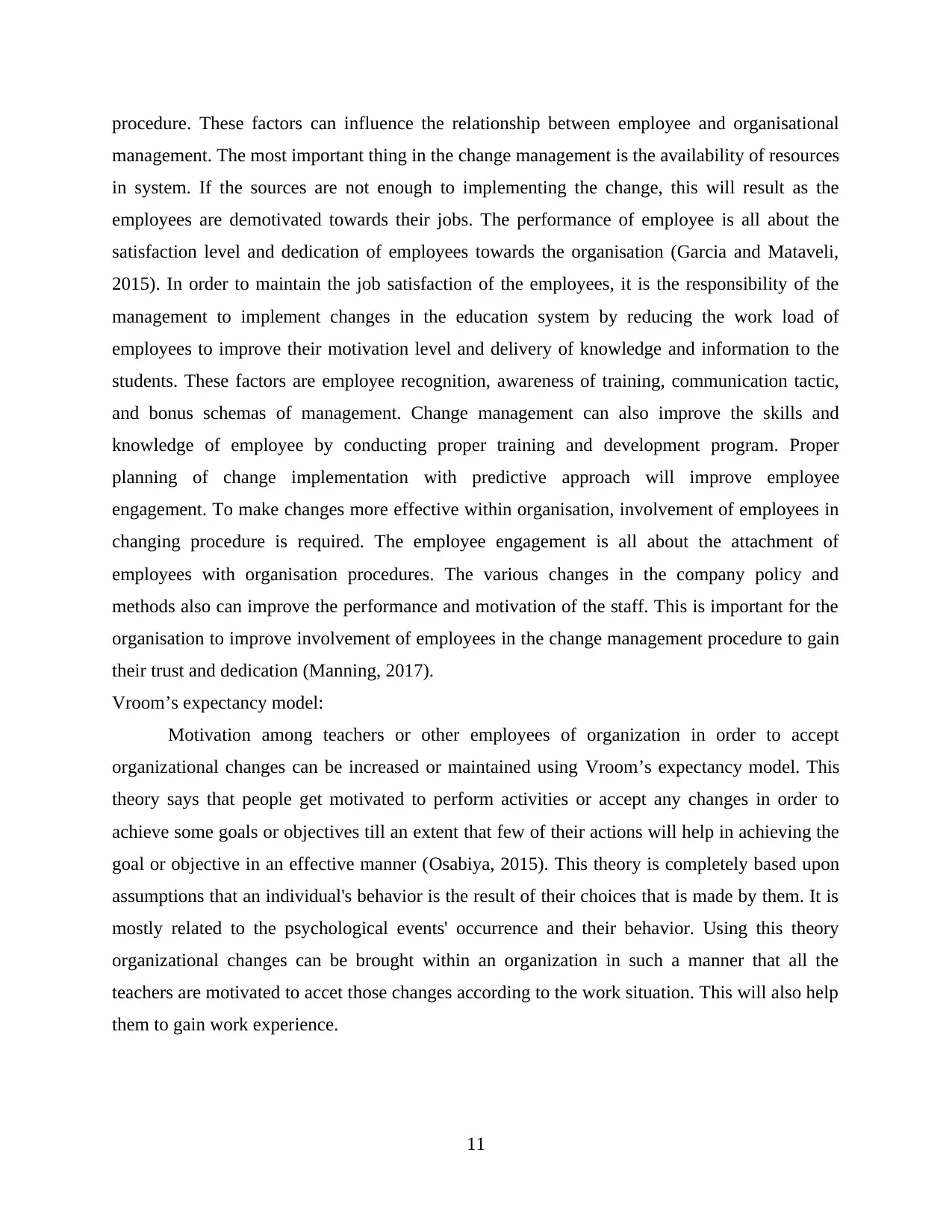
procedure. These factors can influence the relationship between employee and organisational
management. The most important thing in the change management is the availability of resources
in system. If the sources are not enough to implementing the change, this will result as the
employees are demotivated towards their jobs. The performance of employee is all about the
satisfaction level and dedication of employees towards the organisation (Garcia and Mataveli,
2015). In order to maintain the job satisfaction of the employees, it is the responsibility of the
management to implement changes in the education system by reducing the work load of
employees to improve their motivation level and delivery of knowledge and information to the
students. These factors are employee recognition, awareness of training, communication tactic,
and bonus schemas of management. Change management can also improve the skills and
knowledge of employee by conducting proper training and development program. Proper
planning of change implementation with predictive approach will improve employee
engagement. To make changes more effective within organisation, involvement of employees in
changing procedure is required. The employee engagement is all about the attachment of
employees with organisation procedures. The various changes in the company policy and
methods also can improve the performance and motivation of the staff. This is important for the
organisation to improve involvement of employees in the change management procedure to gain
their trust and dedication (Manning, 2017).
Vroom’s expectancy model:
Motivation among teachers or other employees of organization in order to accept
organizational changes can be increased or maintained using Vroom’s expectancy model. This
theory says that people get motivated to perform activities or accept any changes in order to
achieve some goals or objectives till an extent that few of their actions will help in achieving the
goal or objective in an effective manner (Osabiya, 2015). This theory is completely based upon
assumptions that an individual's behavior is the result of their choices that is made by them. It is
mostly related to the psychological events' occurrence and their behavior. Using this theory
organizational changes can be brought within an organization in such a manner that all the
teachers are motivated to accet those changes according to the work situation. This will also help
them to gain work experience.
11
management. The most important thing in the change management is the availability of resources
in system. If the sources are not enough to implementing the change, this will result as the
employees are demotivated towards their jobs. The performance of employee is all about the
satisfaction level and dedication of employees towards the organisation (Garcia and Mataveli,
2015). In order to maintain the job satisfaction of the employees, it is the responsibility of the
management to implement changes in the education system by reducing the work load of
employees to improve their motivation level and delivery of knowledge and information to the
students. These factors are employee recognition, awareness of training, communication tactic,
and bonus schemas of management. Change management can also improve the skills and
knowledge of employee by conducting proper training and development program. Proper
planning of change implementation with predictive approach will improve employee
engagement. To make changes more effective within organisation, involvement of employees in
changing procedure is required. The employee engagement is all about the attachment of
employees with organisation procedures. The various changes in the company policy and
methods also can improve the performance and motivation of the staff. This is important for the
organisation to improve involvement of employees in the change management procedure to gain
their trust and dedication (Manning, 2017).
Vroom’s expectancy model:
Motivation among teachers or other employees of organization in order to accept
organizational changes can be increased or maintained using Vroom’s expectancy model. This
theory says that people get motivated to perform activities or accept any changes in order to
achieve some goals or objectives till an extent that few of their actions will help in achieving the
goal or objective in an effective manner (Osabiya, 2015). This theory is completely based upon
assumptions that an individual's behavior is the result of their choices that is made by them. It is
mostly related to the psychological events' occurrence and their behavior. Using this theory
organizational changes can be brought within an organization in such a manner that all the
teachers are motivated to accet those changes according to the work situation. This will also help
them to gain work experience.
11
Secure Best Marks with AI Grader
Need help grading? Try our AI Grader for instant feedback on your assignments.
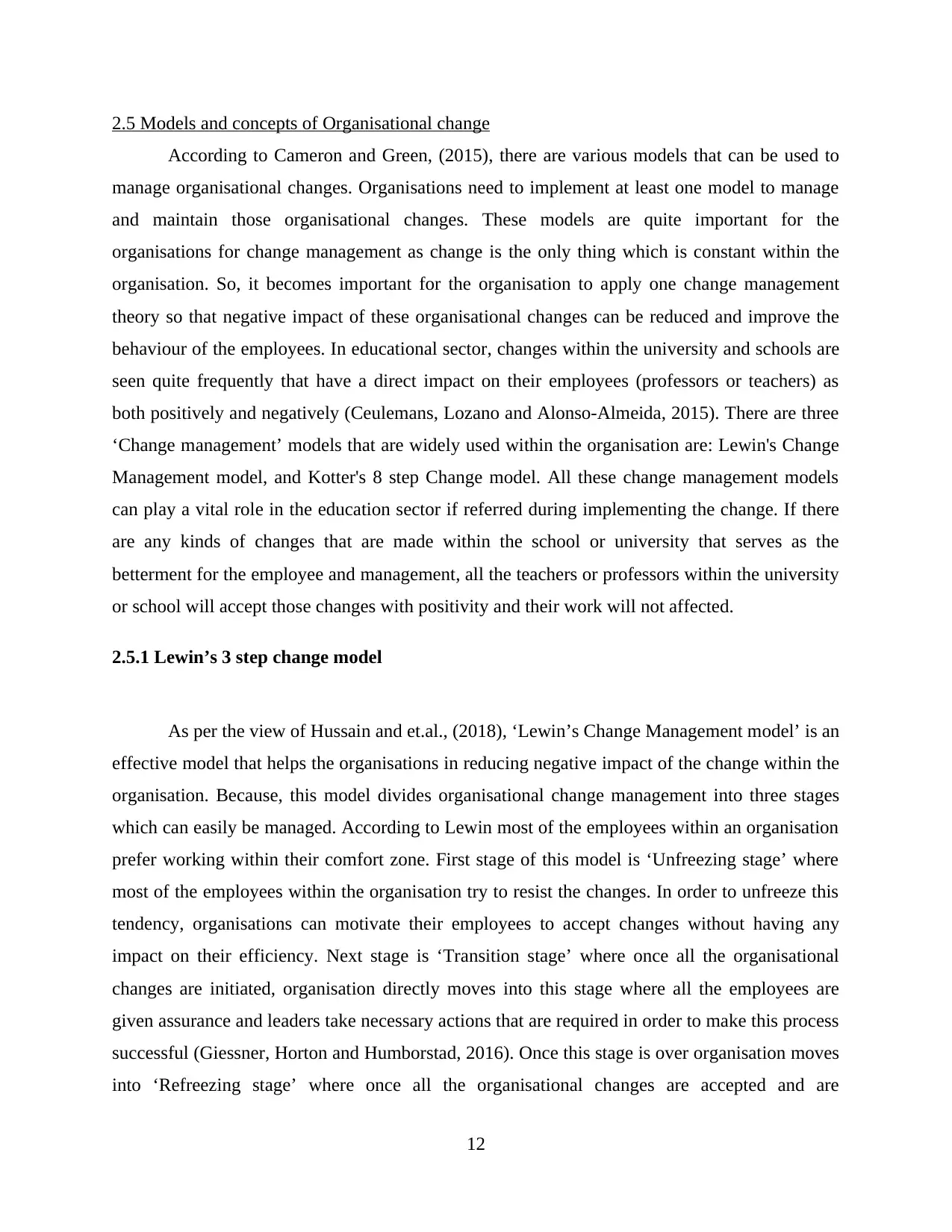
2.5 Models and concepts of Organisational change
According to Cameron and Green, (2015), there are various models that can be used to
manage organisational changes. Organisations need to implement at least one model to manage
and maintain those organisational changes. These models are quite important for the
organisations for change management as change is the only thing which is constant within the
organisation. So, it becomes important for the organisation to apply one change management
theory so that negative impact of these organisational changes can be reduced and improve the
behaviour of the employees. In educational sector, changes within the university and schools are
seen quite frequently that have a direct impact on their employees (professors or teachers) as
both positively and negatively (Ceulemans, Lozano and Alonso-Almeida, 2015). There are three
‘Change management’ models that are widely used within the organisation are: Lewin's Change
Management model, and Kotter's 8 step Change model. All these change management models
can play a vital role in the education sector if referred during implementing the change. If there
are any kinds of changes that are made within the school or university that serves as the
betterment for the employee and management, all the teachers or professors within the university
or school will accept those changes with positivity and their work will not affected.
2.5.1 Lewin’s 3 step change model
As per the view of Hussain and et.al., (2018), ‘Lewin’s Change Management model’ is an
effective model that helps the organisations in reducing negative impact of the change within the
organisation. Because, this model divides organisational change management into three stages
which can easily be managed. According to Lewin most of the employees within an organisation
prefer working within their comfort zone. First stage of this model is ‘Unfreezing stage’ where
most of the employees within the organisation try to resist the changes. In order to unfreeze this
tendency, organisations can motivate their employees to accept changes without having any
impact on their efficiency. Next stage is ‘Transition stage’ where once all the organisational
changes are initiated, organisation directly moves into this stage where all the employees are
given assurance and leaders take necessary actions that are required in order to make this process
successful (Giessner, Horton and Humborstad, 2016). Once this stage is over organisation moves
into ‘Refreezing stage’ where once all the organisational changes are accepted and are
12
According to Cameron and Green, (2015), there are various models that can be used to
manage organisational changes. Organisations need to implement at least one model to manage
and maintain those organisational changes. These models are quite important for the
organisations for change management as change is the only thing which is constant within the
organisation. So, it becomes important for the organisation to apply one change management
theory so that negative impact of these organisational changes can be reduced and improve the
behaviour of the employees. In educational sector, changes within the university and schools are
seen quite frequently that have a direct impact on their employees (professors or teachers) as
both positively and negatively (Ceulemans, Lozano and Alonso-Almeida, 2015). There are three
‘Change management’ models that are widely used within the organisation are: Lewin's Change
Management model, and Kotter's 8 step Change model. All these change management models
can play a vital role in the education sector if referred during implementing the change. If there
are any kinds of changes that are made within the school or university that serves as the
betterment for the employee and management, all the teachers or professors within the university
or school will accept those changes with positivity and their work will not affected.
2.5.1 Lewin’s 3 step change model
As per the view of Hussain and et.al., (2018), ‘Lewin’s Change Management model’ is an
effective model that helps the organisations in reducing negative impact of the change within the
organisation. Because, this model divides organisational change management into three stages
which can easily be managed. According to Lewin most of the employees within an organisation
prefer working within their comfort zone. First stage of this model is ‘Unfreezing stage’ where
most of the employees within the organisation try to resist the changes. In order to unfreeze this
tendency, organisations can motivate their employees to accept changes without having any
impact on their efficiency. Next stage is ‘Transition stage’ where once all the organisational
changes are initiated, organisation directly moves into this stage where all the employees are
given assurance and leaders take necessary actions that are required in order to make this process
successful (Giessner, Horton and Humborstad, 2016). Once this stage is over organisation moves
into ‘Refreezing stage’ where once all the organisational changes are accepted and are
12
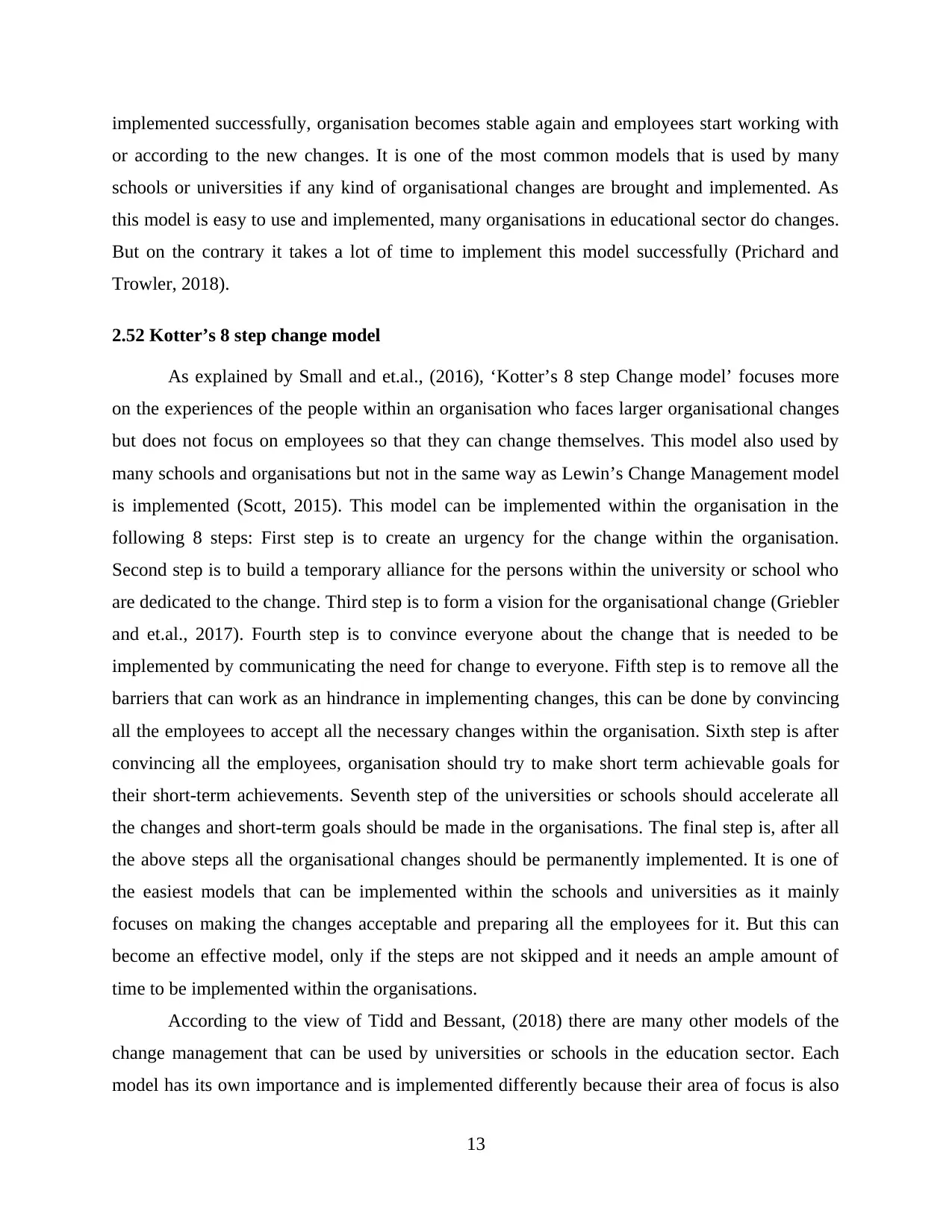
implemented successfully, organisation becomes stable again and employees start working with
or according to the new changes. It is one of the most common models that is used by many
schools or universities if any kind of organisational changes are brought and implemented. As
this model is easy to use and implemented, many organisations in educational sector do changes.
But on the contrary it takes a lot of time to implement this model successfully (Prichard and
Trowler, 2018).
2.52 Kotter’s 8 step change model
As explained by Small and et.al., (2016), ‘Kotter’s 8 step Change model’ focuses more
on the experiences of the people within an organisation who faces larger organisational changes
but does not focus on employees so that they can change themselves. This model also used by
many schools and organisations but not in the same way as Lewin’s Change Management model
is implemented (Scott, 2015). This model can be implemented within the organisation in the
following 8 steps: First step is to create an urgency for the change within the organisation.
Second step is to build a temporary alliance for the persons within the university or school who
are dedicated to the change. Third step is to form a vision for the organisational change (Griebler
and et.al., 2017). Fourth step is to convince everyone about the change that is needed to be
implemented by communicating the need for change to everyone. Fifth step is to remove all the
barriers that can work as an hindrance in implementing changes, this can be done by convincing
all the employees to accept all the necessary changes within the organisation. Sixth step is after
convincing all the employees, organisation should try to make short term achievable goals for
their short-term achievements. Seventh step of the universities or schools should accelerate all
the changes and short-term goals should be made in the organisations. The final step is, after all
the above steps all the organisational changes should be permanently implemented. It is one of
the easiest models that can be implemented within the schools and universities as it mainly
focuses on making the changes acceptable and preparing all the employees for it. But this can
become an effective model, only if the steps are not skipped and it needs an ample amount of
time to be implemented within the organisations.
According to the view of Tidd and Bessant, (2018) there are many other models of the
change management that can be used by universities or schools in the education sector. Each
model has its own importance and is implemented differently because their area of focus is also
13
or according to the new changes. It is one of the most common models that is used by many
schools or universities if any kind of organisational changes are brought and implemented. As
this model is easy to use and implemented, many organisations in educational sector do changes.
But on the contrary it takes a lot of time to implement this model successfully (Prichard and
Trowler, 2018).
2.52 Kotter’s 8 step change model
As explained by Small and et.al., (2016), ‘Kotter’s 8 step Change model’ focuses more
on the experiences of the people within an organisation who faces larger organisational changes
but does not focus on employees so that they can change themselves. This model also used by
many schools and organisations but not in the same way as Lewin’s Change Management model
is implemented (Scott, 2015). This model can be implemented within the organisation in the
following 8 steps: First step is to create an urgency for the change within the organisation.
Second step is to build a temporary alliance for the persons within the university or school who
are dedicated to the change. Third step is to form a vision for the organisational change (Griebler
and et.al., 2017). Fourth step is to convince everyone about the change that is needed to be
implemented by communicating the need for change to everyone. Fifth step is to remove all the
barriers that can work as an hindrance in implementing changes, this can be done by convincing
all the employees to accept all the necessary changes within the organisation. Sixth step is after
convincing all the employees, organisation should try to make short term achievable goals for
their short-term achievements. Seventh step of the universities or schools should accelerate all
the changes and short-term goals should be made in the organisations. The final step is, after all
the above steps all the organisational changes should be permanently implemented. It is one of
the easiest models that can be implemented within the schools and universities as it mainly
focuses on making the changes acceptable and preparing all the employees for it. But this can
become an effective model, only if the steps are not skipped and it needs an ample amount of
time to be implemented within the organisations.
According to the view of Tidd and Bessant, (2018) there are many other models of the
change management that can be used by universities or schools in the education sector. Each
model has its own importance and is implemented differently because their area of focus is also
13
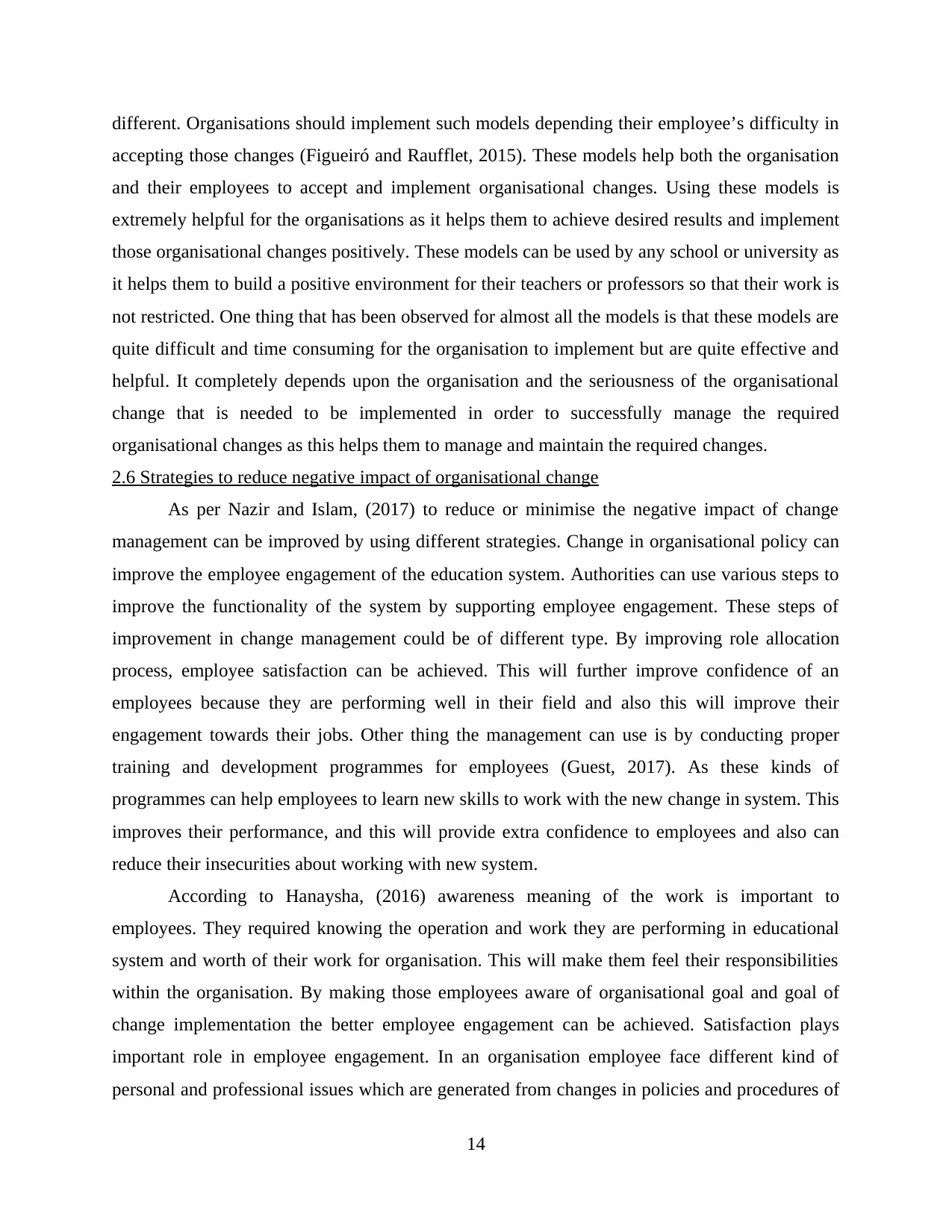
different. Organisations should implement such models depending their employee’s difficulty in
accepting those changes (Figueiró and Raufflet, 2015). These models help both the organisation
and their employees to accept and implement organisational changes. Using these models is
extremely helpful for the organisations as it helps them to achieve desired results and implement
those organisational changes positively. These models can be used by any school or university as
it helps them to build a positive environment for their teachers or professors so that their work is
not restricted. One thing that has been observed for almost all the models is that these models are
quite difficult and time consuming for the organisation to implement but are quite effective and
helpful. It completely depends upon the organisation and the seriousness of the organisational
change that is needed to be implemented in order to successfully manage the required
organisational changes as this helps them to manage and maintain the required changes.
2.6 Strategies to reduce negative impact of organisational change
As per Nazir and Islam, (2017) to reduce or minimise the negative impact of change
management can be improved by using different strategies. Change in organisational policy can
improve the employee engagement of the education system. Authorities can use various steps to
improve the functionality of the system by supporting employee engagement. These steps of
improvement in change management could be of different type. By improving role allocation
process, employee satisfaction can be achieved. This will further improve confidence of an
employees because they are performing well in their field and also this will improve their
engagement towards their jobs. Other thing the management can use is by conducting proper
training and development programmes for employees (Guest, 2017). As these kinds of
programmes can help employees to learn new skills to work with the new change in system. This
improves their performance, and this will provide extra confidence to employees and also can
reduce their insecurities about working with new system.
According to Hanaysha, (2016) awareness meaning of the work is important to
employees. They required knowing the operation and work they are performing in educational
system and worth of their work for organisation. This will make them feel their responsibilities
within the organisation. By making those employees aware of organisational goal and goal of
change implementation the better employee engagement can be achieved. Satisfaction plays
important role in employee engagement. In an organisation employee face different kind of
personal and professional issues which are generated from changes in policies and procedures of
14
accepting those changes (Figueiró and Raufflet, 2015). These models help both the organisation
and their employees to accept and implement organisational changes. Using these models is
extremely helpful for the organisations as it helps them to achieve desired results and implement
those organisational changes positively. These models can be used by any school or university as
it helps them to build a positive environment for their teachers or professors so that their work is
not restricted. One thing that has been observed for almost all the models is that these models are
quite difficult and time consuming for the organisation to implement but are quite effective and
helpful. It completely depends upon the organisation and the seriousness of the organisational
change that is needed to be implemented in order to successfully manage the required
organisational changes as this helps them to manage and maintain the required changes.
2.6 Strategies to reduce negative impact of organisational change
As per Nazir and Islam, (2017) to reduce or minimise the negative impact of change
management can be improved by using different strategies. Change in organisational policy can
improve the employee engagement of the education system. Authorities can use various steps to
improve the functionality of the system by supporting employee engagement. These steps of
improvement in change management could be of different type. By improving role allocation
process, employee satisfaction can be achieved. This will further improve confidence of an
employees because they are performing well in their field and also this will improve their
engagement towards their jobs. Other thing the management can use is by conducting proper
training and development programmes for employees (Guest, 2017). As these kinds of
programmes can help employees to learn new skills to work with the new change in system. This
improves their performance, and this will provide extra confidence to employees and also can
reduce their insecurities about working with new system.
According to Hanaysha, (2016) awareness meaning of the work is important to
employees. They required knowing the operation and work they are performing in educational
system and worth of their work for organisation. This will make them feel their responsibilities
within the organisation. By making those employees aware of organisational goal and goal of
change implementation the better employee engagement can be achieved. Satisfaction plays
important role in employee engagement. In an organisation employee face different kind of
personal and professional issues which are generated from changes in policies and procedures of
14
Paraphrase This Document
Need a fresh take? Get an instant paraphrase of this document with our AI Paraphraser

education system and this can create conflicts and differences in management and employees.
This issue of employees can be reduced by taking feedbacks that are obtained in personal
interviews. This will help the management to know the issues of employee due to changes made
by management. Management can work on these issues to resolve problems of employees and
this can employee their attachment with organisation.
As per Popli and Rizvi, (2017) one of the most effective way to resolve employee
engagement issues in educational organisation is by conducting discussion and consultation
sessions in organisation. In this kind of meetings employees can discuss the working and process
of system. This will help the management to understand the ground level situation on work
place. With the help of this session employees can discuss various issues to other and this will
help them to learn work procedures of organisation. This discussion session can improve
productivity of organisation. The other thing organisation management can do is- improve the
communication between management and employees. The communication gap between
employees and management cause a lot of troubles to organisation procedure (Hahn and Aragón-
Correa, 2015). By resolving this gap between employees and management can solve the negative
impacts of change management on employee engagement. The other thing company can perform
to reduce negative impact of change management by listening to employees and their issues.
This will make them feel good and improve their trust towards the organisation. The employees
also can be improved by interchanging of ideas and suggestion where the feel that they are
involved in decision-making and valued as the key part of an organisation and will provide them
feeling of belongingness to the organisation.
2.7 Ways to maintain positive behaviour within organisation
As per the view of Raziq and Maulabakhsh, (2015) it is quite important to maintain
positive behaviour at work place especially in organisations within educational sector. Positive
behaviour of employees within organisations not only motivates employees to work productively
but it has also become one of the main reason due to which co-workers get inspired and work
harder. In other words, this healthy work environment increases the productivity, creativity,
happiness, reduces stress level of employees. Positive business environment encourages co-
workers and other employees to accept and face new challenges, provides job satisfactory to the
employees (Hersted and Frimann, 2019). It also helps in various ways through which both the
employees as well as the organisation get benefits like, employee loyalty for the company
15
This issue of employees can be reduced by taking feedbacks that are obtained in personal
interviews. This will help the management to know the issues of employee due to changes made
by management. Management can work on these issues to resolve problems of employees and
this can employee their attachment with organisation.
As per Popli and Rizvi, (2017) one of the most effective way to resolve employee
engagement issues in educational organisation is by conducting discussion and consultation
sessions in organisation. In this kind of meetings employees can discuss the working and process
of system. This will help the management to understand the ground level situation on work
place. With the help of this session employees can discuss various issues to other and this will
help them to learn work procedures of organisation. This discussion session can improve
productivity of organisation. The other thing organisation management can do is- improve the
communication between management and employees. The communication gap between
employees and management cause a lot of troubles to organisation procedure (Hahn and Aragón-
Correa, 2015). By resolving this gap between employees and management can solve the negative
impacts of change management on employee engagement. The other thing company can perform
to reduce negative impact of change management by listening to employees and their issues.
This will make them feel good and improve their trust towards the organisation. The employees
also can be improved by interchanging of ideas and suggestion where the feel that they are
involved in decision-making and valued as the key part of an organisation and will provide them
feeling of belongingness to the organisation.
2.7 Ways to maintain positive behaviour within organisation
As per the view of Raziq and Maulabakhsh, (2015) it is quite important to maintain
positive behaviour at work place especially in organisations within educational sector. Positive
behaviour of employees within organisations not only motivates employees to work productively
but it has also become one of the main reason due to which co-workers get inspired and work
harder. In other words, this healthy work environment increases the productivity, creativity,
happiness, reduces stress level of employees. Positive business environment encourages co-
workers and other employees to accept and face new challenges, provides job satisfactory to the
employees (Hersted and Frimann, 2019). It also helps in various ways through which both the
employees as well as the organisation get benefits like, employee loyalty for the company
15

increases and they put more efforts to fulfil their responsibilities and achieve new targets for
themselves as well as for the company, increases employee job satisfaction which helps them to
put more efforts within their work, employees work effectively within the team by collaborating
with other team members, reduces overall stress level of both the employees and of the employee
which enhances their organisational business.
Raziq and Maulabakhsh, (2015) also say that there are various factors that help in
maintaining as well as creating positive working environment within the organisations which
have been explained below: By improving organisational culture as a positive working
environment is built by building a positive working environment so that the employees can focus
on main objectives and goals of an organisation. By greeting all the employees with gratitude,
appreciating their work as well as acknowledging their moral values which helps in building
positive behaviour within employees of an organisation (Hüther and Krücken, 2016). This
motivates employees to work enthusiastically and face and participate in any situation
professionally. In order to bring positive environment within an organisation it is important to
create a safe working environment i.e. no damage or toxicity should be present within working
environment. Safe working environment helps in removing negativity within the workplace as
well as helps in generating new ideas. If the employee within an organisation feels safe then it
helps in increasing honesty, integrity and also helps in reducing vulnerable situations within the
organisations. All the profits or organisational opportunities should be shared with the employees
as well.
As explained by Fernandez and Rainey, (2017) There are many other factors that
contributing in encouraging positive behaviour within the organisation by encouraging positive
organisational culture within an organisation. This will encourage employees to put their best
efforts within their work so that desired targets can be achieved, it will also help in reducing
employee conflicts and resolving them in a better manner. Employees will positively exchange
or interchange their view points or ideas as well (Illeris, 2016). This organisational culture also
helps in improving both formal and informal learning within the organisation.
2.8 Comparison of previous empirical studies
Research paper 1: Organizational change and employee mental health: A prospective multilevel
study of the associations between organizational changes and clinically relevant mental distress
(Figueiró and Raufflet, 2015).
16
themselves as well as for the company, increases employee job satisfaction which helps them to
put more efforts within their work, employees work effectively within the team by collaborating
with other team members, reduces overall stress level of both the employees and of the employee
which enhances their organisational business.
Raziq and Maulabakhsh, (2015) also say that there are various factors that help in
maintaining as well as creating positive working environment within the organisations which
have been explained below: By improving organisational culture as a positive working
environment is built by building a positive working environment so that the employees can focus
on main objectives and goals of an organisation. By greeting all the employees with gratitude,
appreciating their work as well as acknowledging their moral values which helps in building
positive behaviour within employees of an organisation (Hüther and Krücken, 2016). This
motivates employees to work enthusiastically and face and participate in any situation
professionally. In order to bring positive environment within an organisation it is important to
create a safe working environment i.e. no damage or toxicity should be present within working
environment. Safe working environment helps in removing negativity within the workplace as
well as helps in generating new ideas. If the employee within an organisation feels safe then it
helps in increasing honesty, integrity and also helps in reducing vulnerable situations within the
organisations. All the profits or organisational opportunities should be shared with the employees
as well.
As explained by Fernandez and Rainey, (2017) There are many other factors that
contributing in encouraging positive behaviour within the organisation by encouraging positive
organisational culture within an organisation. This will encourage employees to put their best
efforts within their work so that desired targets can be achieved, it will also help in reducing
employee conflicts and resolving them in a better manner. Employees will positively exchange
or interchange their view points or ideas as well (Illeris, 2016). This organisational culture also
helps in improving both formal and informal learning within the organisation.
2.8 Comparison of previous empirical studies
Research paper 1: Organizational change and employee mental health: A prospective multilevel
study of the associations between organizational changes and clinically relevant mental distress
(Figueiró and Raufflet, 2015).
16

Methods used: Prospective design was used, data was collected at two time point two
years apart through online questionnaire. Organizational change was measured by using
six items pertaining to separate types of change and mental distress was calculated using
clinically relevant distress identifier.
Sample Size: Sample consisted of 7985 respondents out of which 5297 participated at
follow-up.
Results: Organizational change exposure at individual level explained that there was a
subsequent risk of mental distress due to separate, repeated and multiple organizational
changes. These changes and distress related to it was available at work unit level as well
but it was eliminated when certain work factors were adjusted which helped in reducing
overall effect of organizational changes.
Research paper 2:Organizational change, psychosocial work environment, and non-disability
early retirement: a prospective study among senior public employees (Breinegaard, Jensen and
Bonde, 2017).
Methods used: Primary data collection method was used for 3254 respondents. A survey
was conducted with the respondents to measure organizational changes.
Sample Size: Sample size taken for this research paper was 3254.
Results: Organizational changes and poor working environment resulted into early
retirement of senior public service employees measured at work unit level.
Both the studies show that organizational changes affect the employees in multiple ways which
takes a lot of time for them to adjust and go through all the changes.
2.9 Summary
The education sector plays a vital role in countries literacy rate, so it is important to bring
changes within organisations in this sector. These changes can be related to anything like change
in educational structure, change in teaching pattern and various others. These changes can affect
the overall performance of employees, their behaviour and attitude. Not only this, these changes
might affect the motivation level of employees (both positively and negatively). So it can be
concluded that if any kind of changes are required to be brought within the organisation then
training regarding the same should be given to the employees. Employees should be motivated
so that they engage themselves within the organisation and accept changes.
17
years apart through online questionnaire. Organizational change was measured by using
six items pertaining to separate types of change and mental distress was calculated using
clinically relevant distress identifier.
Sample Size: Sample consisted of 7985 respondents out of which 5297 participated at
follow-up.
Results: Organizational change exposure at individual level explained that there was a
subsequent risk of mental distress due to separate, repeated and multiple organizational
changes. These changes and distress related to it was available at work unit level as well
but it was eliminated when certain work factors were adjusted which helped in reducing
overall effect of organizational changes.
Research paper 2:Organizational change, psychosocial work environment, and non-disability
early retirement: a prospective study among senior public employees (Breinegaard, Jensen and
Bonde, 2017).
Methods used: Primary data collection method was used for 3254 respondents. A survey
was conducted with the respondents to measure organizational changes.
Sample Size: Sample size taken for this research paper was 3254.
Results: Organizational changes and poor working environment resulted into early
retirement of senior public service employees measured at work unit level.
Both the studies show that organizational changes affect the employees in multiple ways which
takes a lot of time for them to adjust and go through all the changes.
2.9 Summary
The education sector plays a vital role in countries literacy rate, so it is important to bring
changes within organisations in this sector. These changes can be related to anything like change
in educational structure, change in teaching pattern and various others. These changes can affect
the overall performance of employees, their behaviour and attitude. Not only this, these changes
might affect the motivation level of employees (both positively and negatively). So it can be
concluded that if any kind of changes are required to be brought within the organisation then
training regarding the same should be given to the employees. Employees should be motivated
so that they engage themselves within the organisation and accept changes.
17
Secure Best Marks with AI Grader
Need help grading? Try our AI Grader for instant feedback on your assignments.
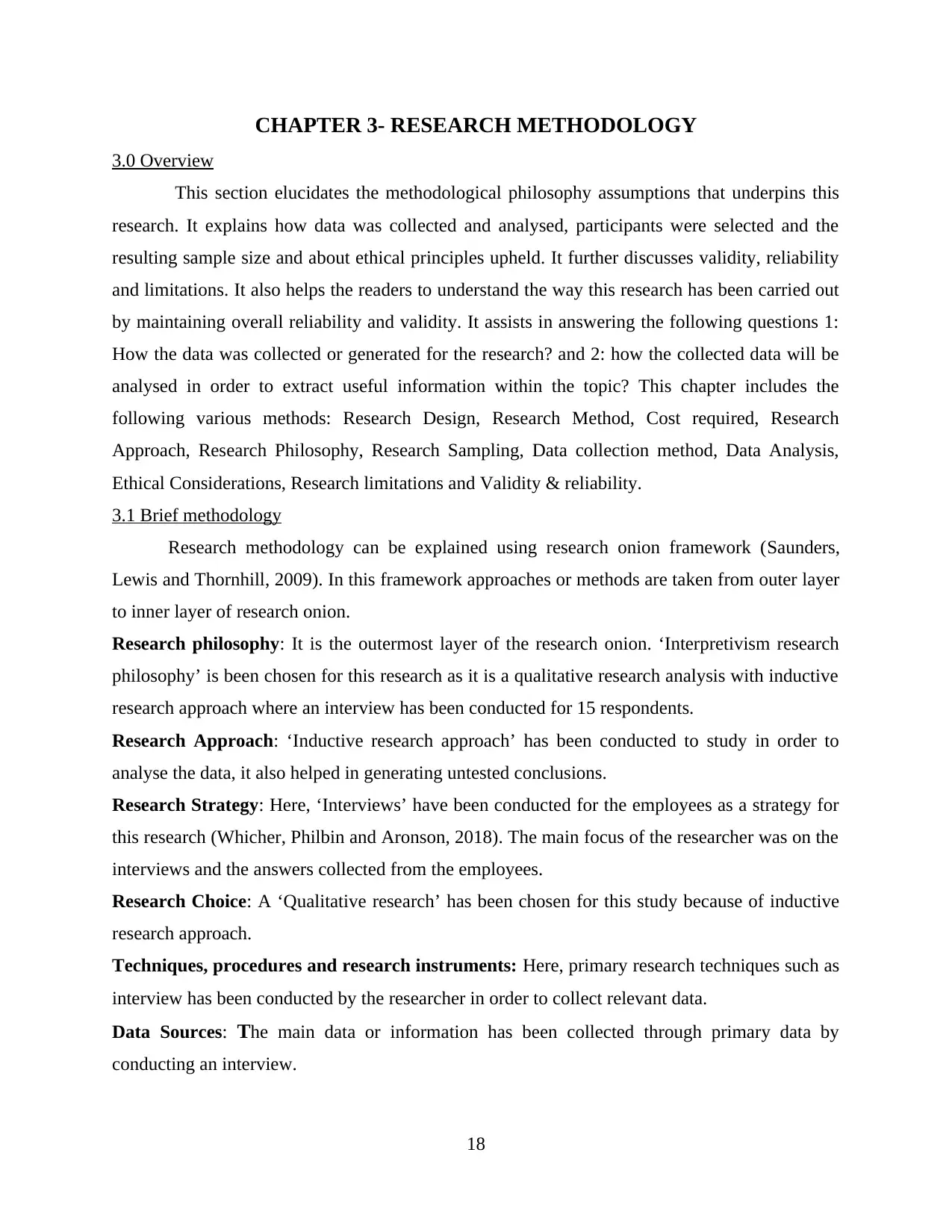
CHAPTER 3- RESEARCH METHODOLOGY
3.0 Overview
This section elucidates the methodological philosophy assumptions that underpins this
research. It explains how data was collected and analysed, participants were selected and the
resulting sample size and about ethical principles upheld. It further discusses validity, reliability
and limitations. It also helps the readers to understand the way this research has been carried out
by maintaining overall reliability and validity. It assists in answering the following questions 1:
How the data was collected or generated for the research? and 2: how the collected data will be
analysed in order to extract useful information within the topic? This chapter includes the
following various methods: Research Design, Research Method, Cost required, Research
Approach, Research Philosophy, Research Sampling, Data collection method, Data Analysis,
Ethical Considerations, Research limitations and Validity & reliability.
3.1 Brief methodology
Research methodology can be explained using research onion framework (Saunders,
Lewis and Thornhill, 2009). In this framework approaches or methods are taken from outer layer
to inner layer of research onion.
Research philosophy: It is the outermost layer of the research onion. ‘Interpretivism research
philosophy’ is been chosen for this research as it is a qualitative research analysis with inductive
research approach where an interview has been conducted for 15 respondents.
Research Approach: ‘Inductive research approach’ has been conducted to study in order to
analyse the data, it also helped in generating untested conclusions.
Research Strategy: Here, ‘Interviews’ have been conducted for the employees as a strategy for
this research (Whicher, Philbin and Aronson, 2018). The main focus of the researcher was on the
interviews and the answers collected from the employees.
Research Choice: A ‘Qualitative research’ has been chosen for this study because of inductive
research approach.
Techniques, procedures and research instruments: Here, primary research techniques such as
interview has been conducted by the researcher in order to collect relevant data.
Data Sources: The main data or information has been collected through primary data by
conducting an interview.
18
3.0 Overview
This section elucidates the methodological philosophy assumptions that underpins this
research. It explains how data was collected and analysed, participants were selected and the
resulting sample size and about ethical principles upheld. It further discusses validity, reliability
and limitations. It also helps the readers to understand the way this research has been carried out
by maintaining overall reliability and validity. It assists in answering the following questions 1:
How the data was collected or generated for the research? and 2: how the collected data will be
analysed in order to extract useful information within the topic? This chapter includes the
following various methods: Research Design, Research Method, Cost required, Research
Approach, Research Philosophy, Research Sampling, Data collection method, Data Analysis,
Ethical Considerations, Research limitations and Validity & reliability.
3.1 Brief methodology
Research methodology can be explained using research onion framework (Saunders,
Lewis and Thornhill, 2009). In this framework approaches or methods are taken from outer layer
to inner layer of research onion.
Research philosophy: It is the outermost layer of the research onion. ‘Interpretivism research
philosophy’ is been chosen for this research as it is a qualitative research analysis with inductive
research approach where an interview has been conducted for 15 respondents.
Research Approach: ‘Inductive research approach’ has been conducted to study in order to
analyse the data, it also helped in generating untested conclusions.
Research Strategy: Here, ‘Interviews’ have been conducted for the employees as a strategy for
this research (Whicher, Philbin and Aronson, 2018). The main focus of the researcher was on the
interviews and the answers collected from the employees.
Research Choice: A ‘Qualitative research’ has been chosen for this study because of inductive
research approach.
Techniques, procedures and research instruments: Here, primary research techniques such as
interview has been conducted by the researcher in order to collect relevant data.
Data Sources: The main data or information has been collected through primary data by
conducting an interview.
18
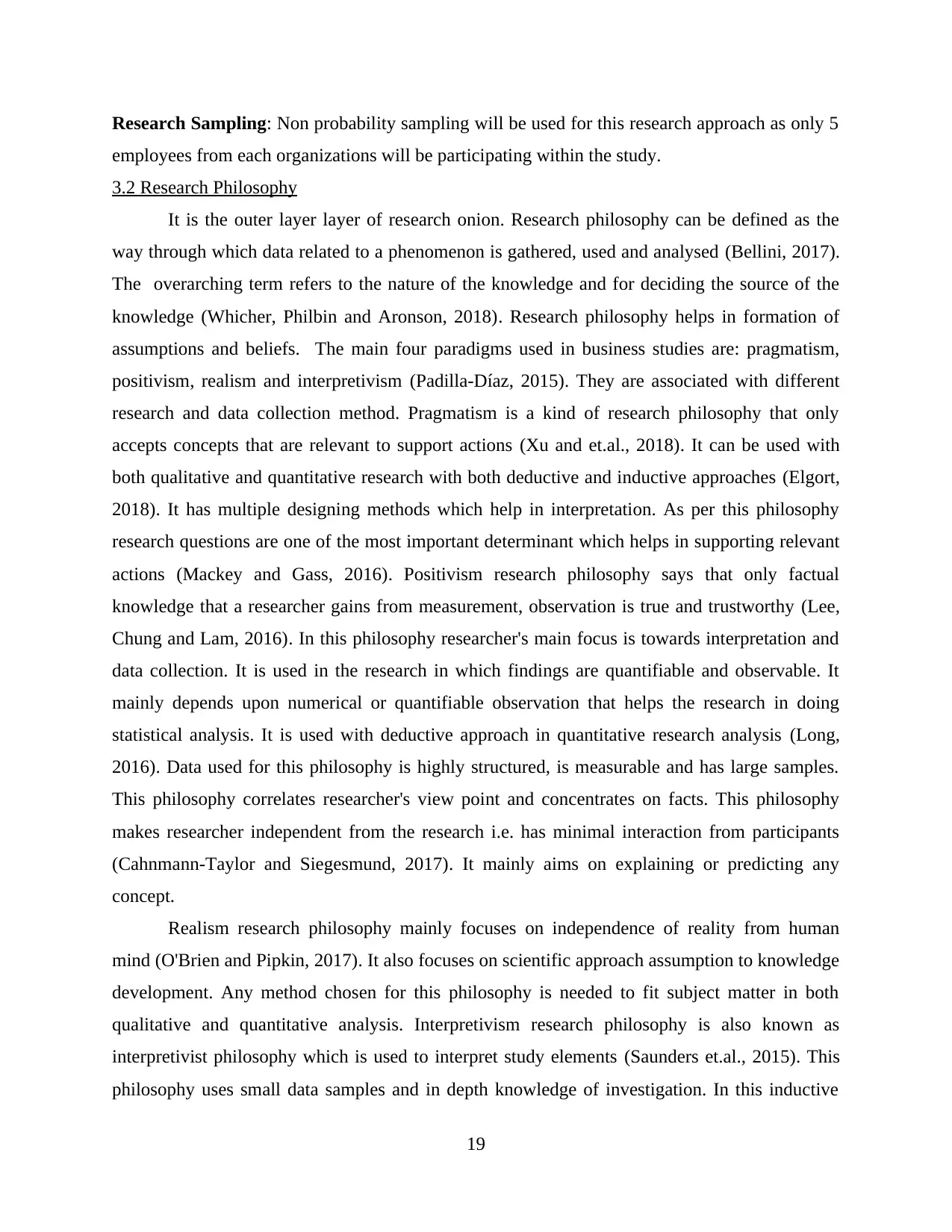
Research Sampling: Non probability sampling will be used for this research approach as only 5
employees from each organizations will be participating within the study.
3.2 Research Philosophy
It is the outer layer layer of research onion. Research philosophy can be defined as the
way through which data related to a phenomenon is gathered, used and analysed (Bellini, 2017).
The overarching term refers to the nature of the knowledge and for deciding the source of the
knowledge (Whicher, Philbin and Aronson, 2018). Research philosophy helps in formation of
assumptions and beliefs. The main four paradigms used in business studies are: pragmatism,
positivism, realism and interpretivism (Padilla-Díaz, 2015). They are associated with different
research and data collection method. Pragmatism is a kind of research philosophy that only
accepts concepts that are relevant to support actions (Xu and et.al., 2018). It can be used with
both qualitative and quantitative research with both deductive and inductive approaches (Elgort,
2018). It has multiple designing methods which help in interpretation. As per this philosophy
research questions are one of the most important determinant which helps in supporting relevant
actions (Mackey and Gass, 2016). Positivism research philosophy says that only factual
knowledge that a researcher gains from measurement, observation is true and trustworthy (Lee,
Chung and Lam, 2016). In this philosophy researcher's main focus is towards interpretation and
data collection. It is used in the research in which findings are quantifiable and observable. It
mainly depends upon numerical or quantifiable observation that helps the research in doing
statistical analysis. It is used with deductive approach in quantitative research analysis (Long,
2016). Data used for this philosophy is highly structured, is measurable and has large samples.
This philosophy correlates researcher's view point and concentrates on facts. This philosophy
makes researcher independent from the research i.e. has minimal interaction from participants
(Cahnmann-Taylor and Siegesmund, 2017). It mainly aims on explaining or predicting any
concept.
Realism research philosophy mainly focuses on independence of reality from human
mind (O'Brien and Pipkin, 2017). It also focuses on scientific approach assumption to knowledge
development. Any method chosen for this philosophy is needed to fit subject matter in both
qualitative and quantitative analysis. Interpretivism research philosophy is also known as
interpretivist philosophy which is used to interpret study elements (Saunders et.al., 2015). This
philosophy uses small data samples and in depth knowledge of investigation. In this inductive
19
employees from each organizations will be participating within the study.
3.2 Research Philosophy
It is the outer layer layer of research onion. Research philosophy can be defined as the
way through which data related to a phenomenon is gathered, used and analysed (Bellini, 2017).
The overarching term refers to the nature of the knowledge and for deciding the source of the
knowledge (Whicher, Philbin and Aronson, 2018). Research philosophy helps in formation of
assumptions and beliefs. The main four paradigms used in business studies are: pragmatism,
positivism, realism and interpretivism (Padilla-Díaz, 2015). They are associated with different
research and data collection method. Pragmatism is a kind of research philosophy that only
accepts concepts that are relevant to support actions (Xu and et.al., 2018). It can be used with
both qualitative and quantitative research with both deductive and inductive approaches (Elgort,
2018). It has multiple designing methods which help in interpretation. As per this philosophy
research questions are one of the most important determinant which helps in supporting relevant
actions (Mackey and Gass, 2016). Positivism research philosophy says that only factual
knowledge that a researcher gains from measurement, observation is true and trustworthy (Lee,
Chung and Lam, 2016). In this philosophy researcher's main focus is towards interpretation and
data collection. It is used in the research in which findings are quantifiable and observable. It
mainly depends upon numerical or quantifiable observation that helps the research in doing
statistical analysis. It is used with deductive approach in quantitative research analysis (Long,
2016). Data used for this philosophy is highly structured, is measurable and has large samples.
This philosophy correlates researcher's view point and concentrates on facts. This philosophy
makes researcher independent from the research i.e. has minimal interaction from participants
(Cahnmann-Taylor and Siegesmund, 2017). It mainly aims on explaining or predicting any
concept.
Realism research philosophy mainly focuses on independence of reality from human
mind (O'Brien and Pipkin, 2017). It also focuses on scientific approach assumption to knowledge
development. Any method chosen for this philosophy is needed to fit subject matter in both
qualitative and quantitative analysis. Interpretivism research philosophy is also known as
interpretivist philosophy which is used to interpret study elements (Saunders et.al., 2015). This
philosophy uses small data samples and in depth knowledge of investigation. In this inductive
19
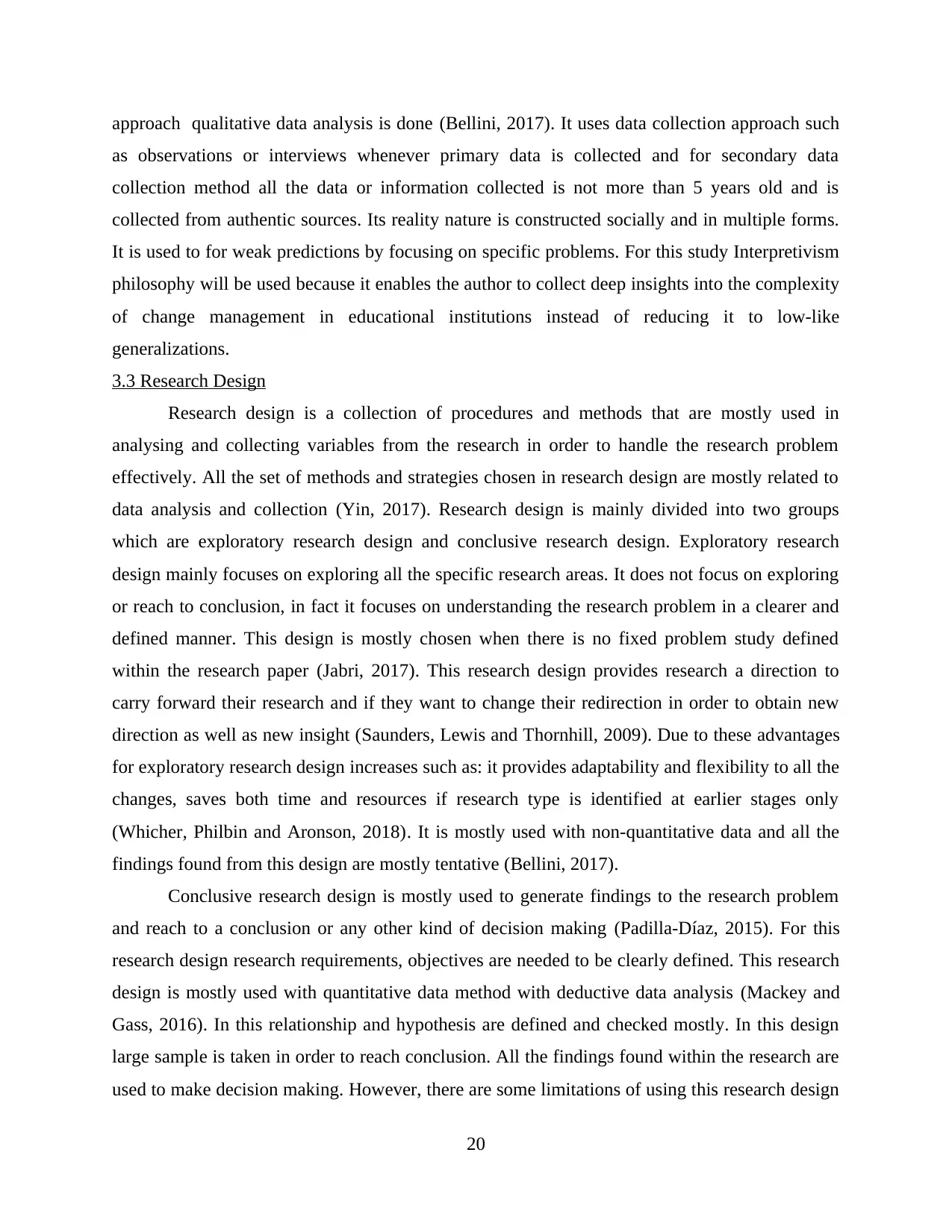
approach qualitative data analysis is done (Bellini, 2017). It uses data collection approach such
as observations or interviews whenever primary data is collected and for secondary data
collection method all the data or information collected is not more than 5 years old and is
collected from authentic sources. Its reality nature is constructed socially and in multiple forms.
It is used to for weak predictions by focusing on specific problems. For this study Interpretivism
philosophy will be used because it enables the author to collect deep insights into the complexity
of change management in educational institutions instead of reducing it to low-like
generalizations.
3.3 Research Design
Research design is a collection of procedures and methods that are mostly used in
analysing and collecting variables from the research in order to handle the research problem
effectively. All the set of methods and strategies chosen in research design are mostly related to
data analysis and collection (Yin, 2017). Research design is mainly divided into two groups
which are exploratory research design and conclusive research design. Exploratory research
design mainly focuses on exploring all the specific research areas. It does not focus on exploring
or reach to conclusion, in fact it focuses on understanding the research problem in a clearer and
defined manner. This design is mostly chosen when there is no fixed problem study defined
within the research paper (Jabri, 2017). This research design provides research a direction to
carry forward their research and if they want to change their redirection in order to obtain new
direction as well as new insight (Saunders, Lewis and Thornhill, 2009). Due to these advantages
for exploratory research design increases such as: it provides adaptability and flexibility to all the
changes, saves both time and resources if research type is identified at earlier stages only
(Whicher, Philbin and Aronson, 2018). It is mostly used with non-quantitative data and all the
findings found from this design are mostly tentative (Bellini, 2017).
Conclusive research design is mostly used to generate findings to the research problem
and reach to a conclusion or any other kind of decision making (Padilla-Díaz, 2015). For this
research design research requirements, objectives are needed to be clearly defined. This research
design is mostly used with quantitative data method with deductive data analysis (Mackey and
Gass, 2016). In this relationship and hypothesis are defined and checked mostly. In this design
large sample is taken in order to reach conclusion. All the findings found within the research are
used to make decision making. However, there are some limitations of using this research design
20
as observations or interviews whenever primary data is collected and for secondary data
collection method all the data or information collected is not more than 5 years old and is
collected from authentic sources. Its reality nature is constructed socially and in multiple forms.
It is used to for weak predictions by focusing on specific problems. For this study Interpretivism
philosophy will be used because it enables the author to collect deep insights into the complexity
of change management in educational institutions instead of reducing it to low-like
generalizations.
3.3 Research Design
Research design is a collection of procedures and methods that are mostly used in
analysing and collecting variables from the research in order to handle the research problem
effectively. All the set of methods and strategies chosen in research design are mostly related to
data analysis and collection (Yin, 2017). Research design is mainly divided into two groups
which are exploratory research design and conclusive research design. Exploratory research
design mainly focuses on exploring all the specific research areas. It does not focus on exploring
or reach to conclusion, in fact it focuses on understanding the research problem in a clearer and
defined manner. This design is mostly chosen when there is no fixed problem study defined
within the research paper (Jabri, 2017). This research design provides research a direction to
carry forward their research and if they want to change their redirection in order to obtain new
direction as well as new insight (Saunders, Lewis and Thornhill, 2009). Due to these advantages
for exploratory research design increases such as: it provides adaptability and flexibility to all the
changes, saves both time and resources if research type is identified at earlier stages only
(Whicher, Philbin and Aronson, 2018). It is mostly used with non-quantitative data and all the
findings found from this design are mostly tentative (Bellini, 2017).
Conclusive research design is mostly used to generate findings to the research problem
and reach to a conclusion or any other kind of decision making (Padilla-Díaz, 2015). For this
research design research requirements, objectives are needed to be clearly defined. This research
design is mostly used with quantitative data method with deductive data analysis (Mackey and
Gass, 2016). In this relationship and hypothesis are defined and checked mostly. In this design
large sample is taken in order to reach conclusion. All the findings found within the research are
used to make decision making. However, there are some limitations of using this research design
20
Paraphrase This Document
Need a fresh take? Get an instant paraphrase of this document with our AI Paraphraser
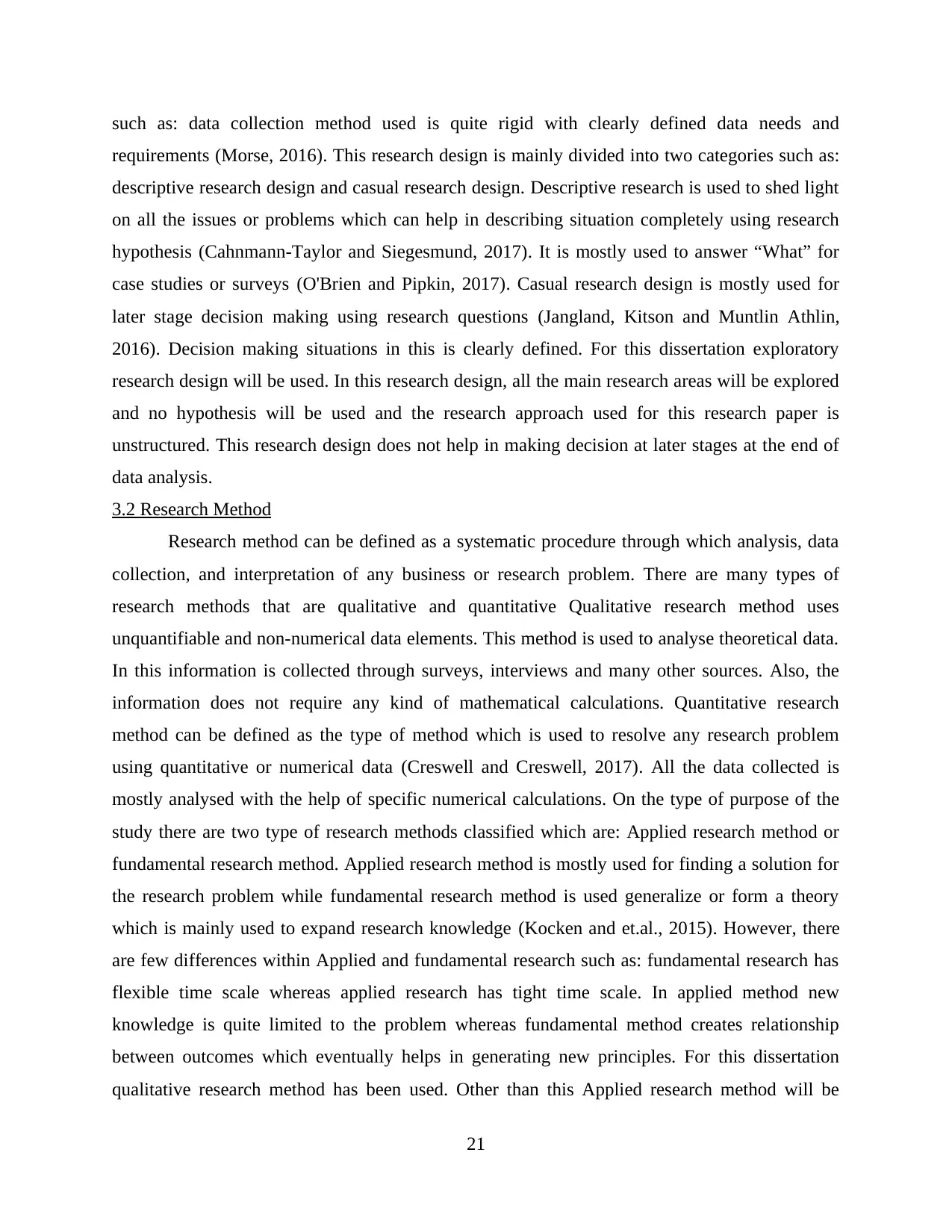
such as: data collection method used is quite rigid with clearly defined data needs and
requirements (Morse, 2016). This research design is mainly divided into two categories such as:
descriptive research design and casual research design. Descriptive research is used to shed light
on all the issues or problems which can help in describing situation completely using research
hypothesis (Cahnmann-Taylor and Siegesmund, 2017). It is mostly used to answer “What” for
case studies or surveys (O'Brien and Pipkin, 2017). Casual research design is mostly used for
later stage decision making using research questions (Jangland, Kitson and Muntlin Athlin,
2016). Decision making situations in this is clearly defined. For this dissertation exploratory
research design will be used. In this research design, all the main research areas will be explored
and no hypothesis will be used and the research approach used for this research paper is
unstructured. This research design does not help in making decision at later stages at the end of
data analysis.
3.2 Research Method
Research method can be defined as a systematic procedure through which analysis, data
collection, and interpretation of any business or research problem. There are many types of
research methods that are qualitative and quantitative Qualitative research method uses
unquantifiable and non-numerical data elements. This method is used to analyse theoretical data.
In this information is collected through surveys, interviews and many other sources. Also, the
information does not require any kind of mathematical calculations. Quantitative research
method can be defined as the type of method which is used to resolve any research problem
using quantitative or numerical data (Creswell and Creswell, 2017). All the data collected is
mostly analysed with the help of specific numerical calculations. On the type of purpose of the
study there are two type of research methods classified which are: Applied research method or
fundamental research method. Applied research method is mostly used for finding a solution for
the research problem while fundamental research method is used generalize or form a theory
which is mainly used to expand research knowledge (Kocken and et.al., 2015). However, there
are few differences within Applied and fundamental research such as: fundamental research has
flexible time scale whereas applied research has tight time scale. In applied method new
knowledge is quite limited to the problem whereas fundamental method creates relationship
between outcomes which eventually helps in generating new principles. For this dissertation
qualitative research method has been used. Other than this Applied research method will be
21
requirements (Morse, 2016). This research design is mainly divided into two categories such as:
descriptive research design and casual research design. Descriptive research is used to shed light
on all the issues or problems which can help in describing situation completely using research
hypothesis (Cahnmann-Taylor and Siegesmund, 2017). It is mostly used to answer “What” for
case studies or surveys (O'Brien and Pipkin, 2017). Casual research design is mostly used for
later stage decision making using research questions (Jangland, Kitson and Muntlin Athlin,
2016). Decision making situations in this is clearly defined. For this dissertation exploratory
research design will be used. In this research design, all the main research areas will be explored
and no hypothesis will be used and the research approach used for this research paper is
unstructured. This research design does not help in making decision at later stages at the end of
data analysis.
3.2 Research Method
Research method can be defined as a systematic procedure through which analysis, data
collection, and interpretation of any business or research problem. There are many types of
research methods that are qualitative and quantitative Qualitative research method uses
unquantifiable and non-numerical data elements. This method is used to analyse theoretical data.
In this information is collected through surveys, interviews and many other sources. Also, the
information does not require any kind of mathematical calculations. Quantitative research
method can be defined as the type of method which is used to resolve any research problem
using quantitative or numerical data (Creswell and Creswell, 2017). All the data collected is
mostly analysed with the help of specific numerical calculations. On the type of purpose of the
study there are two type of research methods classified which are: Applied research method or
fundamental research method. Applied research method is mostly used for finding a solution for
the research problem while fundamental research method is used generalize or form a theory
which is mainly used to expand research knowledge (Kocken and et.al., 2015). However, there
are few differences within Applied and fundamental research such as: fundamental research has
flexible time scale whereas applied research has tight time scale. In applied method new
knowledge is quite limited to the problem whereas fundamental method creates relationship
between outcomes which eventually helps in generating new principles. For this dissertation
qualitative research method has been used. Other than this Applied research method will be
21
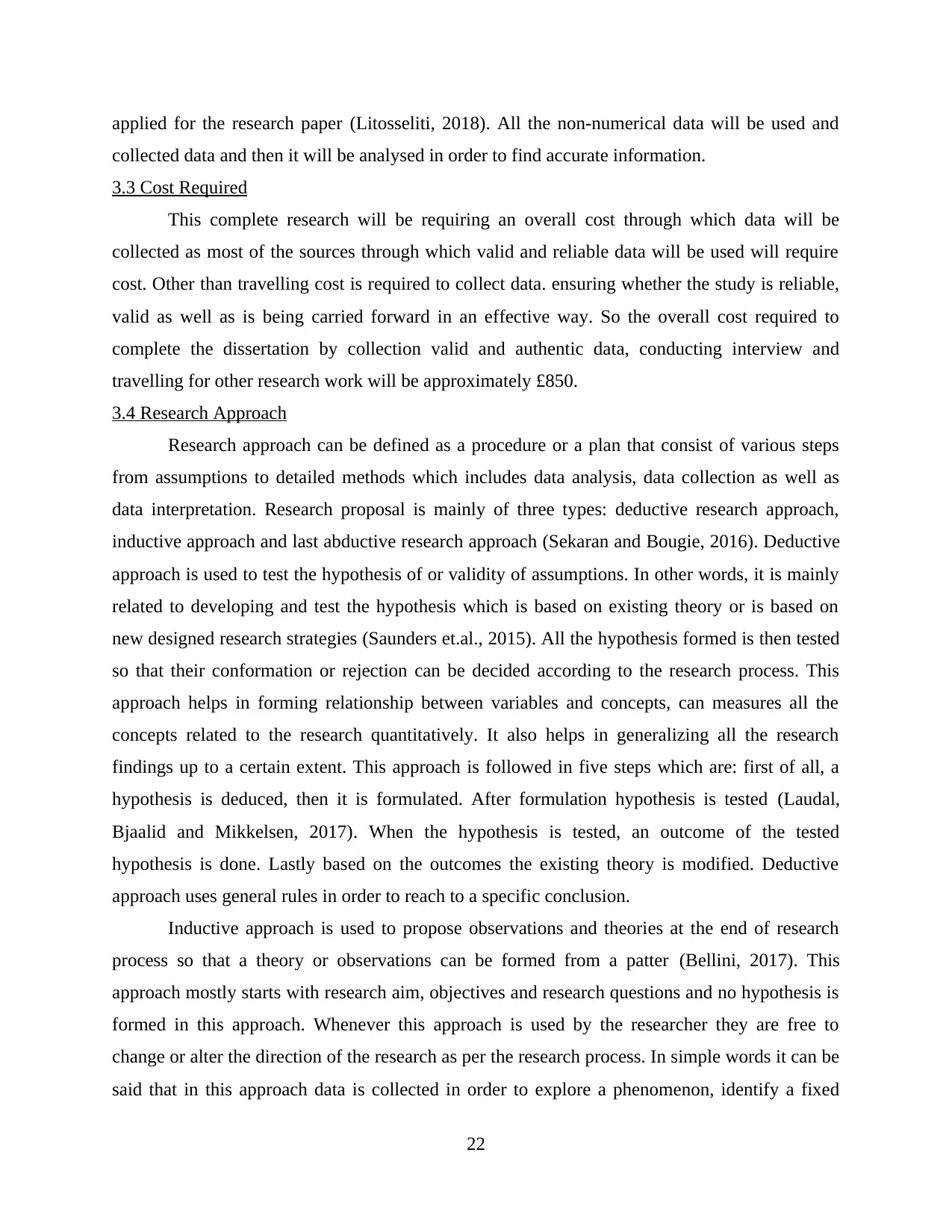
applied for the research paper (Litosseliti, 2018). All the non-numerical data will be used and
collected data and then it will be analysed in order to find accurate information.
3.3 Cost Required
This complete research will be requiring an overall cost through which data will be
collected as most of the sources through which valid and reliable data will be used will require
cost. Other than travelling cost is required to collect data. ensuring whether the study is reliable,
valid as well as is being carried forward in an effective way. So the overall cost required to
complete the dissertation by collection valid and authentic data, conducting interview and
travelling for other research work will be approximately £850.
3.4 Research Approach
Research approach can be defined as a procedure or a plan that consist of various steps
from assumptions to detailed methods which includes data analysis, data collection as well as
data interpretation. Research proposal is mainly of three types: deductive research approach,
inductive approach and last abductive research approach (Sekaran and Bougie, 2016). Deductive
approach is used to test the hypothesis of or validity of assumptions. In other words, it is mainly
related to developing and test the hypothesis which is based on existing theory or is based on
new designed research strategies (Saunders et.al., 2015). All the hypothesis formed is then tested
so that their conformation or rejection can be decided according to the research process. This
approach helps in forming relationship between variables and concepts, can measures all the
concepts related to the research quantitatively. It also helps in generalizing all the research
findings up to a certain extent. This approach is followed in five steps which are: first of all, a
hypothesis is deduced, then it is formulated. After formulation hypothesis is tested (Laudal,
Bjaalid and Mikkelsen, 2017). When the hypothesis is tested, an outcome of the tested
hypothesis is done. Lastly based on the outcomes the existing theory is modified. Deductive
approach uses general rules in order to reach to a specific conclusion.
Inductive approach is used to propose observations and theories at the end of research
process so that a theory or observations can be formed from a patter (Bellini, 2017). This
approach mostly starts with research aim, objectives and research questions and no hypothesis is
formed in this approach. Whenever this approach is used by the researcher they are free to
change or alter the direction of the research as per the research process. In simple words it can be
said that in this approach data is collected in order to explore a phenomenon, identify a fixed
22
collected data and then it will be analysed in order to find accurate information.
3.3 Cost Required
This complete research will be requiring an overall cost through which data will be
collected as most of the sources through which valid and reliable data will be used will require
cost. Other than travelling cost is required to collect data. ensuring whether the study is reliable,
valid as well as is being carried forward in an effective way. So the overall cost required to
complete the dissertation by collection valid and authentic data, conducting interview and
travelling for other research work will be approximately £850.
3.4 Research Approach
Research approach can be defined as a procedure or a plan that consist of various steps
from assumptions to detailed methods which includes data analysis, data collection as well as
data interpretation. Research proposal is mainly of three types: deductive research approach,
inductive approach and last abductive research approach (Sekaran and Bougie, 2016). Deductive
approach is used to test the hypothesis of or validity of assumptions. In other words, it is mainly
related to developing and test the hypothesis which is based on existing theory or is based on
new designed research strategies (Saunders et.al., 2015). All the hypothesis formed is then tested
so that their conformation or rejection can be decided according to the research process. This
approach helps in forming relationship between variables and concepts, can measures all the
concepts related to the research quantitatively. It also helps in generalizing all the research
findings up to a certain extent. This approach is followed in five steps which are: first of all, a
hypothesis is deduced, then it is formulated. After formulation hypothesis is tested (Laudal,
Bjaalid and Mikkelsen, 2017). When the hypothesis is tested, an outcome of the tested
hypothesis is done. Lastly based on the outcomes the existing theory is modified. Deductive
approach uses general rules in order to reach to a specific conclusion.
Inductive approach is used to propose observations and theories at the end of research
process so that a theory or observations can be formed from a patter (Bellini, 2017). This
approach mostly starts with research aim, objectives and research questions and no hypothesis is
formed in this approach. Whenever this approach is used by the researcher they are free to
change or alter the direction of the research as per the research process. In simple words it can be
said that in this approach data is collected in order to explore a phenomenon, identify a fixed
22
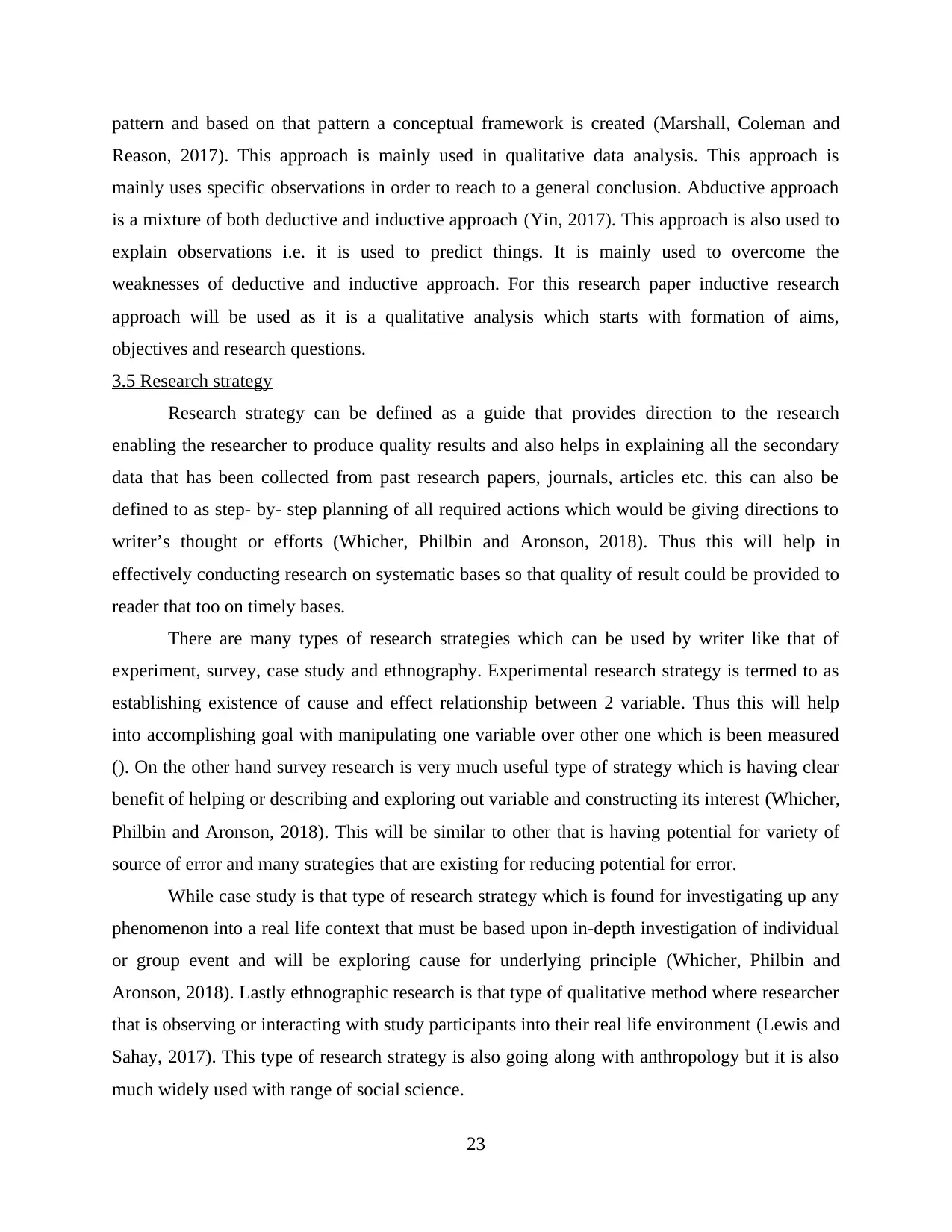
pattern and based on that pattern a conceptual framework is created (Marshall, Coleman and
Reason, 2017). This approach is mainly used in qualitative data analysis. This approach is
mainly uses specific observations in order to reach to a general conclusion. Abductive approach
is a mixture of both deductive and inductive approach (Yin, 2017). This approach is also used to
explain observations i.e. it is used to predict things. It is mainly used to overcome the
weaknesses of deductive and inductive approach. For this research paper inductive research
approach will be used as it is a qualitative analysis which starts with formation of aims,
objectives and research questions.
3.5 Research strategy
Research strategy can be defined as a guide that provides direction to the research
enabling the researcher to produce quality results and also helps in explaining all the secondary
data that has been collected from past research papers, journals, articles etc. this can also be
defined to as step- by- step planning of all required actions which would be giving directions to
writer’s thought or efforts (Whicher, Philbin and Aronson, 2018). Thus this will help in
effectively conducting research on systematic bases so that quality of result could be provided to
reader that too on timely bases.
There are many types of research strategies which can be used by writer like that of
experiment, survey, case study and ethnography. Experimental research strategy is termed to as
establishing existence of cause and effect relationship between 2 variable. Thus this will help
into accomplishing goal with manipulating one variable over other one which is been measured
(). On the other hand survey research is very much useful type of strategy which is having clear
benefit of helping or describing and exploring out variable and constructing its interest (Whicher,
Philbin and Aronson, 2018). This will be similar to other that is having potential for variety of
source of error and many strategies that are existing for reducing potential for error.
While case study is that type of research strategy which is found for investigating up any
phenomenon into a real life context that must be based upon in-depth investigation of individual
or group event and will be exploring cause for underlying principle (Whicher, Philbin and
Aronson, 2018). Lastly ethnographic research is that type of qualitative method where researcher
that is observing or interacting with study participants into their real life environment (Lewis and
Sahay, 2017). This type of research strategy is also going along with anthropology but it is also
much widely used with range of social science.
23
Reason, 2017). This approach is mainly used in qualitative data analysis. This approach is
mainly uses specific observations in order to reach to a general conclusion. Abductive approach
is a mixture of both deductive and inductive approach (Yin, 2017). This approach is also used to
explain observations i.e. it is used to predict things. It is mainly used to overcome the
weaknesses of deductive and inductive approach. For this research paper inductive research
approach will be used as it is a qualitative analysis which starts with formation of aims,
objectives and research questions.
3.5 Research strategy
Research strategy can be defined as a guide that provides direction to the research
enabling the researcher to produce quality results and also helps in explaining all the secondary
data that has been collected from past research papers, journals, articles etc. this can also be
defined to as step- by- step planning of all required actions which would be giving directions to
writer’s thought or efforts (Whicher, Philbin and Aronson, 2018). Thus this will help in
effectively conducting research on systematic bases so that quality of result could be provided to
reader that too on timely bases.
There are many types of research strategies which can be used by writer like that of
experiment, survey, case study and ethnography. Experimental research strategy is termed to as
establishing existence of cause and effect relationship between 2 variable. Thus this will help
into accomplishing goal with manipulating one variable over other one which is been measured
(). On the other hand survey research is very much useful type of strategy which is having clear
benefit of helping or describing and exploring out variable and constructing its interest (Whicher,
Philbin and Aronson, 2018). This will be similar to other that is having potential for variety of
source of error and many strategies that are existing for reducing potential for error.
While case study is that type of research strategy which is found for investigating up any
phenomenon into a real life context that must be based upon in-depth investigation of individual
or group event and will be exploring cause for underlying principle (Whicher, Philbin and
Aronson, 2018). Lastly ethnographic research is that type of qualitative method where researcher
that is observing or interacting with study participants into their real life environment (Lewis and
Sahay, 2017). This type of research strategy is also going along with anthropology but it is also
much widely used with range of social science.
23
Secure Best Marks with AI Grader
Need help grading? Try our AI Grader for instant feedback on your assignments.
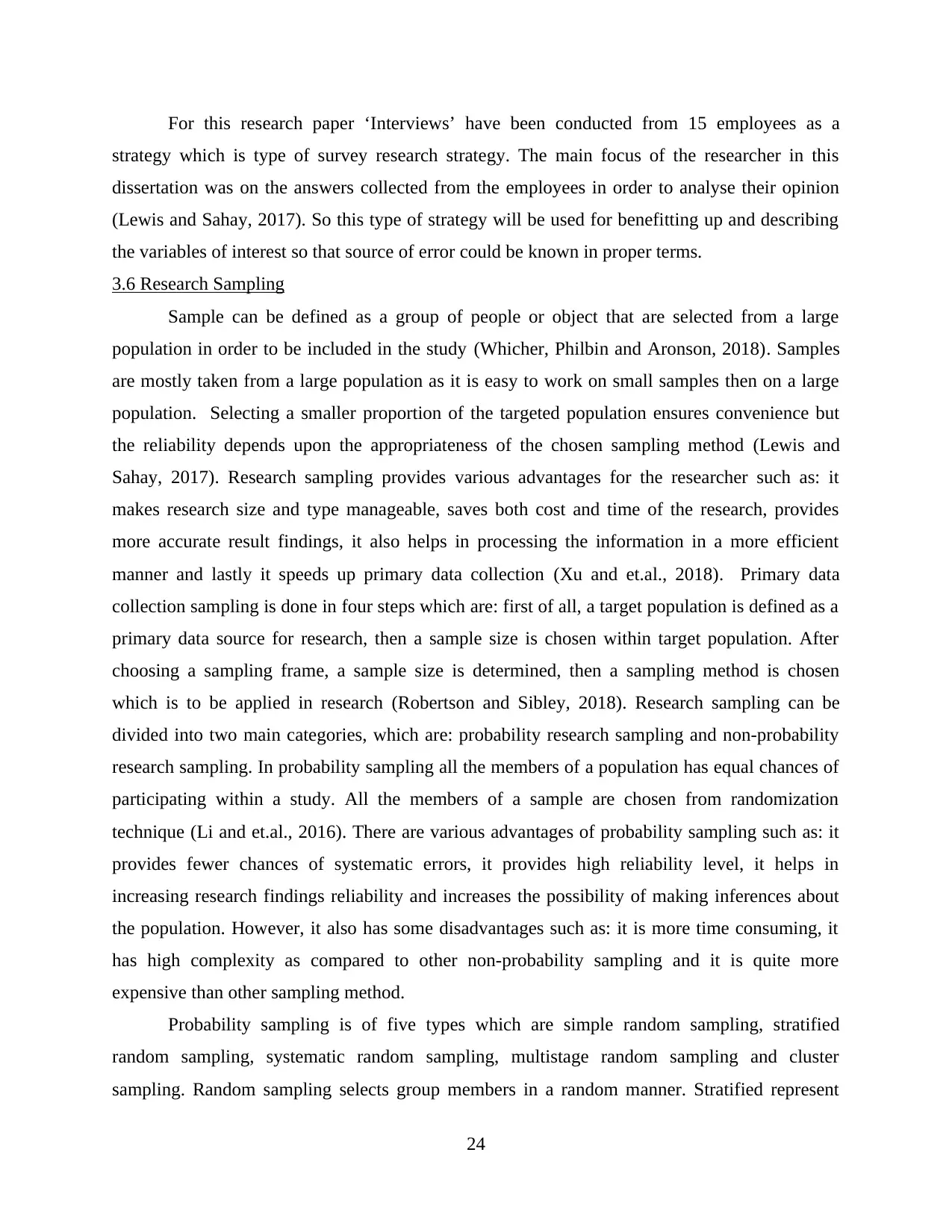
For this research paper ‘Interviews’ have been conducted from 15 employees as a
strategy which is type of survey research strategy. The main focus of the researcher in this
dissertation was on the answers collected from the employees in order to analyse their opinion
(Lewis and Sahay, 2017). So this type of strategy will be used for benefitting up and describing
the variables of interest so that source of error could be known in proper terms.
3.6 Research Sampling
Sample can be defined as a group of people or object that are selected from a large
population in order to be included in the study (Whicher, Philbin and Aronson, 2018). Samples
are mostly taken from a large population as it is easy to work on small samples then on a large
population. Selecting a smaller proportion of the targeted population ensures convenience but
the reliability depends upon the appropriateness of the chosen sampling method (Lewis and
Sahay, 2017). Research sampling provides various advantages for the researcher such as: it
makes research size and type manageable, saves both cost and time of the research, provides
more accurate result findings, it also helps in processing the information in a more efficient
manner and lastly it speeds up primary data collection (Xu and et.al., 2018). Primary data
collection sampling is done in four steps which are: first of all, a target population is defined as a
primary data source for research, then a sample size is chosen within target population. After
choosing a sampling frame, a sample size is determined, then a sampling method is chosen
which is to be applied in research (Robertson and Sibley, 2018). Research sampling can be
divided into two main categories, which are: probability research sampling and non-probability
research sampling. In probability sampling all the members of a population has equal chances of
participating within a study. All the members of a sample are chosen from randomization
technique (Li and et.al., 2016). There are various advantages of probability sampling such as: it
provides fewer chances of systematic errors, it provides high reliability level, it helps in
increasing research findings reliability and increases the possibility of making inferences about
the population. However, it also has some disadvantages such as: it is more time consuming, it
has high complexity as compared to other non-probability sampling and it is quite more
expensive than other sampling method.
Probability sampling is of five types which are simple random sampling, stratified
random sampling, systematic random sampling, multistage random sampling and cluster
sampling. Random sampling selects group members in a random manner. Stratified represent
24
strategy which is type of survey research strategy. The main focus of the researcher in this
dissertation was on the answers collected from the employees in order to analyse their opinion
(Lewis and Sahay, 2017). So this type of strategy will be used for benefitting up and describing
the variables of interest so that source of error could be known in proper terms.
3.6 Research Sampling
Sample can be defined as a group of people or object that are selected from a large
population in order to be included in the study (Whicher, Philbin and Aronson, 2018). Samples
are mostly taken from a large population as it is easy to work on small samples then on a large
population. Selecting a smaller proportion of the targeted population ensures convenience but
the reliability depends upon the appropriateness of the chosen sampling method (Lewis and
Sahay, 2017). Research sampling provides various advantages for the researcher such as: it
makes research size and type manageable, saves both cost and time of the research, provides
more accurate result findings, it also helps in processing the information in a more efficient
manner and lastly it speeds up primary data collection (Xu and et.al., 2018). Primary data
collection sampling is done in four steps which are: first of all, a target population is defined as a
primary data source for research, then a sample size is chosen within target population. After
choosing a sampling frame, a sample size is determined, then a sampling method is chosen
which is to be applied in research (Robertson and Sibley, 2018). Research sampling can be
divided into two main categories, which are: probability research sampling and non-probability
research sampling. In probability sampling all the members of a population has equal chances of
participating within a study. All the members of a sample are chosen from randomization
technique (Li and et.al., 2016). There are various advantages of probability sampling such as: it
provides fewer chances of systematic errors, it provides high reliability level, it helps in
increasing research findings reliability and increases the possibility of making inferences about
the population. However, it also has some disadvantages such as: it is more time consuming, it
has high complexity as compared to other non-probability sampling and it is quite more
expensive than other sampling method.
Probability sampling is of five types which are simple random sampling, stratified
random sampling, systematic random sampling, multistage random sampling and cluster
sampling. Random sampling selects group members in a random manner. Stratified represent
24
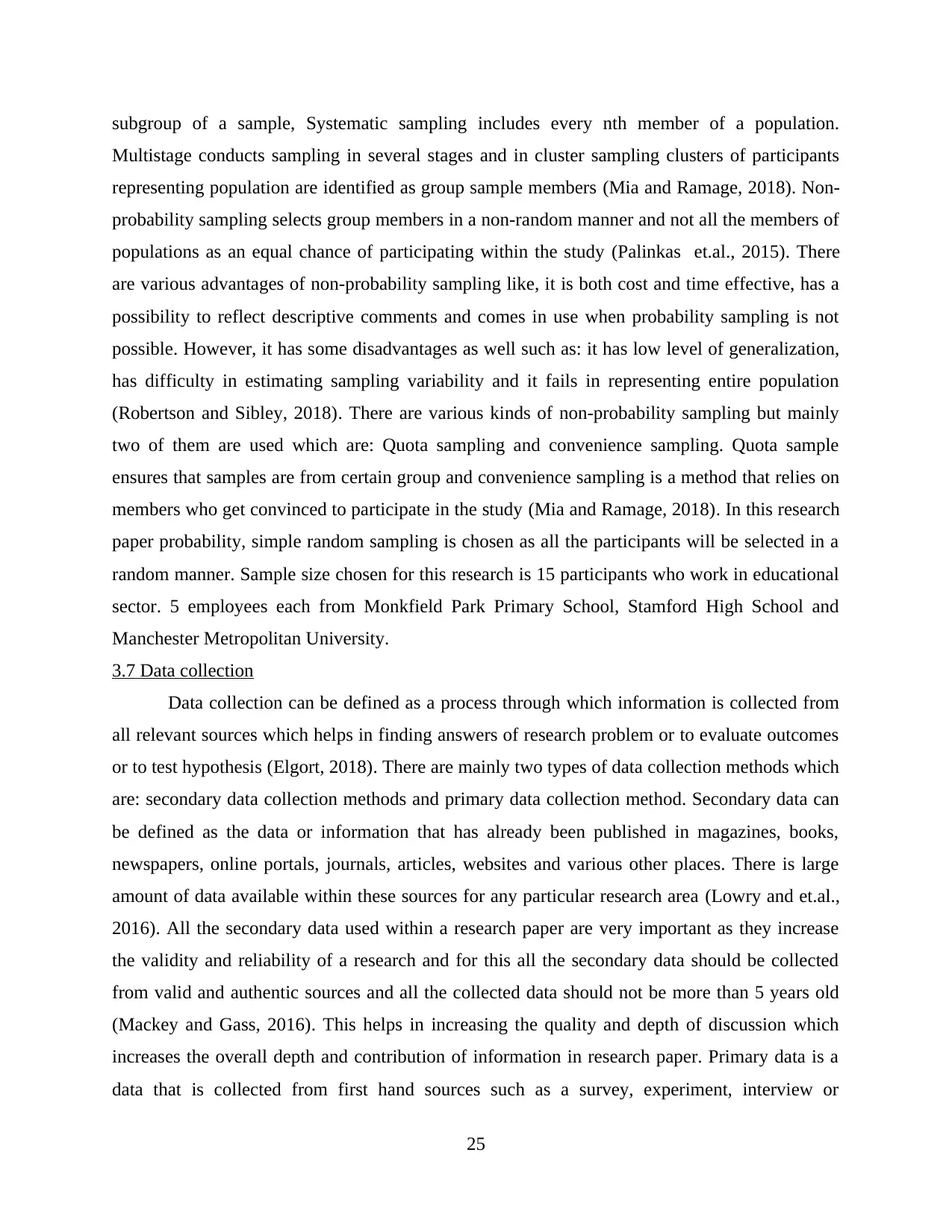
subgroup of a sample, Systematic sampling includes every nth member of a population.
Multistage conducts sampling in several stages and in cluster sampling clusters of participants
representing population are identified as group sample members (Mia and Ramage, 2018). Non-
probability sampling selects group members in a non-random manner and not all the members of
populations as an equal chance of participating within the study (Palinkas et.al., 2015). There
are various advantages of non-probability sampling like, it is both cost and time effective, has a
possibility to reflect descriptive comments and comes in use when probability sampling is not
possible. However, it has some disadvantages as well such as: it has low level of generalization,
has difficulty in estimating sampling variability and it fails in representing entire population
(Robertson and Sibley, 2018). There are various kinds of non-probability sampling but mainly
two of them are used which are: Quota sampling and convenience sampling. Quota sample
ensures that samples are from certain group and convenience sampling is a method that relies on
members who get convinced to participate in the study (Mia and Ramage, 2018). In this research
paper probability, simple random sampling is chosen as all the participants will be selected in a
random manner. Sample size chosen for this research is 15 participants who work in educational
sector. 5 employees each from Monkfield Park Primary School, Stamford High School and
Manchester Metropolitan University.
3.7 Data collection
Data collection can be defined as a process through which information is collected from
all relevant sources which helps in finding answers of research problem or to evaluate outcomes
or to test hypothesis (Elgort, 2018). There are mainly two types of data collection methods which
are: secondary data collection methods and primary data collection method. Secondary data can
be defined as the data or information that has already been published in magazines, books,
newspapers, online portals, journals, articles, websites and various other places. There is large
amount of data available within these sources for any particular research area (Lowry and et.al.,
2016). All the secondary data used within a research paper are very important as they increase
the validity and reliability of a research and for this all the secondary data should be collected
from valid and authentic sources and all the collected data should not be more than 5 years old
(Mackey and Gass, 2016). This helps in increasing the quality and depth of discussion which
increases the overall depth and contribution of information in research paper. Primary data is a
data that is collected from first hand sources such as a survey, experiment, interview or
25
Multistage conducts sampling in several stages and in cluster sampling clusters of participants
representing population are identified as group sample members (Mia and Ramage, 2018). Non-
probability sampling selects group members in a non-random manner and not all the members of
populations as an equal chance of participating within the study (Palinkas et.al., 2015). There
are various advantages of non-probability sampling like, it is both cost and time effective, has a
possibility to reflect descriptive comments and comes in use when probability sampling is not
possible. However, it has some disadvantages as well such as: it has low level of generalization,
has difficulty in estimating sampling variability and it fails in representing entire population
(Robertson and Sibley, 2018). There are various kinds of non-probability sampling but mainly
two of them are used which are: Quota sampling and convenience sampling. Quota sample
ensures that samples are from certain group and convenience sampling is a method that relies on
members who get convinced to participate in the study (Mia and Ramage, 2018). In this research
paper probability, simple random sampling is chosen as all the participants will be selected in a
random manner. Sample size chosen for this research is 15 participants who work in educational
sector. 5 employees each from Monkfield Park Primary School, Stamford High School and
Manchester Metropolitan University.
3.7 Data collection
Data collection can be defined as a process through which information is collected from
all relevant sources which helps in finding answers of research problem or to evaluate outcomes
or to test hypothesis (Elgort, 2018). There are mainly two types of data collection methods which
are: secondary data collection methods and primary data collection method. Secondary data can
be defined as the data or information that has already been published in magazines, books,
newspapers, online portals, journals, articles, websites and various other places. There is large
amount of data available within these sources for any particular research area (Lowry and et.al.,
2016). All the secondary data used within a research paper are very important as they increase
the validity and reliability of a research and for this all the secondary data should be collected
from valid and authentic sources and all the collected data should not be more than 5 years old
(Mackey and Gass, 2016). This helps in increasing the quality and depth of discussion which
increases the overall depth and contribution of information in research paper. Primary data is a
data that is collected from first hand sources such as a survey, experiment, interview or
25
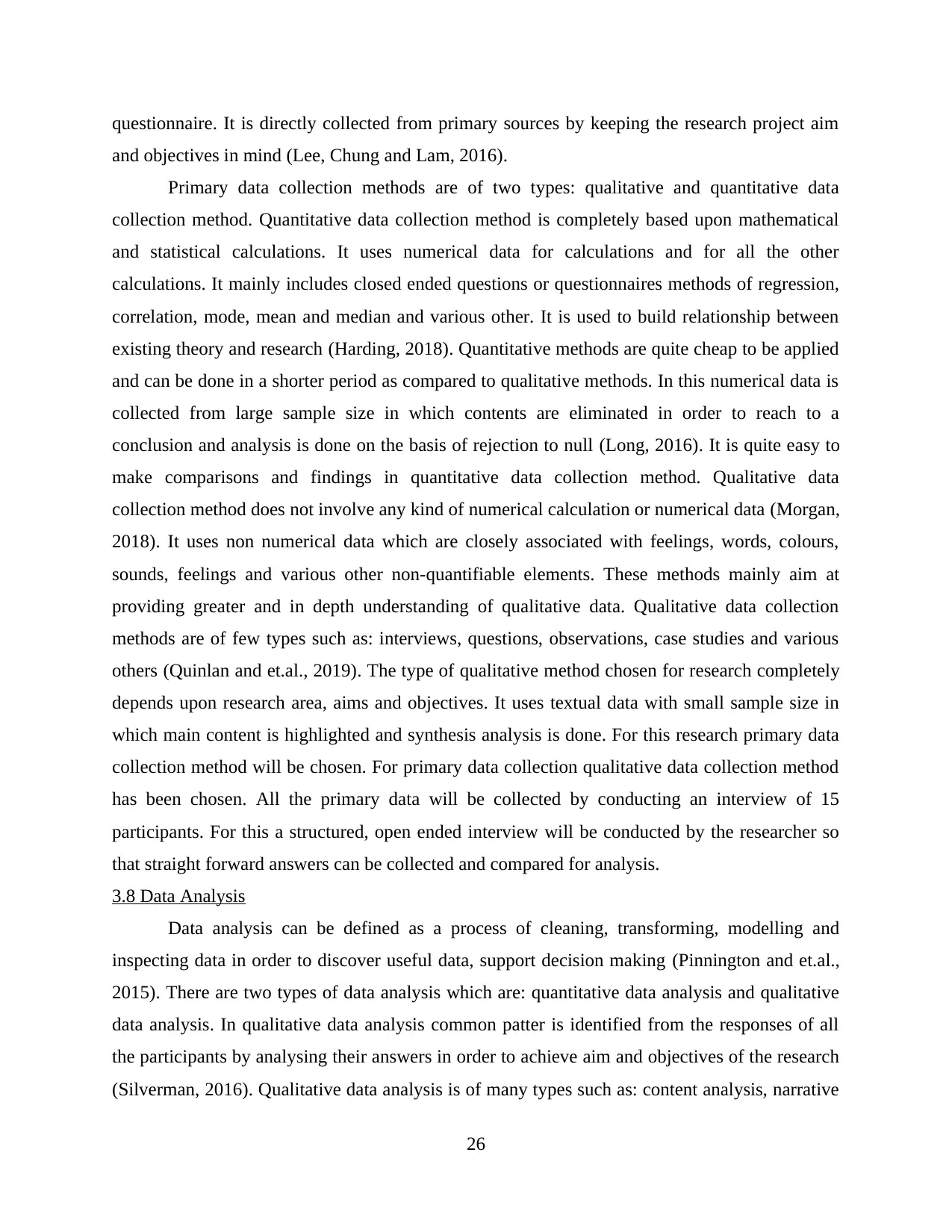
questionnaire. It is directly collected from primary sources by keeping the research project aim
and objectives in mind (Lee, Chung and Lam, 2016).
Primary data collection methods are of two types: qualitative and quantitative data
collection method. Quantitative data collection method is completely based upon mathematical
and statistical calculations. It uses numerical data for calculations and for all the other
calculations. It mainly includes closed ended questions or questionnaires methods of regression,
correlation, mode, mean and median and various other. It is used to build relationship between
existing theory and research (Harding, 2018). Quantitative methods are quite cheap to be applied
and can be done in a shorter period as compared to qualitative methods. In this numerical data is
collected from large sample size in which contents are eliminated in order to reach to a
conclusion and analysis is done on the basis of rejection to null (Long, 2016). It is quite easy to
make comparisons and findings in quantitative data collection method. Qualitative data
collection method does not involve any kind of numerical calculation or numerical data (Morgan,
2018). It uses non numerical data which are closely associated with feelings, words, colours,
sounds, feelings and various other non-quantifiable elements. These methods mainly aim at
providing greater and in depth understanding of qualitative data. Qualitative data collection
methods are of few types such as: interviews, questions, observations, case studies and various
others (Quinlan and et.al., 2019). The type of qualitative method chosen for research completely
depends upon research area, aims and objectives. It uses textual data with small sample size in
which main content is highlighted and synthesis analysis is done. For this research primary data
collection method will be chosen. For primary data collection qualitative data collection method
has been chosen. All the primary data will be collected by conducting an interview of 15
participants. For this a structured, open ended interview will be conducted by the researcher so
that straight forward answers can be collected and compared for analysis.
3.8 Data Analysis
Data analysis can be defined as a process of cleaning, transforming, modelling and
inspecting data in order to discover useful data, support decision making (Pinnington and et.al.,
2015). There are two types of data analysis which are: quantitative data analysis and qualitative
data analysis. In qualitative data analysis common patter is identified from the responses of all
the participants by analysing their answers in order to achieve aim and objectives of the research
(Silverman, 2016). Qualitative data analysis is of many types such as: content analysis, narrative
26
and objectives in mind (Lee, Chung and Lam, 2016).
Primary data collection methods are of two types: qualitative and quantitative data
collection method. Quantitative data collection method is completely based upon mathematical
and statistical calculations. It uses numerical data for calculations and for all the other
calculations. It mainly includes closed ended questions or questionnaires methods of regression,
correlation, mode, mean and median and various other. It is used to build relationship between
existing theory and research (Harding, 2018). Quantitative methods are quite cheap to be applied
and can be done in a shorter period as compared to qualitative methods. In this numerical data is
collected from large sample size in which contents are eliminated in order to reach to a
conclusion and analysis is done on the basis of rejection to null (Long, 2016). It is quite easy to
make comparisons and findings in quantitative data collection method. Qualitative data
collection method does not involve any kind of numerical calculation or numerical data (Morgan,
2018). It uses non numerical data which are closely associated with feelings, words, colours,
sounds, feelings and various other non-quantifiable elements. These methods mainly aim at
providing greater and in depth understanding of qualitative data. Qualitative data collection
methods are of few types such as: interviews, questions, observations, case studies and various
others (Quinlan and et.al., 2019). The type of qualitative method chosen for research completely
depends upon research area, aims and objectives. It uses textual data with small sample size in
which main content is highlighted and synthesis analysis is done. For this research primary data
collection method will be chosen. For primary data collection qualitative data collection method
has been chosen. All the primary data will be collected by conducting an interview of 15
participants. For this a structured, open ended interview will be conducted by the researcher so
that straight forward answers can be collected and compared for analysis.
3.8 Data Analysis
Data analysis can be defined as a process of cleaning, transforming, modelling and
inspecting data in order to discover useful data, support decision making (Pinnington and et.al.,
2015). There are two types of data analysis which are: quantitative data analysis and qualitative
data analysis. In qualitative data analysis common patter is identified from the responses of all
the participants by analysing their answers in order to achieve aim and objectives of the research
(Silverman, 2016). Qualitative data analysis is of many types such as: content analysis, narrative
26
Paraphrase This Document
Need a fresh take? Get an instant paraphrase of this document with our AI Paraphraser
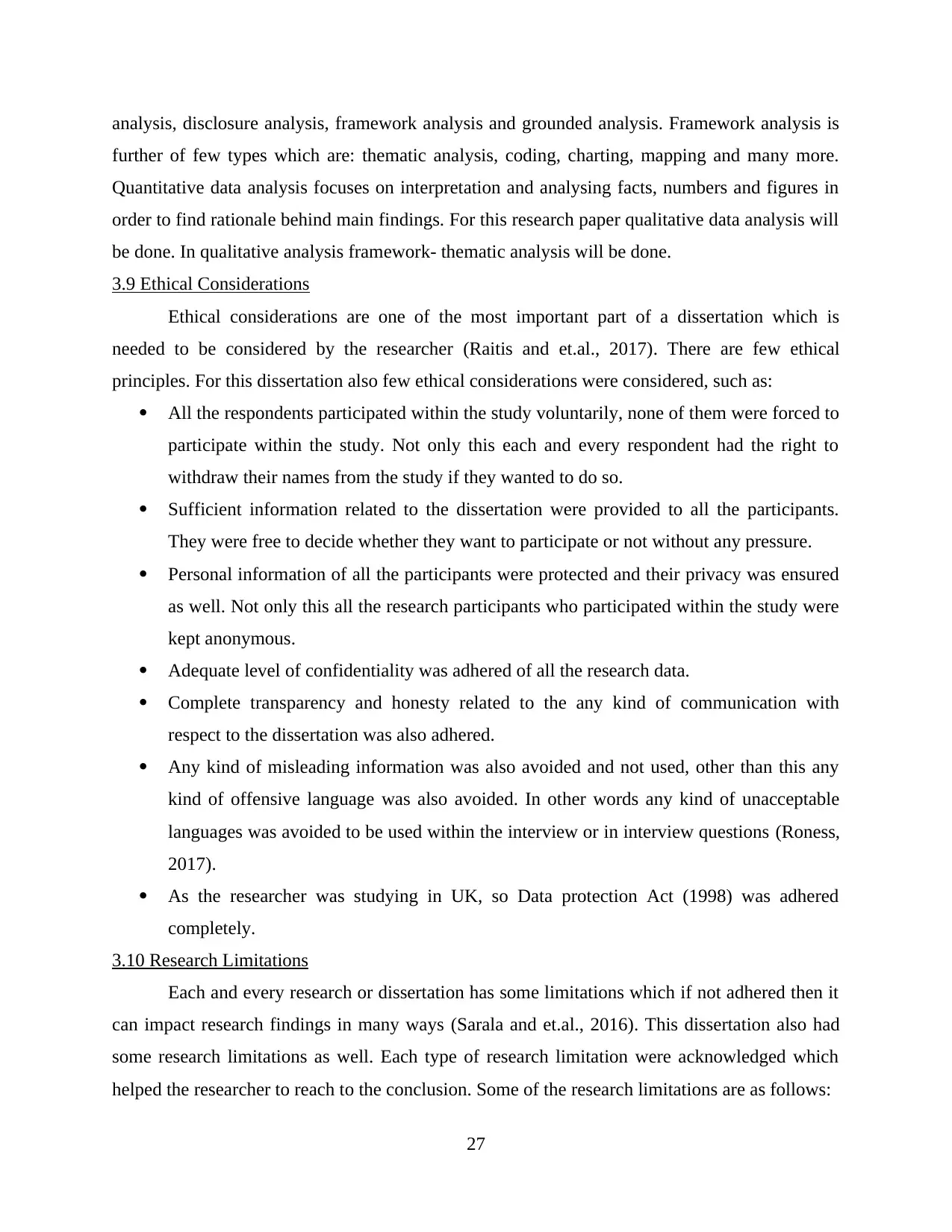
analysis, disclosure analysis, framework analysis and grounded analysis. Framework analysis is
further of few types which are: thematic analysis, coding, charting, mapping and many more.
Quantitative data analysis focuses on interpretation and analysing facts, numbers and figures in
order to find rationale behind main findings. For this research paper qualitative data analysis will
be done. In qualitative analysis framework- thematic analysis will be done.
3.9 Ethical Considerations
Ethical considerations are one of the most important part of a dissertation which is
needed to be considered by the researcher (Raitis and et.al., 2017). There are few ethical
principles. For this dissertation also few ethical considerations were considered, such as:
All the respondents participated within the study voluntarily, none of them were forced to
participate within the study. Not only this each and every respondent had the right to
withdraw their names from the study if they wanted to do so.
Sufficient information related to the dissertation were provided to all the participants.
They were free to decide whether they want to participate or not without any pressure.
Personal information of all the participants were protected and their privacy was ensured
as well. Not only this all the research participants who participated within the study were
kept anonymous.
Adequate level of confidentiality was adhered of all the research data.
Complete transparency and honesty related to the any kind of communication with
respect to the dissertation was also adhered.
Any kind of misleading information was also avoided and not used, other than this any
kind of offensive language was also avoided. In other words any kind of unacceptable
languages was avoided to be used within the interview or in interview questions (Roness,
2017).
As the researcher was studying in UK, so Data protection Act (1998) was adhered
completely.
3.10 Research Limitations
Each and every research or dissertation has some limitations which if not adhered then it
can impact research findings in many ways (Sarala and et.al., 2016). This dissertation also had
some research limitations as well. Each type of research limitation were acknowledged which
helped the researcher to reach to the conclusion. Some of the research limitations are as follows:
27
further of few types which are: thematic analysis, coding, charting, mapping and many more.
Quantitative data analysis focuses on interpretation and analysing facts, numbers and figures in
order to find rationale behind main findings. For this research paper qualitative data analysis will
be done. In qualitative analysis framework- thematic analysis will be done.
3.9 Ethical Considerations
Ethical considerations are one of the most important part of a dissertation which is
needed to be considered by the researcher (Raitis and et.al., 2017). There are few ethical
principles. For this dissertation also few ethical considerations were considered, such as:
All the respondents participated within the study voluntarily, none of them were forced to
participate within the study. Not only this each and every respondent had the right to
withdraw their names from the study if they wanted to do so.
Sufficient information related to the dissertation were provided to all the participants.
They were free to decide whether they want to participate or not without any pressure.
Personal information of all the participants were protected and their privacy was ensured
as well. Not only this all the research participants who participated within the study were
kept anonymous.
Adequate level of confidentiality was adhered of all the research data.
Complete transparency and honesty related to the any kind of communication with
respect to the dissertation was also adhered.
Any kind of misleading information was also avoided and not used, other than this any
kind of offensive language was also avoided. In other words any kind of unacceptable
languages was avoided to be used within the interview or in interview questions (Roness,
2017).
As the researcher was studying in UK, so Data protection Act (1998) was adhered
completely.
3.10 Research Limitations
Each and every research or dissertation has some limitations which if not adhered then it
can impact research findings in many ways (Sarala and et.al., 2016). This dissertation also had
some research limitations as well. Each type of research limitation were acknowledged which
helped the researcher to reach to the conclusion. Some of the research limitations are as follows:
27

One of the main limitation of this research was that researcher used interview as a data
collection method in which all the participants were not able to give proper time to
answer all the interview questions. Instead of this researcher could have conducted an
offline survey where all the respondents could have answered all the questions as per
their convenience.
Another limitation was related to qualitative data analysis method. This method was only
able to analyse the quality of data collected from the answers of the interviewees but was
not able to numerically measure the quality of the data.
Sample size was also one of the main limitations for the researcher. As researcher was
confused whether to take large sample size or small sample size. In this research used
probability sampling as the researcher took interview of all the selected 15 respondents.
They could have used non probability sampling but did not choose because small sample
size was not sufficient for identifying relationship between data sets and too large sample
size could have created problem in analysis and to generate accurate results. Therefore,
this analysis helped the researcher to choose the sample size of 15 employees. 5 from
each organization. This also helped the researcher to generate accurate results as per the
answers of all 15 employees of all the three organizations.
3.11 Summary
From the above chapter it has been summarized that for this qualitative research analysis
exploratory research design has been used, research approach used is inductive, research
philosophy used is interpretivism, sampling chosen is probability sampling. For this research
paper primary data collection methods will be chosen for data collection which will be collected
through an interview which will be conducted with 15 participants, this data will be analysed
through qualitative data analysis method. The overall cost required for this research is £850.
28
collection method in which all the participants were not able to give proper time to
answer all the interview questions. Instead of this researcher could have conducted an
offline survey where all the respondents could have answered all the questions as per
their convenience.
Another limitation was related to qualitative data analysis method. This method was only
able to analyse the quality of data collected from the answers of the interviewees but was
not able to numerically measure the quality of the data.
Sample size was also one of the main limitations for the researcher. As researcher was
confused whether to take large sample size or small sample size. In this research used
probability sampling as the researcher took interview of all the selected 15 respondents.
They could have used non probability sampling but did not choose because small sample
size was not sufficient for identifying relationship between data sets and too large sample
size could have created problem in analysis and to generate accurate results. Therefore,
this analysis helped the researcher to choose the sample size of 15 employees. 5 from
each organization. This also helped the researcher to generate accurate results as per the
answers of all 15 employees of all the three organizations.
3.11 Summary
From the above chapter it has been summarized that for this qualitative research analysis
exploratory research design has been used, research approach used is inductive, research
philosophy used is interpretivism, sampling chosen is probability sampling. For this research
paper primary data collection methods will be chosen for data collection which will be collected
through an interview which will be conducted with 15 participants, this data will be analysed
through qualitative data analysis method. The overall cost required for this research is £850.
28
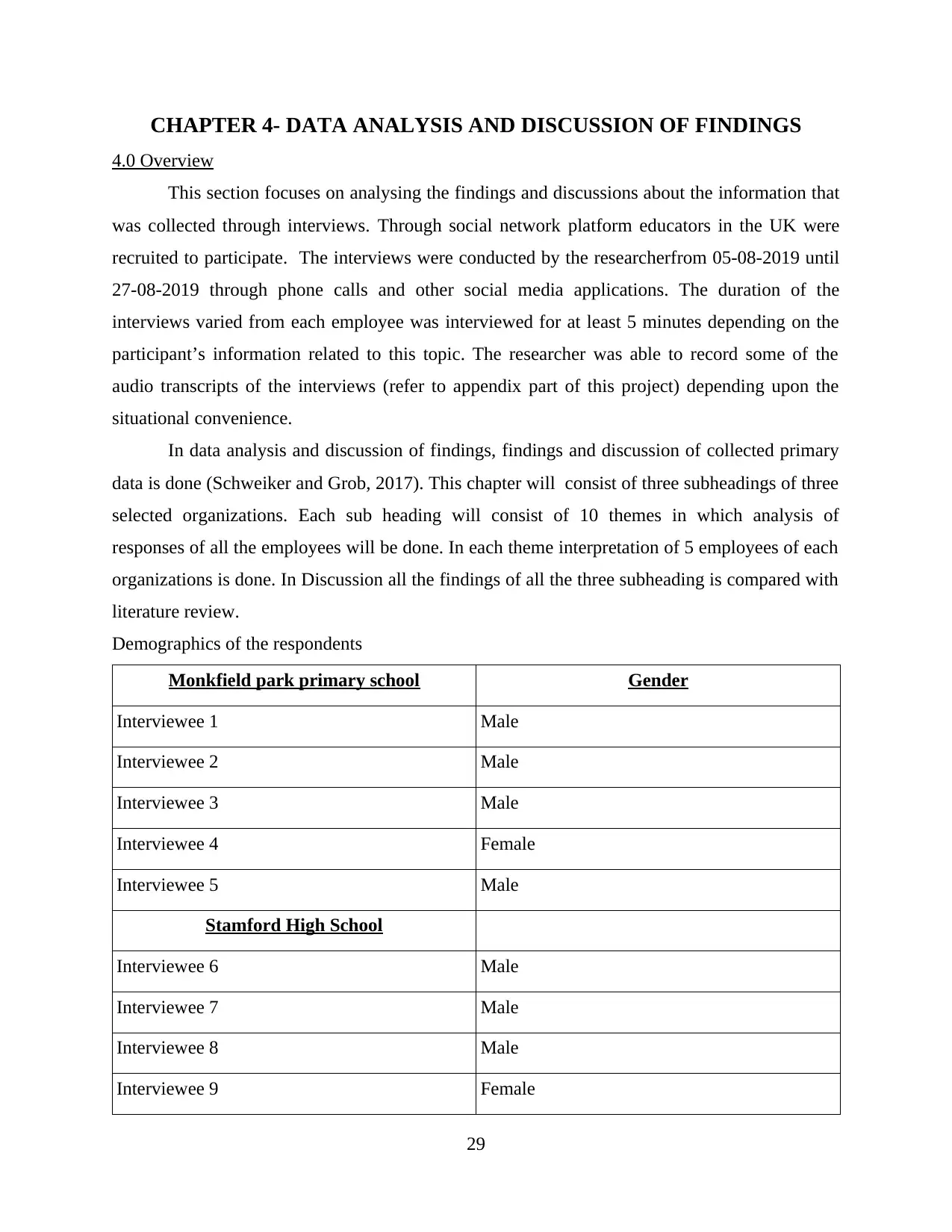
CHAPTER 4- DATA ANALYSIS AND DISCUSSION OF FINDINGS
4.0 Overview
This section focuses on analysing the findings and discussions about the information that
was collected through interviews. Through social network platform educators in the UK were
recruited to participate. The interviews were conducted by the researcherfrom 05-08-2019 until
27-08-2019 through phone calls and other social media applications. The duration of the
interviews varied from each employee was interviewed for at least 5 minutes depending on the
participant’s information related to this topic. The researcher was able to record some of the
audio transcripts of the interviews (refer to appendix part of this project) depending upon the
situational convenience.
In data analysis and discussion of findings, findings and discussion of collected primary
data is done (Schweiker and Grob, 2017). This chapter will consist of three subheadings of three
selected organizations. Each sub heading will consist of 10 themes in which analysis of
responses of all the employees will be done. In each theme interpretation of 5 employees of each
organizations is done. In Discussion all the findings of all the three subheading is compared with
literature review.
Demographics of the respondents
Monkfield park primary school Gender
Interviewee 1 Male
Interviewee 2 Male
Interviewee 3 Male
Interviewee 4 Female
Interviewee 5 Male
Stamford High School
Interviewee 6 Male
Interviewee 7 Male
Interviewee 8 Male
Interviewee 9 Female
29
4.0 Overview
This section focuses on analysing the findings and discussions about the information that
was collected through interviews. Through social network platform educators in the UK were
recruited to participate. The interviews were conducted by the researcherfrom 05-08-2019 until
27-08-2019 through phone calls and other social media applications. The duration of the
interviews varied from each employee was interviewed for at least 5 minutes depending on the
participant’s information related to this topic. The researcher was able to record some of the
audio transcripts of the interviews (refer to appendix part of this project) depending upon the
situational convenience.
In data analysis and discussion of findings, findings and discussion of collected primary
data is done (Schweiker and Grob, 2017). This chapter will consist of three subheadings of three
selected organizations. Each sub heading will consist of 10 themes in which analysis of
responses of all the employees will be done. In each theme interpretation of 5 employees of each
organizations is done. In Discussion all the findings of all the three subheading is compared with
literature review.
Demographics of the respondents
Monkfield park primary school Gender
Interviewee 1 Male
Interviewee 2 Male
Interviewee 3 Male
Interviewee 4 Female
Interviewee 5 Male
Stamford High School
Interviewee 6 Male
Interviewee 7 Male
Interviewee 8 Male
Interviewee 9 Female
29
Secure Best Marks with AI Grader
Need help grading? Try our AI Grader for instant feedback on your assignments.

Interviewee 10 Female
Manchester Metropolitan University
Interviewee 11 Male
Interviewee 12 Male
Interviewee 13 Female
Interviewee 14 Female
Interviewee 15 Female
4.1 Monkfield park primary school
Theme 1: Relationship between employees behaviour and organizational changes
Interpretation: Viewpoint of all the five teachers was quite similar. According to respondent 1
there is a direct relationship between employees behaviour and organizational change.
respondent two supported this statement and explained that these organizational changes directly
affect employee's behaviour. 3rd respondent explained it further by adding that most of the
organizational changes affect an employees' behaviour positively only few of them affect
negatively. 4th respondent expressed his viewpoint and said that “Yes, I believe there is a direct
relationship between and Organizational changes” and similarly viewpoints of 5th respondent
were also similar as she said that “Yes, according to me organizational changes does affect
employees behaviour”.
Theme 2: Effect of organizational changes on working of an organisation
Interpretation: Viewpoint of all the respondents were not similar, in fact one of them had no
idea about it and one of them said that “No, I don't think so that organizational changes have an
effect on working of an organization”. However, viewpoint of other three respondents were quite
similar and supported this question. One respondent said that “Yes, organizational changes does
have an effect on working of an organization”. Second respondent also supported this question
and expressed his opinion by saying that “As per my opinion yes, organizational changes directly
affect working of an organization”. Similarly, third respondent also supported this question and
30
Manchester Metropolitan University
Interviewee 11 Male
Interviewee 12 Male
Interviewee 13 Female
Interviewee 14 Female
Interviewee 15 Female
4.1 Monkfield park primary school
Theme 1: Relationship between employees behaviour and organizational changes
Interpretation: Viewpoint of all the five teachers was quite similar. According to respondent 1
there is a direct relationship between employees behaviour and organizational change.
respondent two supported this statement and explained that these organizational changes directly
affect employee's behaviour. 3rd respondent explained it further by adding that most of the
organizational changes affect an employees' behaviour positively only few of them affect
negatively. 4th respondent expressed his viewpoint and said that “Yes, I believe there is a direct
relationship between and Organizational changes” and similarly viewpoints of 5th respondent
were also similar as she said that “Yes, according to me organizational changes does affect
employees behaviour”.
Theme 2: Effect of organizational changes on working of an organisation
Interpretation: Viewpoint of all the respondents were not similar, in fact one of them had no
idea about it and one of them said that “No, I don't think so that organizational changes have an
effect on working of an organization”. However, viewpoint of other three respondents were quite
similar and supported this question. One respondent said that “Yes, organizational changes does
have an effect on working of an organization”. Second respondent also supported this question
and expressed his opinion by saying that “As per my opinion yes, organizational changes directly
affect working of an organization”. Similarly, third respondent also supported this question and
30
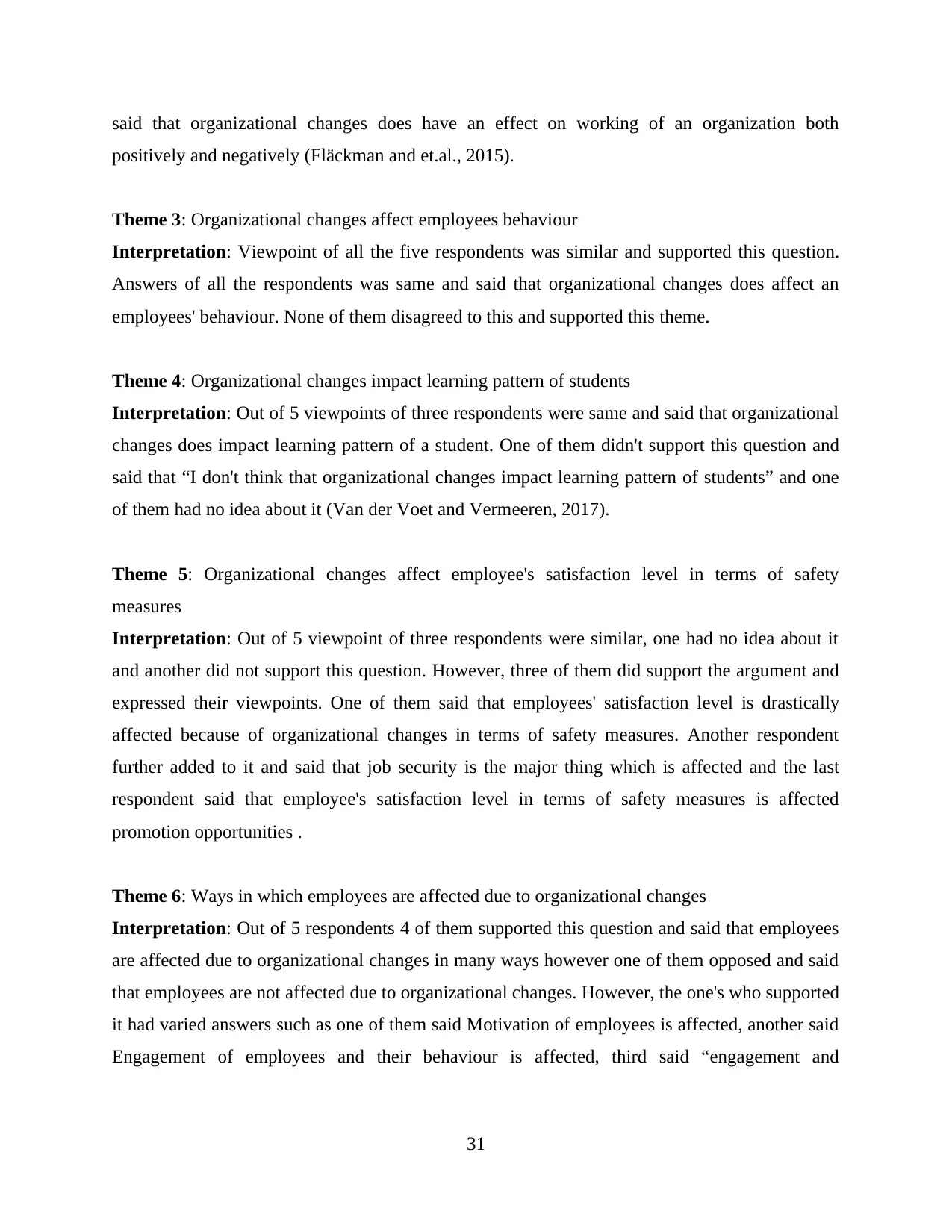
said that organizational changes does have an effect on working of an organization both
positively and negatively (Fläckman and et.al., 2015).
Theme 3: Organizational changes affect employees behaviour
Interpretation: Viewpoint of all the five respondents was similar and supported this question.
Answers of all the respondents was same and said that organizational changes does affect an
employees' behaviour. None of them disagreed to this and supported this theme.
Theme 4: Organizational changes impact learning pattern of students
Interpretation: Out of 5 viewpoints of three respondents were same and said that organizational
changes does impact learning pattern of a student. One of them didn't support this question and
said that “I don't think that organizational changes impact learning pattern of students” and one
of them had no idea about it (Van der Voet and Vermeeren, 2017).
Theme 5: Organizational changes affect employee's satisfaction level in terms of safety
measures
Interpretation: Out of 5 viewpoint of three respondents were similar, one had no idea about it
and another did not support this question. However, three of them did support the argument and
expressed their viewpoints. One of them said that employees' satisfaction level is drastically
affected because of organizational changes in terms of safety measures. Another respondent
further added to it and said that job security is the major thing which is affected and the last
respondent said that employee's satisfaction level in terms of safety measures is affected
promotion opportunities .
Theme 6: Ways in which employees are affected due to organizational changes
Interpretation: Out of 5 respondents 4 of them supported this question and said that employees
are affected due to organizational changes in many ways however one of them opposed and said
that employees are not affected due to organizational changes. However, the one's who supported
it had varied answers such as one of them said Motivation of employees is affected, another said
Engagement of employees and their behaviour is affected, third said “engagement and
31
positively and negatively (Fläckman and et.al., 2015).
Theme 3: Organizational changes affect employees behaviour
Interpretation: Viewpoint of all the five respondents was similar and supported this question.
Answers of all the respondents was same and said that organizational changes does affect an
employees' behaviour. None of them disagreed to this and supported this theme.
Theme 4: Organizational changes impact learning pattern of students
Interpretation: Out of 5 viewpoints of three respondents were same and said that organizational
changes does impact learning pattern of a student. One of them didn't support this question and
said that “I don't think that organizational changes impact learning pattern of students” and one
of them had no idea about it (Van der Voet and Vermeeren, 2017).
Theme 5: Organizational changes affect employee's satisfaction level in terms of safety
measures
Interpretation: Out of 5 viewpoint of three respondents were similar, one had no idea about it
and another did not support this question. However, three of them did support the argument and
expressed their viewpoints. One of them said that employees' satisfaction level is drastically
affected because of organizational changes in terms of safety measures. Another respondent
further added to it and said that job security is the major thing which is affected and the last
respondent said that employee's satisfaction level in terms of safety measures is affected
promotion opportunities .
Theme 6: Ways in which employees are affected due to organizational changes
Interpretation: Out of 5 respondents 4 of them supported this question and said that employees
are affected due to organizational changes in many ways however one of them opposed and said
that employees are not affected due to organizational changes. However, the one's who supported
it had varied answers such as one of them said Motivation of employees is affected, another said
Engagement of employees and their behaviour is affected, third said “engagement and
31

motivation of employees as well as their behaviour is affected” and fourth said that only
behaviour of an employee.
Theme 7: Working environment get affected by the organizational changes
Interpretation: Viewpoint of each and every teach was quite different from others. One of them
had no idea about it. Another didn't think that working environment of an organization is
affected by the organisational changes. Third respondent said that due to organizational changes
work related stress can either get increased or decreased. Fourth respondent said that “Either a
positive working environment will be build are organizational changes will create a negative
working environment” and the last respondent said that working environment is only affected
positively due to organizational changes (Day, Gu and Sammons, 2016).
Theme 8: Employees performance get affected due to the organizational changes
Interpretation: View point of two respondents contradicted with the viewpoint of three
respondents as two of them didn't support the question by saying “No employees' performance
does not get affected due to organizational changes” and three of them supported by saying that
employee's performance does get affected and can either get enhanced or degraded due to
organizational changes.
Theme 9: Organizational changes easily accepted or not
Interpretation: Similarly, View point of two respondents contradicted with the viewpoint of
three respondents where two of them didn't support the question and three of them supported.
respondents who supported the questions said that organizational changes are easily acceptable
but only positive, whereas respondents who didn't supported the argument said that
organizational changes are not easily acceptable.
Theme 10: Suggestion regarding how organisational change could be undertaken by your
educational institution
Interpretation: Out of five respondents, 3 of them did not want to give any kind of suggestion
regarding the ways organizational changes can be undertaken by their institute. However, two of
them provided some suggestions such as: one of them said that before implementing any kind of
32
behaviour of an employee.
Theme 7: Working environment get affected by the organizational changes
Interpretation: Viewpoint of each and every teach was quite different from others. One of them
had no idea about it. Another didn't think that working environment of an organization is
affected by the organisational changes. Third respondent said that due to organizational changes
work related stress can either get increased or decreased. Fourth respondent said that “Either a
positive working environment will be build are organizational changes will create a negative
working environment” and the last respondent said that working environment is only affected
positively due to organizational changes (Day, Gu and Sammons, 2016).
Theme 8: Employees performance get affected due to the organizational changes
Interpretation: View point of two respondents contradicted with the viewpoint of three
respondents as two of them didn't support the question by saying “No employees' performance
does not get affected due to organizational changes” and three of them supported by saying that
employee's performance does get affected and can either get enhanced or degraded due to
organizational changes.
Theme 9: Organizational changes easily accepted or not
Interpretation: Similarly, View point of two respondents contradicted with the viewpoint of
three respondents where two of them didn't support the question and three of them supported.
respondents who supported the questions said that organizational changes are easily acceptable
but only positive, whereas respondents who didn't supported the argument said that
organizational changes are not easily acceptable.
Theme 10: Suggestion regarding how organisational change could be undertaken by your
educational institution
Interpretation: Out of five respondents, 3 of them did not want to give any kind of suggestion
regarding the ways organizational changes can be undertaken by their institute. However, two of
them provided some suggestions such as: one of them said that before implementing any kind of
32
Paraphrase This Document
Need a fresh take? Get an instant paraphrase of this document with our AI Paraphraser
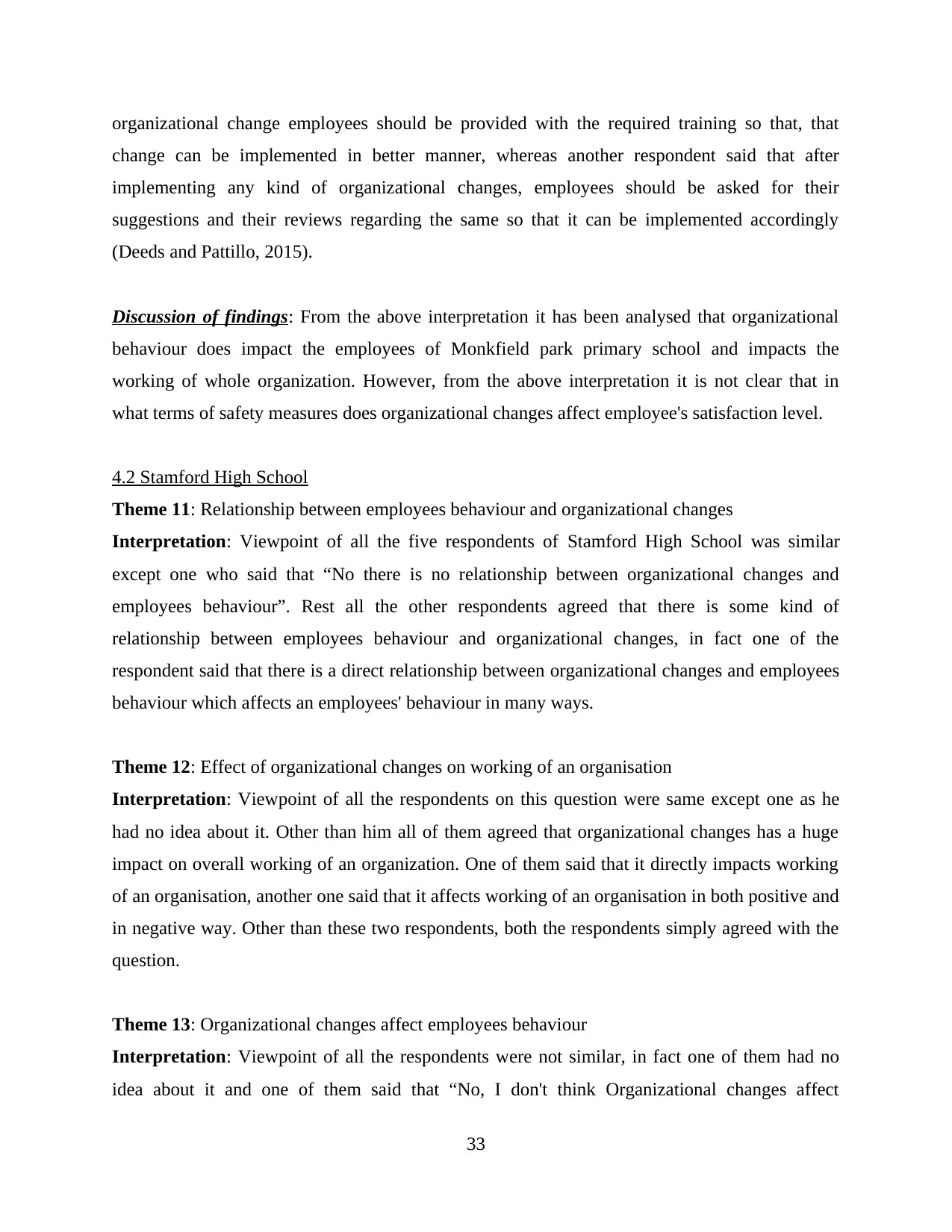
organizational change employees should be provided with the required training so that, that
change can be implemented in better manner, whereas another respondent said that after
implementing any kind of organizational changes, employees should be asked for their
suggestions and their reviews regarding the same so that it can be implemented accordingly
(Deeds and Pattillo, 2015).
Discussion of findings: From the above interpretation it has been analysed that organizational
behaviour does impact the employees of Monkfield park primary school and impacts the
working of whole organization. However, from the above interpretation it is not clear that in
what terms of safety measures does organizational changes affect employee's satisfaction level.
4.2 Stamford High School
Theme 11: Relationship between employees behaviour and organizational changes
Interpretation: Viewpoint of all the five respondents of Stamford High School was similar
except one who said that “No there is no relationship between organizational changes and
employees behaviour”. Rest all the other respondents agreed that there is some kind of
relationship between employees behaviour and organizational changes, in fact one of the
respondent said that there is a direct relationship between organizational changes and employees
behaviour which affects an employees' behaviour in many ways.
Theme 12: Effect of organizational changes on working of an organisation
Interpretation: Viewpoint of all the respondents on this question were same except one as he
had no idea about it. Other than him all of them agreed that organizational changes has a huge
impact on overall working of an organization. One of them said that it directly impacts working
of an organisation, another one said that it affects working of an organisation in both positive and
in negative way. Other than these two respondents, both the respondents simply agreed with the
question.
Theme 13: Organizational changes affect employees behaviour
Interpretation: Viewpoint of all the respondents were not similar, in fact one of them had no
idea about it and one of them said that “No, I don't think Organizational changes affect
33
change can be implemented in better manner, whereas another respondent said that after
implementing any kind of organizational changes, employees should be asked for their
suggestions and their reviews regarding the same so that it can be implemented accordingly
(Deeds and Pattillo, 2015).
Discussion of findings: From the above interpretation it has been analysed that organizational
behaviour does impact the employees of Monkfield park primary school and impacts the
working of whole organization. However, from the above interpretation it is not clear that in
what terms of safety measures does organizational changes affect employee's satisfaction level.
4.2 Stamford High School
Theme 11: Relationship between employees behaviour and organizational changes
Interpretation: Viewpoint of all the five respondents of Stamford High School was similar
except one who said that “No there is no relationship between organizational changes and
employees behaviour”. Rest all the other respondents agreed that there is some kind of
relationship between employees behaviour and organizational changes, in fact one of the
respondent said that there is a direct relationship between organizational changes and employees
behaviour which affects an employees' behaviour in many ways.
Theme 12: Effect of organizational changes on working of an organisation
Interpretation: Viewpoint of all the respondents on this question were same except one as he
had no idea about it. Other than him all of them agreed that organizational changes has a huge
impact on overall working of an organization. One of them said that it directly impacts working
of an organisation, another one said that it affects working of an organisation in both positive and
in negative way. Other than these two respondents, both the respondents simply agreed with the
question.
Theme 13: Organizational changes affect employees behaviour
Interpretation: Viewpoint of all the respondents were not similar, in fact one of them had no
idea about it and one of them said that “No, I don't think Organizational changes affect
33
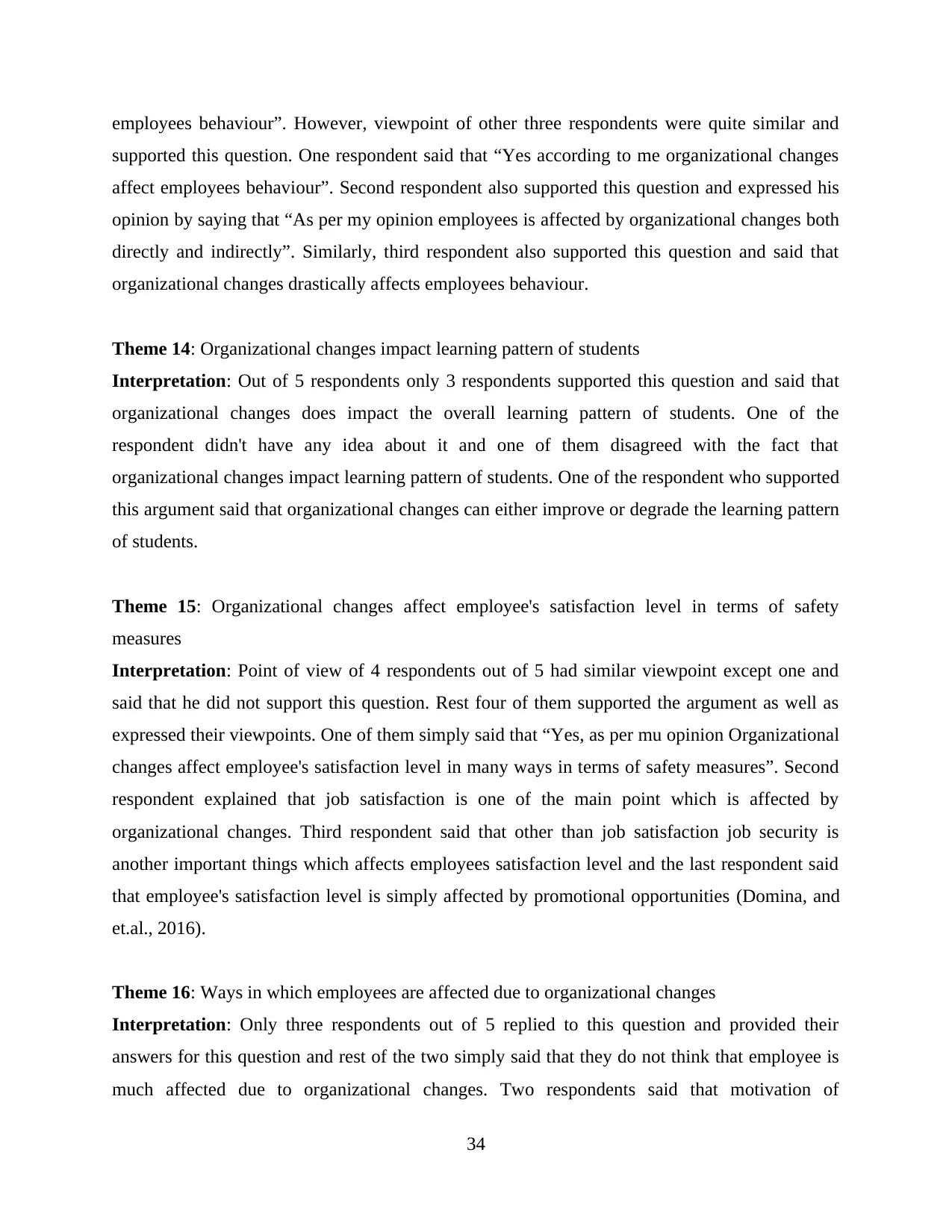
employees behaviour”. However, viewpoint of other three respondents were quite similar and
supported this question. One respondent said that “Yes according to me organizational changes
affect employees behaviour”. Second respondent also supported this question and expressed his
opinion by saying that “As per my opinion employees is affected by organizational changes both
directly and indirectly”. Similarly, third respondent also supported this question and said that
organizational changes drastically affects employees behaviour.
Theme 14: Organizational changes impact learning pattern of students
Interpretation: Out of 5 respondents only 3 respondents supported this question and said that
organizational changes does impact the overall learning pattern of students. One of the
respondent didn't have any idea about it and one of them disagreed with the fact that
organizational changes impact learning pattern of students. One of the respondent who supported
this argument said that organizational changes can either improve or degrade the learning pattern
of students.
Theme 15: Organizational changes affect employee's satisfaction level in terms of safety
measures
Interpretation: Point of view of 4 respondents out of 5 had similar viewpoint except one and
said that he did not support this question. Rest four of them supported the argument as well as
expressed their viewpoints. One of them simply said that “Yes, as per mu opinion Organizational
changes affect employee's satisfaction level in many ways in terms of safety measures”. Second
respondent explained that job satisfaction is one of the main point which is affected by
organizational changes. Third respondent said that other than job satisfaction job security is
another important things which affects employees satisfaction level and the last respondent said
that employee's satisfaction level is simply affected by promotional opportunities (Domina, and
et.al., 2016).
Theme 16: Ways in which employees are affected due to organizational changes
Interpretation: Only three respondents out of 5 replied to this question and provided their
answers for this question and rest of the two simply said that they do not think that employee is
much affected due to organizational changes. Two respondents said that motivation of
34
supported this question. One respondent said that “Yes according to me organizational changes
affect employees behaviour”. Second respondent also supported this question and expressed his
opinion by saying that “As per my opinion employees is affected by organizational changes both
directly and indirectly”. Similarly, third respondent also supported this question and said that
organizational changes drastically affects employees behaviour.
Theme 14: Organizational changes impact learning pattern of students
Interpretation: Out of 5 respondents only 3 respondents supported this question and said that
organizational changes does impact the overall learning pattern of students. One of the
respondent didn't have any idea about it and one of them disagreed with the fact that
organizational changes impact learning pattern of students. One of the respondent who supported
this argument said that organizational changes can either improve or degrade the learning pattern
of students.
Theme 15: Organizational changes affect employee's satisfaction level in terms of safety
measures
Interpretation: Point of view of 4 respondents out of 5 had similar viewpoint except one and
said that he did not support this question. Rest four of them supported the argument as well as
expressed their viewpoints. One of them simply said that “Yes, as per mu opinion Organizational
changes affect employee's satisfaction level in many ways in terms of safety measures”. Second
respondent explained that job satisfaction is one of the main point which is affected by
organizational changes. Third respondent said that other than job satisfaction job security is
another important things which affects employees satisfaction level and the last respondent said
that employee's satisfaction level is simply affected by promotional opportunities (Domina, and
et.al., 2016).
Theme 16: Ways in which employees are affected due to organizational changes
Interpretation: Only three respondents out of 5 replied to this question and provided their
answers for this question and rest of the two simply said that they do not think that employee is
much affected due to organizational changes. Two respondents said that motivation of
34
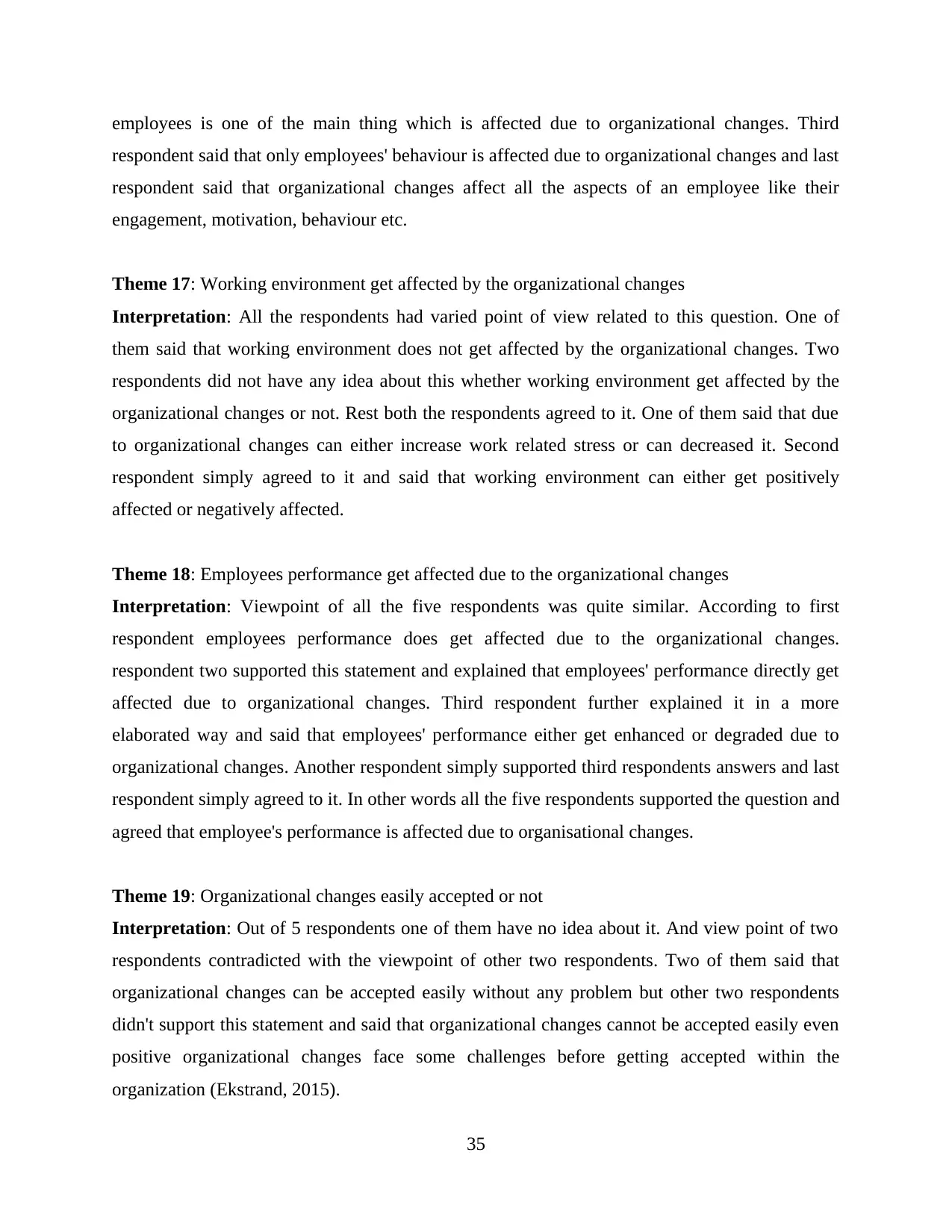
employees is one of the main thing which is affected due to organizational changes. Third
respondent said that only employees' behaviour is affected due to organizational changes and last
respondent said that organizational changes affect all the aspects of an employee like their
engagement, motivation, behaviour etc.
Theme 17: Working environment get affected by the organizational changes
Interpretation: All the respondents had varied point of view related to this question. One of
them said that working environment does not get affected by the organizational changes. Two
respondents did not have any idea about this whether working environment get affected by the
organizational changes or not. Rest both the respondents agreed to it. One of them said that due
to organizational changes can either increase work related stress or can decreased it. Second
respondent simply agreed to it and said that working environment can either get positively
affected or negatively affected.
Theme 18: Employees performance get affected due to the organizational changes
Interpretation: Viewpoint of all the five respondents was quite similar. According to first
respondent employees performance does get affected due to the organizational changes.
respondent two supported this statement and explained that employees' performance directly get
affected due to organizational changes. Third respondent further explained it in a more
elaborated way and said that employees' performance either get enhanced or degraded due to
organizational changes. Another respondent simply supported third respondents answers and last
respondent simply agreed to it. In other words all the five respondents supported the question and
agreed that employee's performance is affected due to organisational changes.
Theme 19: Organizational changes easily accepted or not
Interpretation: Out of 5 respondents one of them have no idea about it. And view point of two
respondents contradicted with the viewpoint of other two respondents. Two of them said that
organizational changes can be accepted easily without any problem but other two respondents
didn't support this statement and said that organizational changes cannot be accepted easily even
positive organizational changes face some challenges before getting accepted within the
organization (Ekstrand, 2015).
35
respondent said that only employees' behaviour is affected due to organizational changes and last
respondent said that organizational changes affect all the aspects of an employee like their
engagement, motivation, behaviour etc.
Theme 17: Working environment get affected by the organizational changes
Interpretation: All the respondents had varied point of view related to this question. One of
them said that working environment does not get affected by the organizational changes. Two
respondents did not have any idea about this whether working environment get affected by the
organizational changes or not. Rest both the respondents agreed to it. One of them said that due
to organizational changes can either increase work related stress or can decreased it. Second
respondent simply agreed to it and said that working environment can either get positively
affected or negatively affected.
Theme 18: Employees performance get affected due to the organizational changes
Interpretation: Viewpoint of all the five respondents was quite similar. According to first
respondent employees performance does get affected due to the organizational changes.
respondent two supported this statement and explained that employees' performance directly get
affected due to organizational changes. Third respondent further explained it in a more
elaborated way and said that employees' performance either get enhanced or degraded due to
organizational changes. Another respondent simply supported third respondents answers and last
respondent simply agreed to it. In other words all the five respondents supported the question and
agreed that employee's performance is affected due to organisational changes.
Theme 19: Organizational changes easily accepted or not
Interpretation: Out of 5 respondents one of them have no idea about it. And view point of two
respondents contradicted with the viewpoint of other two respondents. Two of them said that
organizational changes can be accepted easily without any problem but other two respondents
didn't support this statement and said that organizational changes cannot be accepted easily even
positive organizational changes face some challenges before getting accepted within the
organization (Ekstrand, 2015).
35
Secure Best Marks with AI Grader
Need help grading? Try our AI Grader for instant feedback on your assignments.
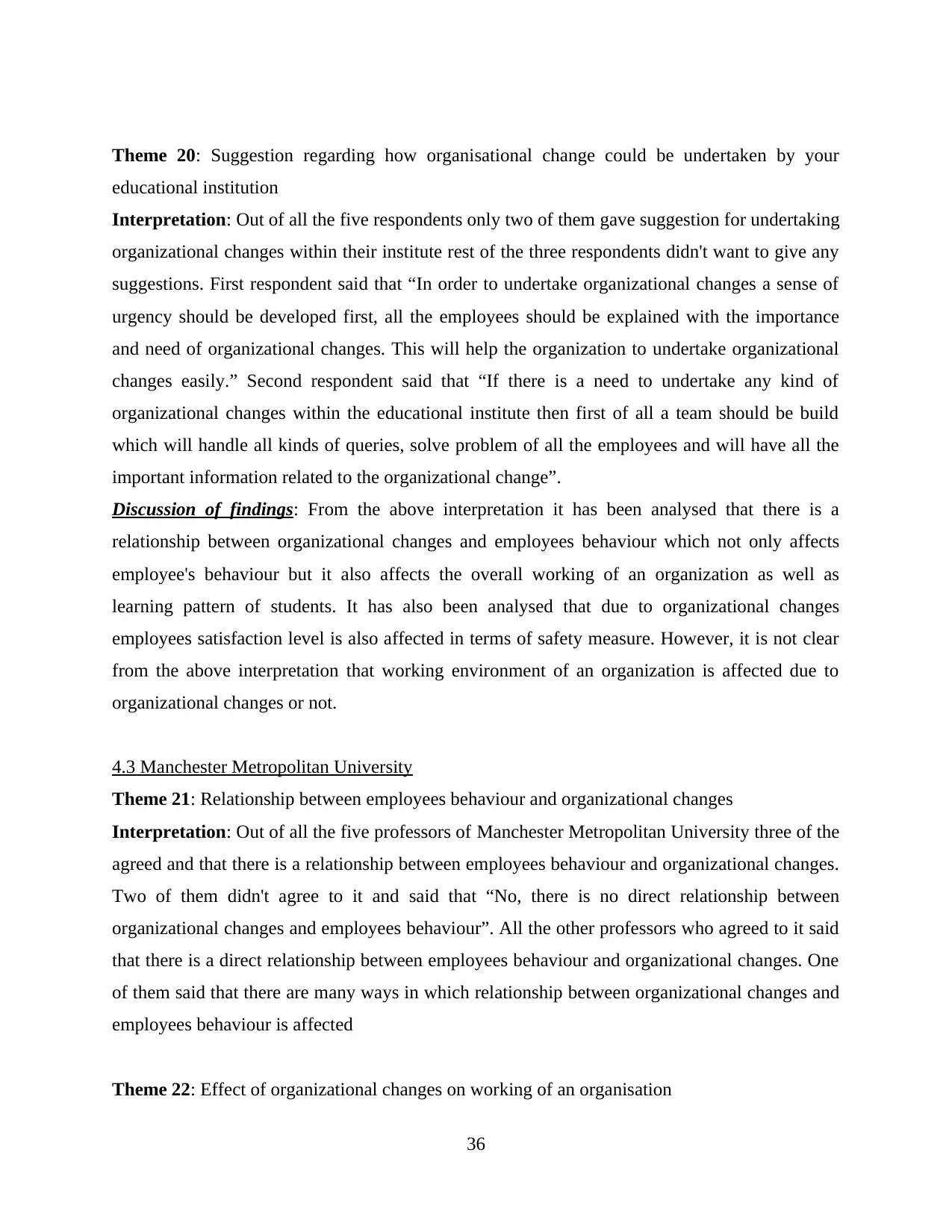
Theme 20: Suggestion regarding how organisational change could be undertaken by your
educational institution
Interpretation: Out of all the five respondents only two of them gave suggestion for undertaking
organizational changes within their institute rest of the three respondents didn't want to give any
suggestions. First respondent said that “In order to undertake organizational changes a sense of
urgency should be developed first, all the employees should be explained with the importance
and need of organizational changes. This will help the organization to undertake organizational
changes easily.” Second respondent said that “If there is a need to undertake any kind of
organizational changes within the educational institute then first of all a team should be build
which will handle all kinds of queries, solve problem of all the employees and will have all the
important information related to the organizational change”.
Discussion of findings: From the above interpretation it has been analysed that there is a
relationship between organizational changes and employees behaviour which not only affects
employee's behaviour but it also affects the overall working of an organization as well as
learning pattern of students. It has also been analysed that due to organizational changes
employees satisfaction level is also affected in terms of safety measure. However, it is not clear
from the above interpretation that working environment of an organization is affected due to
organizational changes or not.
4.3 Manchester Metropolitan University
Theme 21: Relationship between employees behaviour and organizational changes
Interpretation: Out of all the five professors of Manchester Metropolitan University three of the
agreed and that there is a relationship between employees behaviour and organizational changes.
Two of them didn't agree to it and said that “No, there is no direct relationship between
organizational changes and employees behaviour”. All the other professors who agreed to it said
that there is a direct relationship between employees behaviour and organizational changes. One
of them said that there are many ways in which relationship between organizational changes and
employees behaviour is affected
Theme 22: Effect of organizational changes on working of an organisation
36
educational institution
Interpretation: Out of all the five respondents only two of them gave suggestion for undertaking
organizational changes within their institute rest of the three respondents didn't want to give any
suggestions. First respondent said that “In order to undertake organizational changes a sense of
urgency should be developed first, all the employees should be explained with the importance
and need of organizational changes. This will help the organization to undertake organizational
changes easily.” Second respondent said that “If there is a need to undertake any kind of
organizational changes within the educational institute then first of all a team should be build
which will handle all kinds of queries, solve problem of all the employees and will have all the
important information related to the organizational change”.
Discussion of findings: From the above interpretation it has been analysed that there is a
relationship between organizational changes and employees behaviour which not only affects
employee's behaviour but it also affects the overall working of an organization as well as
learning pattern of students. It has also been analysed that due to organizational changes
employees satisfaction level is also affected in terms of safety measure. However, it is not clear
from the above interpretation that working environment of an organization is affected due to
organizational changes or not.
4.3 Manchester Metropolitan University
Theme 21: Relationship between employees behaviour and organizational changes
Interpretation: Out of all the five professors of Manchester Metropolitan University three of the
agreed and that there is a relationship between employees behaviour and organizational changes.
Two of them didn't agree to it and said that “No, there is no direct relationship between
organizational changes and employees behaviour”. All the other professors who agreed to it said
that there is a direct relationship between employees behaviour and organizational changes. One
of them said that there are many ways in which relationship between organizational changes and
employees behaviour is affected
Theme 22: Effect of organizational changes on working of an organisation
36
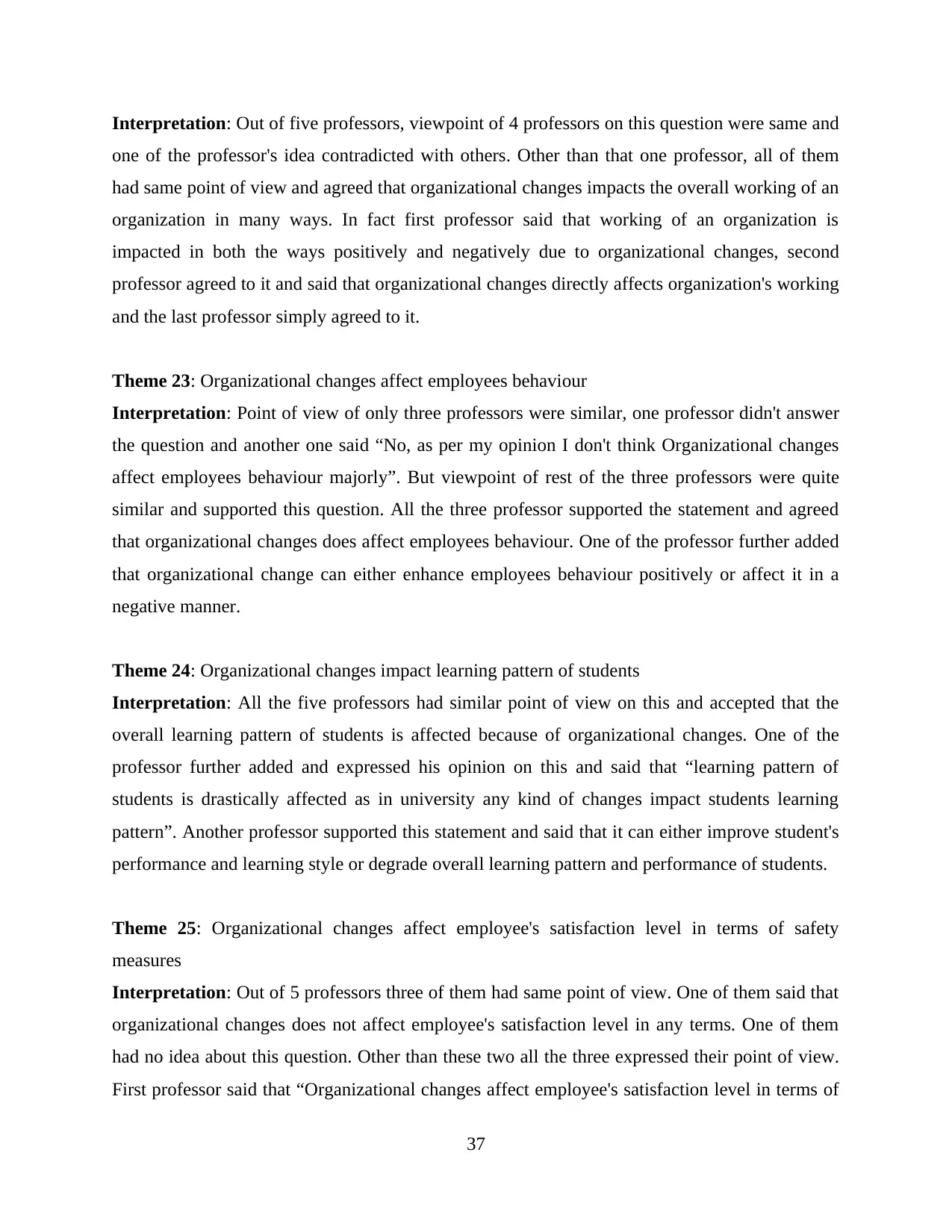
Interpretation: Out of five professors, viewpoint of 4 professors on this question were same and
one of the professor's idea contradicted with others. Other than that one professor, all of them
had same point of view and agreed that organizational changes impacts the overall working of an
organization in many ways. In fact first professor said that working of an organization is
impacted in both the ways positively and negatively due to organizational changes, second
professor agreed to it and said that organizational changes directly affects organization's working
and the last professor simply agreed to it.
Theme 23: Organizational changes affect employees behaviour
Interpretation: Point of view of only three professors were similar, one professor didn't answer
the question and another one said “No, as per my opinion I don't think Organizational changes
affect employees behaviour majorly”. But viewpoint of rest of the three professors were quite
similar and supported this question. All the three professor supported the statement and agreed
that organizational changes does affect employees behaviour. One of the professor further added
that organizational change can either enhance employees behaviour positively or affect it in a
negative manner.
Theme 24: Organizational changes impact learning pattern of students
Interpretation: All the five professors had similar point of view on this and accepted that the
overall learning pattern of students is affected because of organizational changes. One of the
professor further added and expressed his opinion on this and said that “learning pattern of
students is drastically affected as in university any kind of changes impact students learning
pattern”. Another professor supported this statement and said that it can either improve student's
performance and learning style or degrade overall learning pattern and performance of students.
Theme 25: Organizational changes affect employee's satisfaction level in terms of safety
measures
Interpretation: Out of 5 professors three of them had same point of view. One of them said that
organizational changes does not affect employee's satisfaction level in any terms. One of them
had no idea about this question. Other than these two all the three expressed their point of view.
First professor said that “Organizational changes affect employee's satisfaction level in terms of
37
one of the professor's idea contradicted with others. Other than that one professor, all of them
had same point of view and agreed that organizational changes impacts the overall working of an
organization in many ways. In fact first professor said that working of an organization is
impacted in both the ways positively and negatively due to organizational changes, second
professor agreed to it and said that organizational changes directly affects organization's working
and the last professor simply agreed to it.
Theme 23: Organizational changes affect employees behaviour
Interpretation: Point of view of only three professors were similar, one professor didn't answer
the question and another one said “No, as per my opinion I don't think Organizational changes
affect employees behaviour majorly”. But viewpoint of rest of the three professors were quite
similar and supported this question. All the three professor supported the statement and agreed
that organizational changes does affect employees behaviour. One of the professor further added
that organizational change can either enhance employees behaviour positively or affect it in a
negative manner.
Theme 24: Organizational changes impact learning pattern of students
Interpretation: All the five professors had similar point of view on this and accepted that the
overall learning pattern of students is affected because of organizational changes. One of the
professor further added and expressed his opinion on this and said that “learning pattern of
students is drastically affected as in university any kind of changes impact students learning
pattern”. Another professor supported this statement and said that it can either improve student's
performance and learning style or degrade overall learning pattern and performance of students.
Theme 25: Organizational changes affect employee's satisfaction level in terms of safety
measures
Interpretation: Out of 5 professors three of them had same point of view. One of them said that
organizational changes does not affect employee's satisfaction level in any terms. One of them
had no idea about this question. Other than these two all the three expressed their point of view.
First professor said that “Organizational changes affect employee's satisfaction level in terms of
37
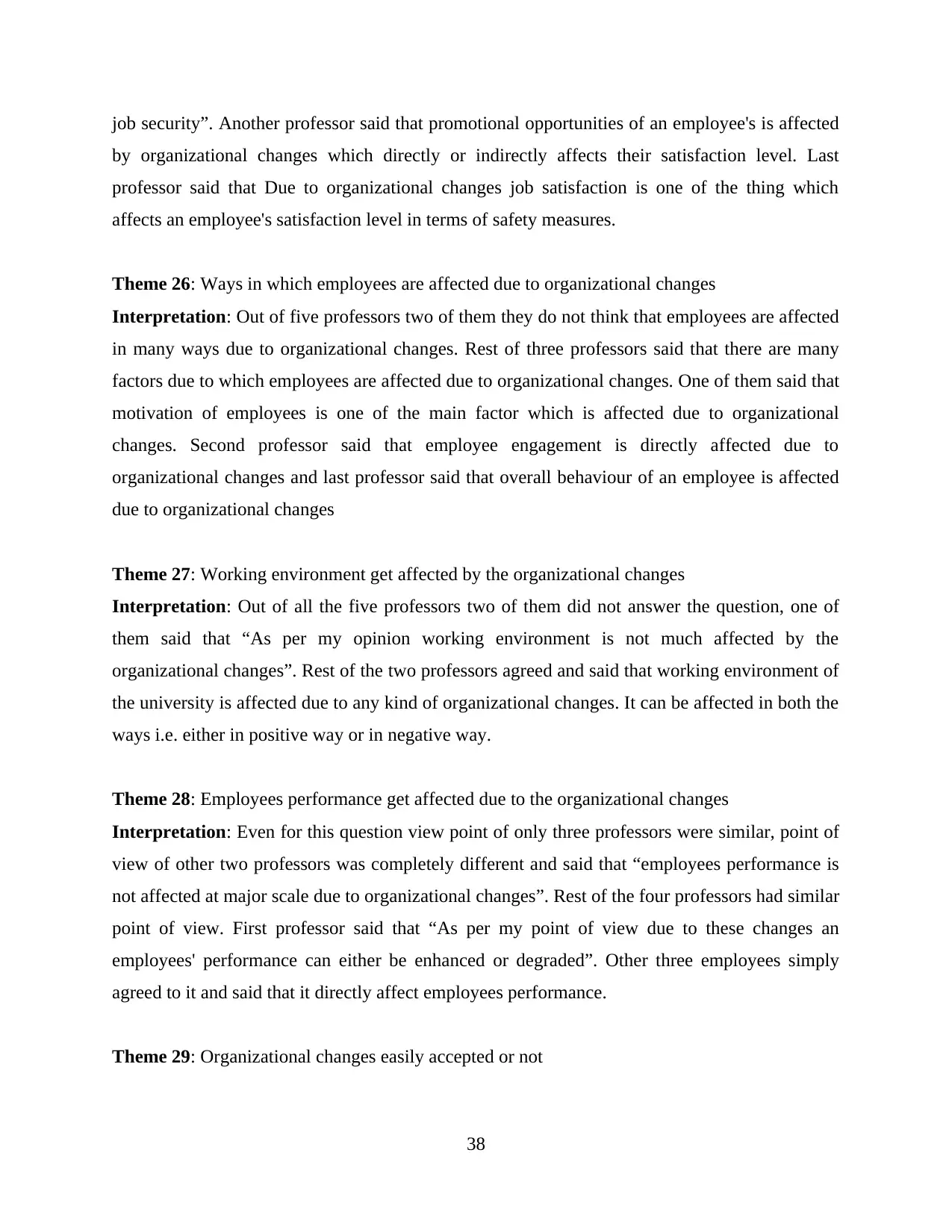
job security”. Another professor said that promotional opportunities of an employee's is affected
by organizational changes which directly or indirectly affects their satisfaction level. Last
professor said that Due to organizational changes job satisfaction is one of the thing which
affects an employee's satisfaction level in terms of safety measures.
Theme 26: Ways in which employees are affected due to organizational changes
Interpretation: Out of five professors two of them they do not think that employees are affected
in many ways due to organizational changes. Rest of three professors said that there are many
factors due to which employees are affected due to organizational changes. One of them said that
motivation of employees is one of the main factor which is affected due to organizational
changes. Second professor said that employee engagement is directly affected due to
organizational changes and last professor said that overall behaviour of an employee is affected
due to organizational changes
Theme 27: Working environment get affected by the organizational changes
Interpretation: Out of all the five professors two of them did not answer the question, one of
them said that “As per my opinion working environment is not much affected by the
organizational changes”. Rest of the two professors agreed and said that working environment of
the university is affected due to any kind of organizational changes. It can be affected in both the
ways i.e. either in positive way or in negative way.
Theme 28: Employees performance get affected due to the organizational changes
Interpretation: Even for this question view point of only three professors were similar, point of
view of other two professors was completely different and said that “employees performance is
not affected at major scale due to organizational changes”. Rest of the four professors had similar
point of view. First professor said that “As per my point of view due to these changes an
employees' performance can either be enhanced or degraded”. Other three employees simply
agreed to it and said that it directly affect employees performance.
Theme 29: Organizational changes easily accepted or not
38
by organizational changes which directly or indirectly affects their satisfaction level. Last
professor said that Due to organizational changes job satisfaction is one of the thing which
affects an employee's satisfaction level in terms of safety measures.
Theme 26: Ways in which employees are affected due to organizational changes
Interpretation: Out of five professors two of them they do not think that employees are affected
in many ways due to organizational changes. Rest of three professors said that there are many
factors due to which employees are affected due to organizational changes. One of them said that
motivation of employees is one of the main factor which is affected due to organizational
changes. Second professor said that employee engagement is directly affected due to
organizational changes and last professor said that overall behaviour of an employee is affected
due to organizational changes
Theme 27: Working environment get affected by the organizational changes
Interpretation: Out of all the five professors two of them did not answer the question, one of
them said that “As per my opinion working environment is not much affected by the
organizational changes”. Rest of the two professors agreed and said that working environment of
the university is affected due to any kind of organizational changes. It can be affected in both the
ways i.e. either in positive way or in negative way.
Theme 28: Employees performance get affected due to the organizational changes
Interpretation: Even for this question view point of only three professors were similar, point of
view of other two professors was completely different and said that “employees performance is
not affected at major scale due to organizational changes”. Rest of the four professors had similar
point of view. First professor said that “As per my point of view due to these changes an
employees' performance can either be enhanced or degraded”. Other three employees simply
agreed to it and said that it directly affect employees performance.
Theme 29: Organizational changes easily accepted or not
38
Paraphrase This Document
Need a fresh take? Get an instant paraphrase of this document with our AI Paraphraser
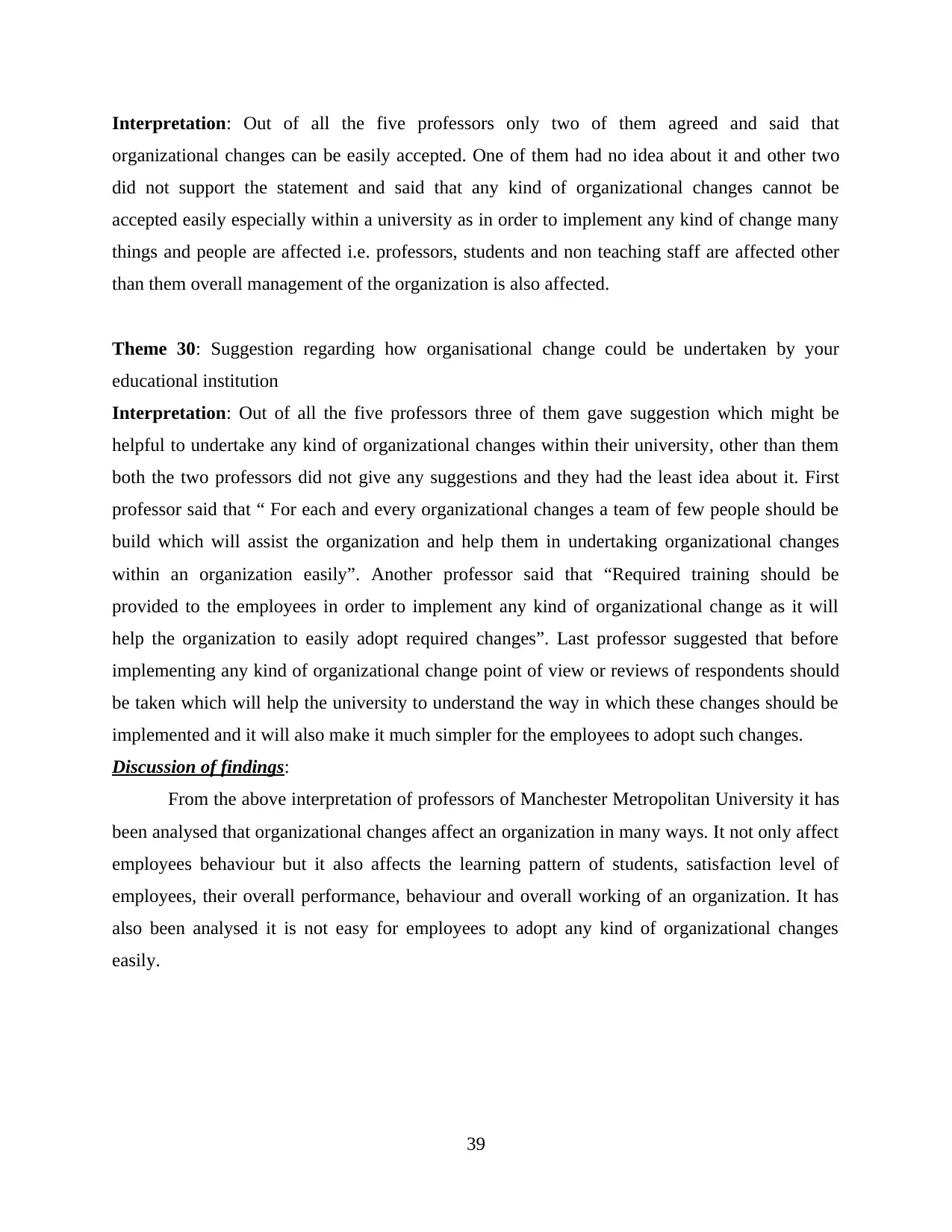
Interpretation: Out of all the five professors only two of them agreed and said that
organizational changes can be easily accepted. One of them had no idea about it and other two
did not support the statement and said that any kind of organizational changes cannot be
accepted easily especially within a university as in order to implement any kind of change many
things and people are affected i.e. professors, students and non teaching staff are affected other
than them overall management of the organization is also affected.
Theme 30: Suggestion regarding how organisational change could be undertaken by your
educational institution
Interpretation: Out of all the five professors three of them gave suggestion which might be
helpful to undertake any kind of organizational changes within their university, other than them
both the two professors did not give any suggestions and they had the least idea about it. First
professor said that “ For each and every organizational changes a team of few people should be
build which will assist the organization and help them in undertaking organizational changes
within an organization easily”. Another professor said that “Required training should be
provided to the employees in order to implement any kind of organizational change as it will
help the organization to easily adopt required changes”. Last professor suggested that before
implementing any kind of organizational change point of view or reviews of respondents should
be taken which will help the university to understand the way in which these changes should be
implemented and it will also make it much simpler for the employees to adopt such changes.
Discussion of findings:
From the above interpretation of professors of Manchester Metropolitan University it has
been analysed that organizational changes affect an organization in many ways. It not only affect
employees behaviour but it also affects the learning pattern of students, satisfaction level of
employees, their overall performance, behaviour and overall working of an organization. It has
also been analysed it is not easy for employees to adopt any kind of organizational changes
easily.
39
organizational changes can be easily accepted. One of them had no idea about it and other two
did not support the statement and said that any kind of organizational changes cannot be
accepted easily especially within a university as in order to implement any kind of change many
things and people are affected i.e. professors, students and non teaching staff are affected other
than them overall management of the organization is also affected.
Theme 30: Suggestion regarding how organisational change could be undertaken by your
educational institution
Interpretation: Out of all the five professors three of them gave suggestion which might be
helpful to undertake any kind of organizational changes within their university, other than them
both the two professors did not give any suggestions and they had the least idea about it. First
professor said that “ For each and every organizational changes a team of few people should be
build which will assist the organization and help them in undertaking organizational changes
within an organization easily”. Another professor said that “Required training should be
provided to the employees in order to implement any kind of organizational change as it will
help the organization to easily adopt required changes”. Last professor suggested that before
implementing any kind of organizational change point of view or reviews of respondents should
be taken which will help the university to understand the way in which these changes should be
implemented and it will also make it much simpler for the employees to adopt such changes.
Discussion of findings:
From the above interpretation of professors of Manchester Metropolitan University it has
been analysed that organizational changes affect an organization in many ways. It not only affect
employees behaviour but it also affects the learning pattern of students, satisfaction level of
employees, their overall performance, behaviour and overall working of an organization. It has
also been analysed it is not easy for employees to adopt any kind of organizational changes
easily.
39
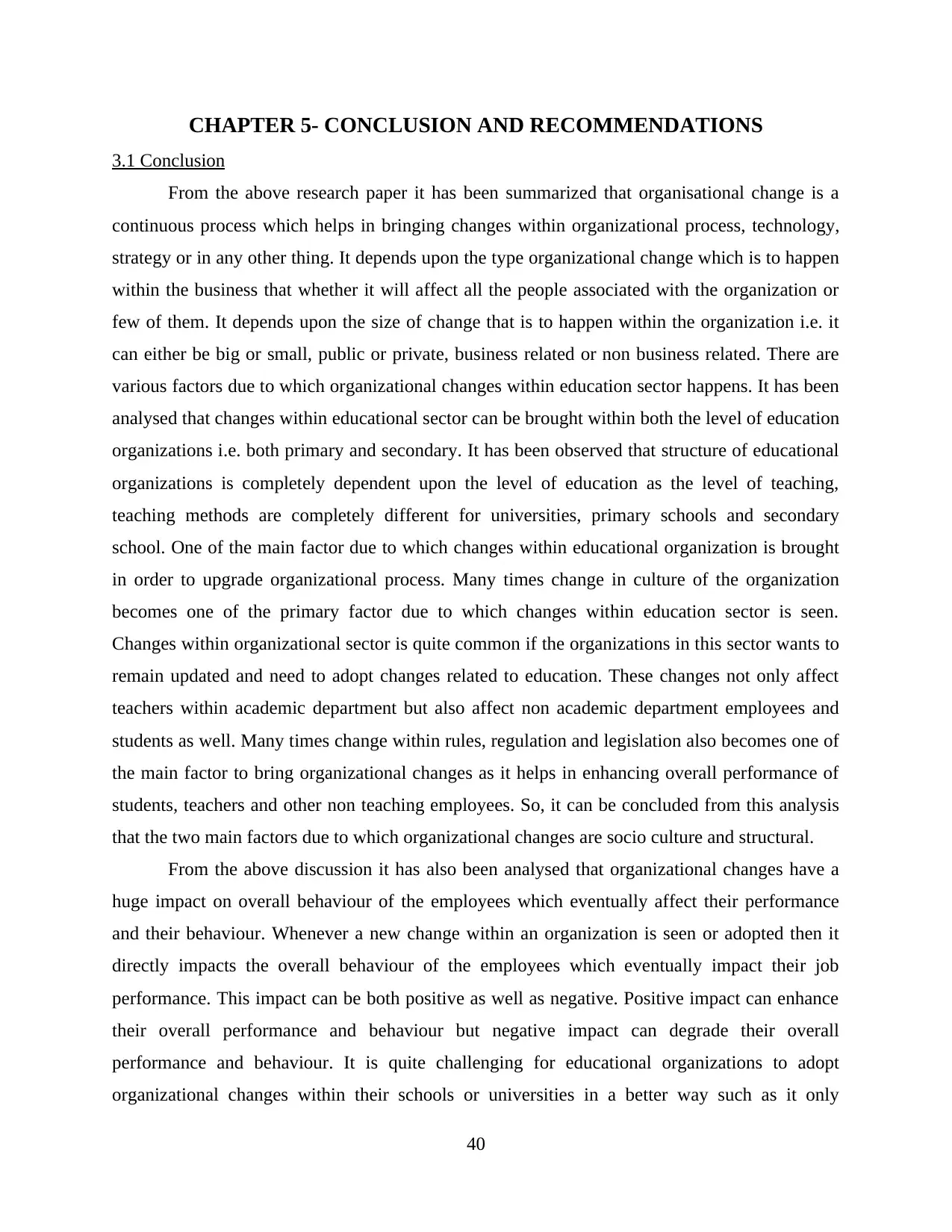
CHAPTER 5- CONCLUSION AND RECOMMENDATIONS
3.1 Conclusion
From the above research paper it has been summarized that organisational change is a
continuous process which helps in bringing changes within organizational process, technology,
strategy or in any other thing. It depends upon the type organizational change which is to happen
within the business that whether it will affect all the people associated with the organization or
few of them. It depends upon the size of change that is to happen within the organization i.e. it
can either be big or small, public or private, business related or non business related. There are
various factors due to which organizational changes within education sector happens. It has been
analysed that changes within educational sector can be brought within both the level of education
organizations i.e. both primary and secondary. It has been observed that structure of educational
organizations is completely dependent upon the level of education as the level of teaching,
teaching methods are completely different for universities, primary schools and secondary
school. One of the main factor due to which changes within educational organization is brought
in order to upgrade organizational process. Many times change in culture of the organization
becomes one of the primary factor due to which changes within education sector is seen.
Changes within organizational sector is quite common if the organizations in this sector wants to
remain updated and need to adopt changes related to education. These changes not only affect
teachers within academic department but also affect non academic department employees and
students as well. Many times change within rules, regulation and legislation also becomes one of
the main factor to bring organizational changes as it helps in enhancing overall performance of
students, teachers and other non teaching employees. So, it can be concluded from this analysis
that the two main factors due to which organizational changes are socio culture and structural.
From the above discussion it has also been analysed that organizational changes have a
huge impact on overall behaviour of the employees which eventually affect their performance
and their behaviour. Whenever a new change within an organization is seen or adopted then it
directly impacts the overall behaviour of the employees which eventually impact their job
performance. This impact can be both positive as well as negative. Positive impact can enhance
their overall performance and behaviour but negative impact can degrade their overall
performance and behaviour. It is quite challenging for educational organizations to adopt
organizational changes within their schools or universities in a better way such as it only
40
3.1 Conclusion
From the above research paper it has been summarized that organisational change is a
continuous process which helps in bringing changes within organizational process, technology,
strategy or in any other thing. It depends upon the type organizational change which is to happen
within the business that whether it will affect all the people associated with the organization or
few of them. It depends upon the size of change that is to happen within the organization i.e. it
can either be big or small, public or private, business related or non business related. There are
various factors due to which organizational changes within education sector happens. It has been
analysed that changes within educational sector can be brought within both the level of education
organizations i.e. both primary and secondary. It has been observed that structure of educational
organizations is completely dependent upon the level of education as the level of teaching,
teaching methods are completely different for universities, primary schools and secondary
school. One of the main factor due to which changes within educational organization is brought
in order to upgrade organizational process. Many times change in culture of the organization
becomes one of the primary factor due to which changes within education sector is seen.
Changes within organizational sector is quite common if the organizations in this sector wants to
remain updated and need to adopt changes related to education. These changes not only affect
teachers within academic department but also affect non academic department employees and
students as well. Many times change within rules, regulation and legislation also becomes one of
the main factor to bring organizational changes as it helps in enhancing overall performance of
students, teachers and other non teaching employees. So, it can be concluded from this analysis
that the two main factors due to which organizational changes are socio culture and structural.
From the above discussion it has also been analysed that organizational changes have a
huge impact on overall behaviour of the employees which eventually affect their performance
and their behaviour. Whenever a new change within an organization is seen or adopted then it
directly impacts the overall behaviour of the employees which eventually impact their job
performance. This impact can be both positive as well as negative. Positive impact can enhance
their overall performance and behaviour but negative impact can degrade their overall
performance and behaviour. It is quite challenging for educational organizations to adopt
organizational changes within their schools or universities in a better way such as it only
40
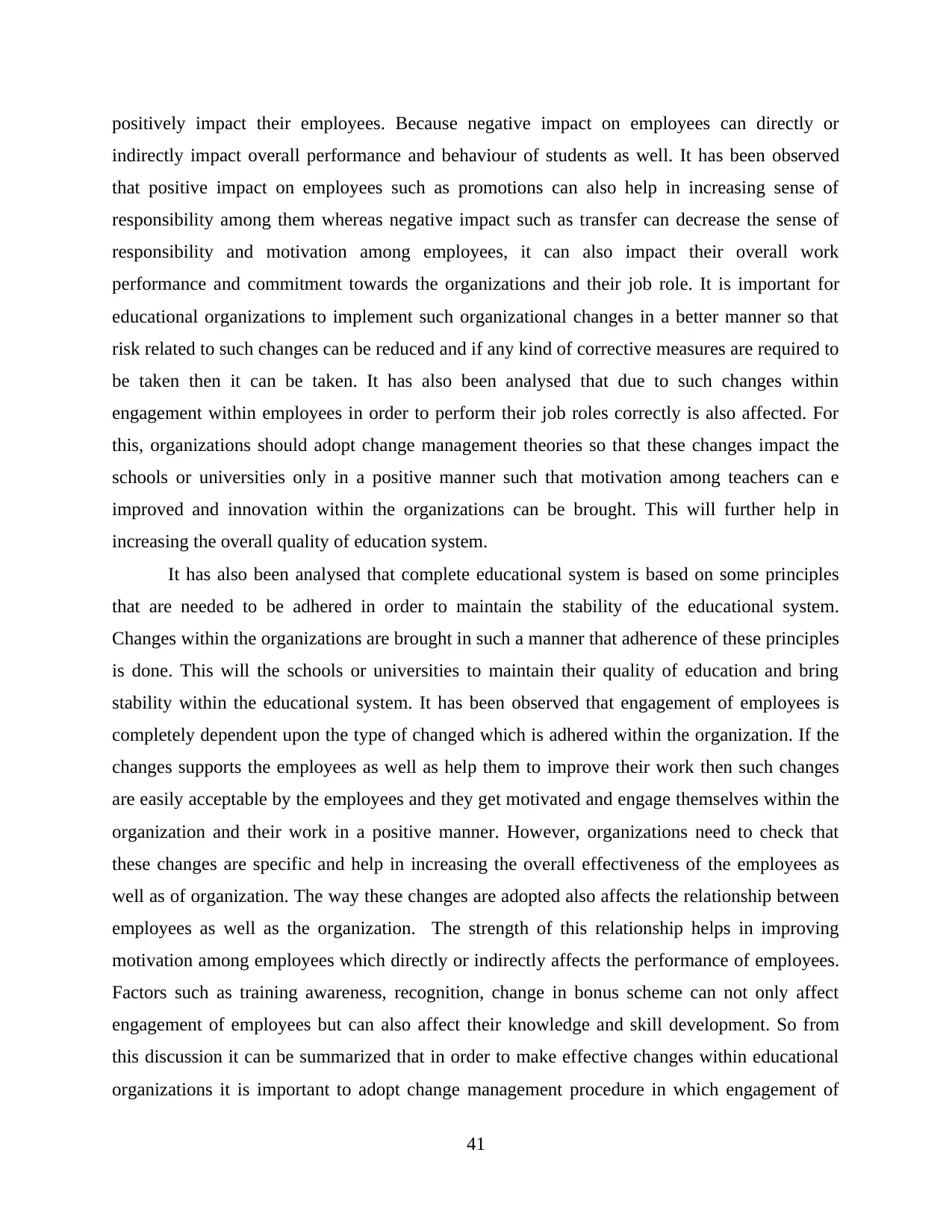
positively impact their employees. Because negative impact on employees can directly or
indirectly impact overall performance and behaviour of students as well. It has been observed
that positive impact on employees such as promotions can also help in increasing sense of
responsibility among them whereas negative impact such as transfer can decrease the sense of
responsibility and motivation among employees, it can also impact their overall work
performance and commitment towards the organizations and their job role. It is important for
educational organizations to implement such organizational changes in a better manner so that
risk related to such changes can be reduced and if any kind of corrective measures are required to
be taken then it can be taken. It has also been analysed that due to such changes within
engagement within employees in order to perform their job roles correctly is also affected. For
this, organizations should adopt change management theories so that these changes impact the
schools or universities only in a positive manner such that motivation among teachers can e
improved and innovation within the organizations can be brought. This will further help in
increasing the overall quality of education system.
It has also been analysed that complete educational system is based on some principles
that are needed to be adhered in order to maintain the stability of the educational system.
Changes within the organizations are brought in such a manner that adherence of these principles
is done. This will the schools or universities to maintain their quality of education and bring
stability within the educational system. It has been observed that engagement of employees is
completely dependent upon the type of changed which is adhered within the organization. If the
changes supports the employees as well as help them to improve their work then such changes
are easily acceptable by the employees and they get motivated and engage themselves within the
organization and their work in a positive manner. However, organizations need to check that
these changes are specific and help in increasing the overall effectiveness of the employees as
well as of organization. The way these changes are adopted also affects the relationship between
employees as well as the organization. The strength of this relationship helps in improving
motivation among employees which directly or indirectly affects the performance of employees.
Factors such as training awareness, recognition, change in bonus scheme can not only affect
engagement of employees but can also affect their knowledge and skill development. So from
this discussion it can be summarized that in order to make effective changes within educational
organizations it is important to adopt change management procedure in which engagement of
41
indirectly impact overall performance and behaviour of students as well. It has been observed
that positive impact on employees such as promotions can also help in increasing sense of
responsibility among them whereas negative impact such as transfer can decrease the sense of
responsibility and motivation among employees, it can also impact their overall work
performance and commitment towards the organizations and their job role. It is important for
educational organizations to implement such organizational changes in a better manner so that
risk related to such changes can be reduced and if any kind of corrective measures are required to
be taken then it can be taken. It has also been analysed that due to such changes within
engagement within employees in order to perform their job roles correctly is also affected. For
this, organizations should adopt change management theories so that these changes impact the
schools or universities only in a positive manner such that motivation among teachers can e
improved and innovation within the organizations can be brought. This will further help in
increasing the overall quality of education system.
It has also been analysed that complete educational system is based on some principles
that are needed to be adhered in order to maintain the stability of the educational system.
Changes within the organizations are brought in such a manner that adherence of these principles
is done. This will the schools or universities to maintain their quality of education and bring
stability within the educational system. It has been observed that engagement of employees is
completely dependent upon the type of changed which is adhered within the organization. If the
changes supports the employees as well as help them to improve their work then such changes
are easily acceptable by the employees and they get motivated and engage themselves within the
organization and their work in a positive manner. However, organizations need to check that
these changes are specific and help in increasing the overall effectiveness of the employees as
well as of organization. The way these changes are adopted also affects the relationship between
employees as well as the organization. The strength of this relationship helps in improving
motivation among employees which directly or indirectly affects the performance of employees.
Factors such as training awareness, recognition, change in bonus scheme can not only affect
engagement of employees but can also affect their knowledge and skill development. So from
this discussion it can be summarized that in order to make effective changes within educational
organizations it is important to adopt change management procedure in which engagement of
41
Secure Best Marks with AI Grader
Need help grading? Try our AI Grader for instant feedback on your assignments.
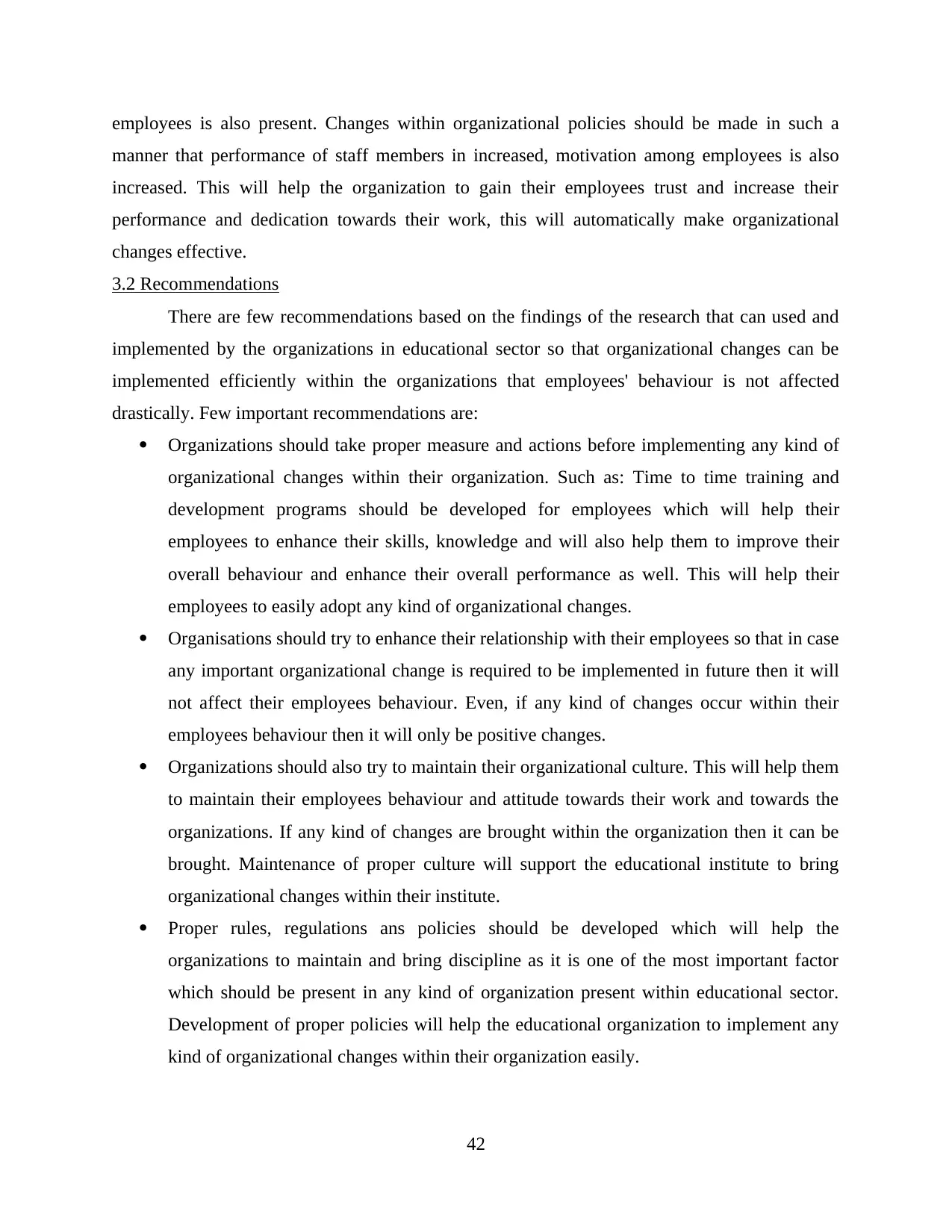
employees is also present. Changes within organizational policies should be made in such a
manner that performance of staff members in increased, motivation among employees is also
increased. This will help the organization to gain their employees trust and increase their
performance and dedication towards their work, this will automatically make organizational
changes effective.
3.2 Recommendations
There are few recommendations based on the findings of the research that can used and
implemented by the organizations in educational sector so that organizational changes can be
implemented efficiently within the organizations that employees' behaviour is not affected
drastically. Few important recommendations are:
Organizations should take proper measure and actions before implementing any kind of
organizational changes within their organization. Such as: Time to time training and
development programs should be developed for employees which will help their
employees to enhance their skills, knowledge and will also help them to improve their
overall behaviour and enhance their overall performance as well. This will help their
employees to easily adopt any kind of organizational changes.
Organisations should try to enhance their relationship with their employees so that in case
any important organizational change is required to be implemented in future then it will
not affect their employees behaviour. Even, if any kind of changes occur within their
employees behaviour then it will only be positive changes.
Organizations should also try to maintain their organizational culture. This will help them
to maintain their employees behaviour and attitude towards their work and towards the
organizations. If any kind of changes are brought within the organization then it can be
brought. Maintenance of proper culture will support the educational institute to bring
organizational changes within their institute.
Proper rules, regulations ans policies should be developed which will help the
organizations to maintain and bring discipline as it is one of the most important factor
which should be present in any kind of organization present within educational sector.
Development of proper policies will help the educational organization to implement any
kind of organizational changes within their organization easily.
42
manner that performance of staff members in increased, motivation among employees is also
increased. This will help the organization to gain their employees trust and increase their
performance and dedication towards their work, this will automatically make organizational
changes effective.
3.2 Recommendations
There are few recommendations based on the findings of the research that can used and
implemented by the organizations in educational sector so that organizational changes can be
implemented efficiently within the organizations that employees' behaviour is not affected
drastically. Few important recommendations are:
Organizations should take proper measure and actions before implementing any kind of
organizational changes within their organization. Such as: Time to time training and
development programs should be developed for employees which will help their
employees to enhance their skills, knowledge and will also help them to improve their
overall behaviour and enhance their overall performance as well. This will help their
employees to easily adopt any kind of organizational changes.
Organisations should try to enhance their relationship with their employees so that in case
any important organizational change is required to be implemented in future then it will
not affect their employees behaviour. Even, if any kind of changes occur within their
employees behaviour then it will only be positive changes.
Organizations should also try to maintain their organizational culture. This will help them
to maintain their employees behaviour and attitude towards their work and towards the
organizations. If any kind of changes are brought within the organization then it can be
brought. Maintenance of proper culture will support the educational institute to bring
organizational changes within their institute.
Proper rules, regulations ans policies should be developed which will help the
organizations to maintain and bring discipline as it is one of the most important factor
which should be present in any kind of organization present within educational sector.
Development of proper policies will help the educational organization to implement any
kind of organizational changes within their organization easily.
42
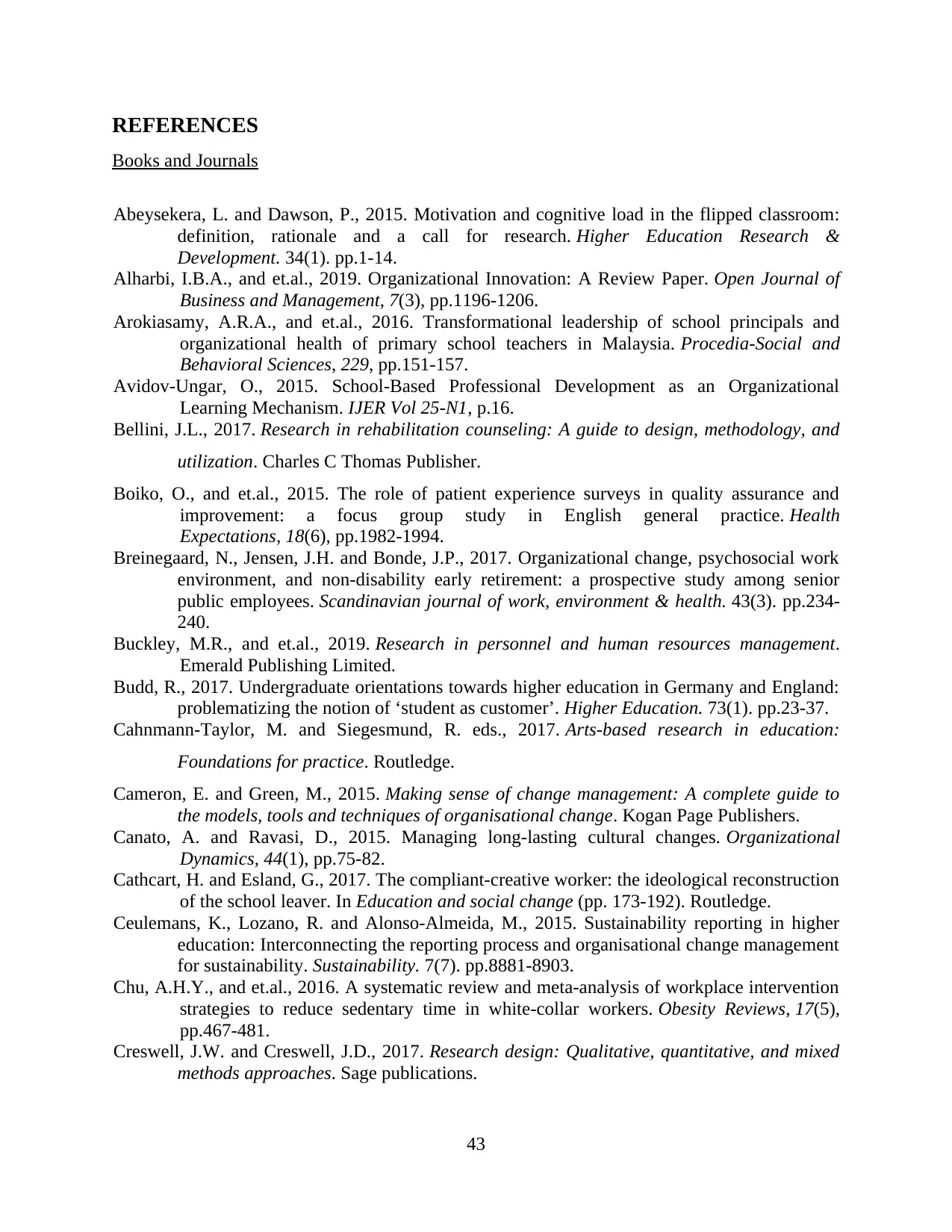
REFERENCES
Books and Journals
Abeysekera, L. and Dawson, P., 2015. Motivation and cognitive load in the flipped classroom:
definition, rationale and a call for research. Higher Education Research &
Development. 34(1). pp.1-14.
Alharbi, I.B.A., and et.al., 2019. Organizational Innovation: A Review Paper. Open Journal of
Business and Management, 7(3), pp.1196-1206.
Arokiasamy, A.R.A., and et.al., 2016. Transformational leadership of school principals and
organizational health of primary school teachers in Malaysia. Procedia-Social and
Behavioral Sciences, 229, pp.151-157.
Avidov-Ungar, O., 2015. School-Based Professional Development as an Organizational
Learning Mechanism. IJER Vol 25-N1, p.16.
Bellini, J.L., 2017. Research in rehabilitation counseling: A guide to design, methodology, and
utilization. Charles C Thomas Publisher.
Boiko, O., and et.al., 2015. The role of patient experience surveys in quality assurance and
improvement: a focus group study in English general practice. Health
Expectations, 18(6), pp.1982-1994.
Breinegaard, N., Jensen, J.H. and Bonde, J.P., 2017. Organizational change, psychosocial work
environment, and non-disability early retirement: a prospective study among senior
public employees. Scandinavian journal of work, environment & health. 43(3). pp.234-
240.
Buckley, M.R., and et.al., 2019. Research in personnel and human resources management.
Emerald Publishing Limited.
Budd, R., 2017. Undergraduate orientations towards higher education in Germany and England:
problematizing the notion of ‘student as customer’. Higher Education. 73(1). pp.23-37.
Cahnmann-Taylor, M. and Siegesmund, R. eds., 2017. Arts-based research in education:
Foundations for practice. Routledge.
Cameron, E. and Green, M., 2015. Making sense of change management: A complete guide to
the models, tools and techniques of organisational change. Kogan Page Publishers.
Canato, A. and Ravasi, D., 2015. Managing long-lasting cultural changes. Organizational
Dynamics, 44(1), pp.75-82.
Cathcart, H. and Esland, G., 2017. The compliant-creative worker: the ideological reconstruction
of the school leaver. In Education and social change (pp. 173-192). Routledge.
Ceulemans, K., Lozano, R. and Alonso-Almeida, M., 2015. Sustainability reporting in higher
education: Interconnecting the reporting process and organisational change management
for sustainability. Sustainability. 7(7). pp.8881-8903.
Chu, A.H.Y., and et.al., 2016. A systematic review and meta‐analysis of workplace intervention
strategies to reduce sedentary time in white‐collar workers. Obesity Reviews, 17(5),
pp.467-481.
Creswell, J.W. and Creswell, J.D., 2017. Research design: Qualitative, quantitative, and mixed
methods approaches. Sage publications.
43
Books and Journals
Abeysekera, L. and Dawson, P., 2015. Motivation and cognitive load in the flipped classroom:
definition, rationale and a call for research. Higher Education Research &
Development. 34(1). pp.1-14.
Alharbi, I.B.A., and et.al., 2019. Organizational Innovation: A Review Paper. Open Journal of
Business and Management, 7(3), pp.1196-1206.
Arokiasamy, A.R.A., and et.al., 2016. Transformational leadership of school principals and
organizational health of primary school teachers in Malaysia. Procedia-Social and
Behavioral Sciences, 229, pp.151-157.
Avidov-Ungar, O., 2015. School-Based Professional Development as an Organizational
Learning Mechanism. IJER Vol 25-N1, p.16.
Bellini, J.L., 2017. Research in rehabilitation counseling: A guide to design, methodology, and
utilization. Charles C Thomas Publisher.
Boiko, O., and et.al., 2015. The role of patient experience surveys in quality assurance and
improvement: a focus group study in English general practice. Health
Expectations, 18(6), pp.1982-1994.
Breinegaard, N., Jensen, J.H. and Bonde, J.P., 2017. Organizational change, psychosocial work
environment, and non-disability early retirement: a prospective study among senior
public employees. Scandinavian journal of work, environment & health. 43(3). pp.234-
240.
Buckley, M.R., and et.al., 2019. Research in personnel and human resources management.
Emerald Publishing Limited.
Budd, R., 2017. Undergraduate orientations towards higher education in Germany and England:
problematizing the notion of ‘student as customer’. Higher Education. 73(1). pp.23-37.
Cahnmann-Taylor, M. and Siegesmund, R. eds., 2017. Arts-based research in education:
Foundations for practice. Routledge.
Cameron, E. and Green, M., 2015. Making sense of change management: A complete guide to
the models, tools and techniques of organisational change. Kogan Page Publishers.
Canato, A. and Ravasi, D., 2015. Managing long-lasting cultural changes. Organizational
Dynamics, 44(1), pp.75-82.
Cathcart, H. and Esland, G., 2017. The compliant-creative worker: the ideological reconstruction
of the school leaver. In Education and social change (pp. 173-192). Routledge.
Ceulemans, K., Lozano, R. and Alonso-Almeida, M., 2015. Sustainability reporting in higher
education: Interconnecting the reporting process and organisational change management
for sustainability. Sustainability. 7(7). pp.8881-8903.
Chu, A.H.Y., and et.al., 2016. A systematic review and meta‐analysis of workplace intervention
strategies to reduce sedentary time in white‐collar workers. Obesity Reviews, 17(5),
pp.467-481.
Creswell, J.W. and Creswell, J.D., 2017. Research design: Qualitative, quantitative, and mixed
methods approaches. Sage publications.
43

Day, C., Gu, Q. and Sammons, P., 2016. The impact of leadership on student outcomes: How
successful school leaders use transformational and instructional strategies to make a
difference. Educational Administration Quarterly, 52(2), pp.221-258.
Deeds, V. and Pattillo, M., 2015. Organizational “failure” and institutional pluralism: A case
study of an urban school closure. Urban Education, 50(4), pp.474-504.
DENIS, J.L., Ferlie, E. and Van Gestel, N., 2015. Understanding hybridity in public
organisations. Public Administration. 93(2). pp.273-289.
Domina, T., and et.al., 2016. Beyond tracking and detracking: The dimensions of organizational
differentiation in schools. Sociology of Education, p.0038040719851879.
Ekstrand, B., 2015. What it takes to keep children in school: a research review. Educational
Review, 67(4), pp.459-482.
Elgort, I., 2018. Technology-Mediated Second Language Vocabulary Development: A Review
of Trends in Research Methodology. calico journal. 35(1).
Fernandes, V., 2019. Investigating the Role of Data-Driven Decision-Making Within School
Improvement Processes. In Evidence-Based Initiatives for Organizational Change and
Development (pp. 201-219). IGI Global.
Fernandez, S. and Rainey, H.G., 2017. Managing successful organisational change in the public
sector. In Debating Public Administration (pp. 7-26). Routledge.
Figueiró, P.S. and Raufflet, E., 2015. Sustainability in higher education: a systematic review
with focus on management education. Journal of cleaner production. 106. pp.22-33.
Fläckman, B., and et.al., 2015. Consequences of working in eldercare during organizational
changes and cut backs while education and clinical supervision was provided: a mixed
methods study. Open Journal of Nursing. 5(09). p.813.
Garcia, A.J.G.J.L. and Mataveli, A.M., 2015. The training demand in organizational changes
processes in the Spanish wine sector. Journal of Managerial Psychology, 30, pp.645-
658.
Georgalis, J and et.al., 2015. Change process characteristics and resistance to organisational
change: The role of employee perceptions of justice. Australian Journal of
Management. 40(1). pp.89-113.
Giessner, S.R., Horton, K.E. and Humborstad, S.I.W., 2016. Identity management during
organizational mergers: Empirical insights and practical advice. Social Issues and
Policy Review, 10(1), pp.47-81.
Griebler, U., and et.al., 2017. Effects of student participation in school health promotion: a
systematic review. Health promotion international, 32(2), pp.195-206.
Guest, D.E., 2017. Human resource management and employee well‐being: Towards a new
analytic framework. Human Resource Management Journal, 27(1), pp.22-38.
Hersted, L. and Frimann, S., 2019. Leadership development and organizational learning through
dialogical process. Action Research in a Relational Perspective: Dialogue, Reflexivity,
Power and Ethics.
Hussain, S.T., and et.al., 2018. Kurt Lewin's change model: A critical review of the role of
leadership and employee involvement in organisational change. Journal of Innovation &
Knowledge. 3(3). pp.123-127.
Hüther, O. and Krücken, G., 2016. Nested organizational fields: Isomorphism and differentiation
among European universities. In The university under pressure (pp. 53-83). Emerald
Group Publishing Limited.
44
successful school leaders use transformational and instructional strategies to make a
difference. Educational Administration Quarterly, 52(2), pp.221-258.
Deeds, V. and Pattillo, M., 2015. Organizational “failure” and institutional pluralism: A case
study of an urban school closure. Urban Education, 50(4), pp.474-504.
DENIS, J.L., Ferlie, E. and Van Gestel, N., 2015. Understanding hybridity in public
organisations. Public Administration. 93(2). pp.273-289.
Domina, T., and et.al., 2016. Beyond tracking and detracking: The dimensions of organizational
differentiation in schools. Sociology of Education, p.0038040719851879.
Ekstrand, B., 2015. What it takes to keep children in school: a research review. Educational
Review, 67(4), pp.459-482.
Elgort, I., 2018. Technology-Mediated Second Language Vocabulary Development: A Review
of Trends in Research Methodology. calico journal. 35(1).
Fernandes, V., 2019. Investigating the Role of Data-Driven Decision-Making Within School
Improvement Processes. In Evidence-Based Initiatives for Organizational Change and
Development (pp. 201-219). IGI Global.
Fernandez, S. and Rainey, H.G., 2017. Managing successful organisational change in the public
sector. In Debating Public Administration (pp. 7-26). Routledge.
Figueiró, P.S. and Raufflet, E., 2015. Sustainability in higher education: a systematic review
with focus on management education. Journal of cleaner production. 106. pp.22-33.
Fläckman, B., and et.al., 2015. Consequences of working in eldercare during organizational
changes and cut backs while education and clinical supervision was provided: a mixed
methods study. Open Journal of Nursing. 5(09). p.813.
Garcia, A.J.G.J.L. and Mataveli, A.M., 2015. The training demand in organizational changes
processes in the Spanish wine sector. Journal of Managerial Psychology, 30, pp.645-
658.
Georgalis, J and et.al., 2015. Change process characteristics and resistance to organisational
change: The role of employee perceptions of justice. Australian Journal of
Management. 40(1). pp.89-113.
Giessner, S.R., Horton, K.E. and Humborstad, S.I.W., 2016. Identity management during
organizational mergers: Empirical insights and practical advice. Social Issues and
Policy Review, 10(1), pp.47-81.
Griebler, U., and et.al., 2017. Effects of student participation in school health promotion: a
systematic review. Health promotion international, 32(2), pp.195-206.
Guest, D.E., 2017. Human resource management and employee well‐being: Towards a new
analytic framework. Human Resource Management Journal, 27(1), pp.22-38.
Hersted, L. and Frimann, S., 2019. Leadership development and organizational learning through
dialogical process. Action Research in a Relational Perspective: Dialogue, Reflexivity,
Power and Ethics.
Hussain, S.T., and et.al., 2018. Kurt Lewin's change model: A critical review of the role of
leadership and employee involvement in organisational change. Journal of Innovation &
Knowledge. 3(3). pp.123-127.
Hüther, O. and Krücken, G., 2016. Nested organizational fields: Isomorphism and differentiation
among European universities. In The university under pressure (pp. 53-83). Emerald
Group Publishing Limited.
44
Paraphrase This Document
Need a fresh take? Get an instant paraphrase of this document with our AI Paraphraser
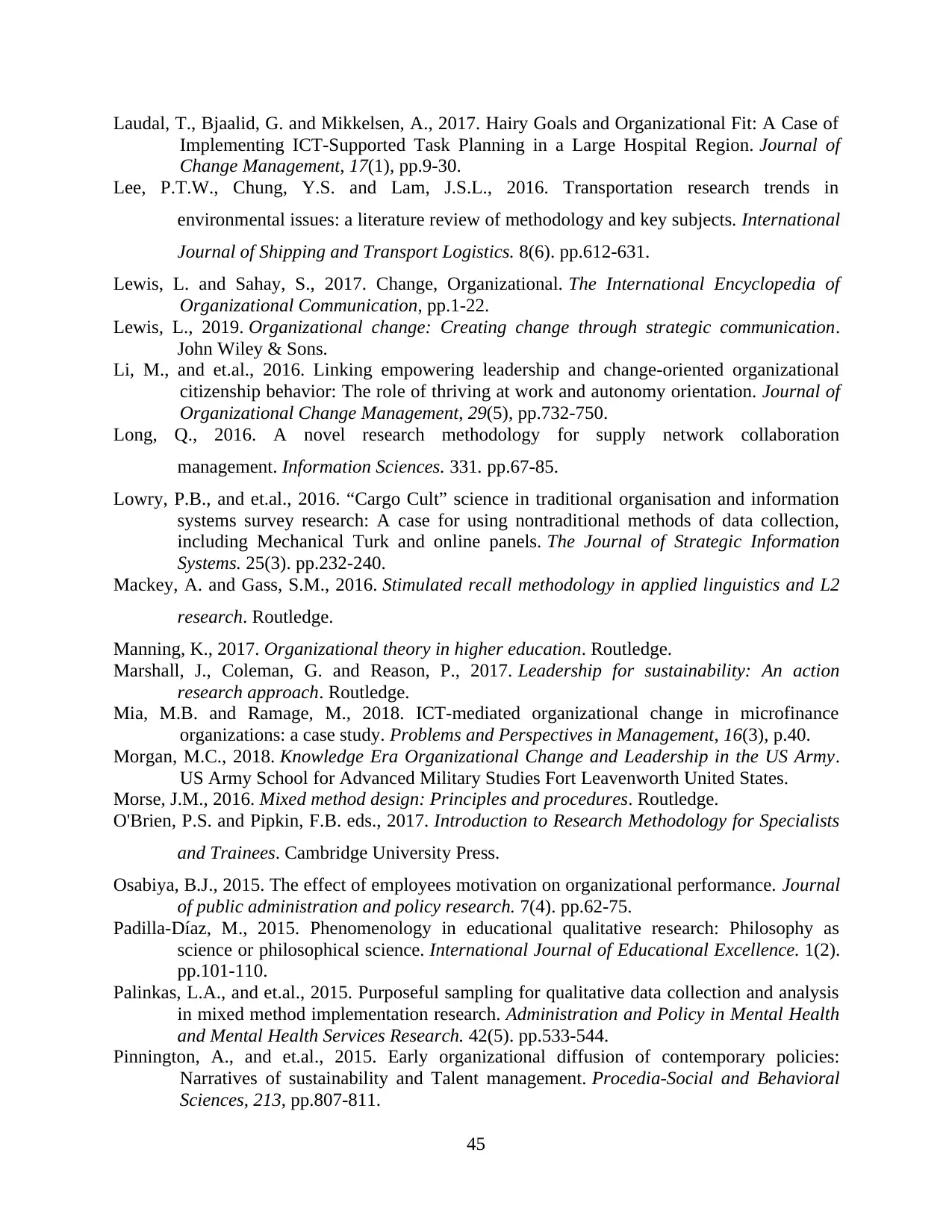
Laudal, T., Bjaalid, G. and Mikkelsen, A., 2017. Hairy Goals and Organizational Fit: A Case of
Implementing ICT-Supported Task Planning in a Large Hospital Region. Journal of
Change Management, 17(1), pp.9-30.
Lee, P.T.W., Chung, Y.S. and Lam, J.S.L., 2016. Transportation research trends in
environmental issues: a literature review of methodology and key subjects. International
Journal of Shipping and Transport Logistics. 8(6). pp.612-631.
Lewis, L. and Sahay, S., 2017. Change, Organizational. The International Encyclopedia of
Organizational Communication, pp.1-22.
Lewis, L., 2019. Organizational change: Creating change through strategic communication.
John Wiley & Sons.
Li, M., and et.al., 2016. Linking empowering leadership and change-oriented organizational
citizenship behavior: The role of thriving at work and autonomy orientation. Journal of
Organizational Change Management, 29(5), pp.732-750.
Long, Q., 2016. A novel research methodology for supply network collaboration
management. Information Sciences. 331. pp.67-85.
Lowry, P.B., and et.al., 2016. “Cargo Cult” science in traditional organisation and information
systems survey research: A case for using nontraditional methods of data collection,
including Mechanical Turk and online panels. The Journal of Strategic Information
Systems. 25(3). pp.232-240.
Mackey, A. and Gass, S.M., 2016. Stimulated recall methodology in applied linguistics and L2
research. Routledge.
Manning, K., 2017. Organizational theory in higher education. Routledge.
Marshall, J., Coleman, G. and Reason, P., 2017. Leadership for sustainability: An action
research approach. Routledge.
Mia, M.B. and Ramage, M., 2018. ICT-mediated organizational change in microfinance
organizations: a case study. Problems and Perspectives in Management, 16(3), p.40.
Morgan, M.C., 2018. Knowledge Era Organizational Change and Leadership in the US Army.
US Army School for Advanced Military Studies Fort Leavenworth United States.
Morse, J.M., 2016. Mixed method design: Principles and procedures. Routledge.
O'Brien, P.S. and Pipkin, F.B. eds., 2017. Introduction to Research Methodology for Specialists
and Trainees. Cambridge University Press.
Osabiya, B.J., 2015. The effect of employees motivation on organizational performance. Journal
of public administration and policy research. 7(4). pp.62-75.
Padilla-Díaz, M., 2015. Phenomenology in educational qualitative research: Philosophy as
science or philosophical science. International Journal of Educational Excellence. 1(2).
pp.101-110.
Palinkas, L.A., and et.al., 2015. Purposeful sampling for qualitative data collection and analysis
in mixed method implementation research. Administration and Policy in Mental Health
and Mental Health Services Research. 42(5). pp.533-544.
Pinnington, A., and et.al., 2015. Early organizational diffusion of contemporary policies:
Narratives of sustainability and Talent management. Procedia-Social and Behavioral
Sciences, 213, pp.807-811.
45
Implementing ICT-Supported Task Planning in a Large Hospital Region. Journal of
Change Management, 17(1), pp.9-30.
Lee, P.T.W., Chung, Y.S. and Lam, J.S.L., 2016. Transportation research trends in
environmental issues: a literature review of methodology and key subjects. International
Journal of Shipping and Transport Logistics. 8(6). pp.612-631.
Lewis, L. and Sahay, S., 2017. Change, Organizational. The International Encyclopedia of
Organizational Communication, pp.1-22.
Lewis, L., 2019. Organizational change: Creating change through strategic communication.
John Wiley & Sons.
Li, M., and et.al., 2016. Linking empowering leadership and change-oriented organizational
citizenship behavior: The role of thriving at work and autonomy orientation. Journal of
Organizational Change Management, 29(5), pp.732-750.
Long, Q., 2016. A novel research methodology for supply network collaboration
management. Information Sciences. 331. pp.67-85.
Lowry, P.B., and et.al., 2016. “Cargo Cult” science in traditional organisation and information
systems survey research: A case for using nontraditional methods of data collection,
including Mechanical Turk and online panels. The Journal of Strategic Information
Systems. 25(3). pp.232-240.
Mackey, A. and Gass, S.M., 2016. Stimulated recall methodology in applied linguistics and L2
research. Routledge.
Manning, K., 2017. Organizational theory in higher education. Routledge.
Marshall, J., Coleman, G. and Reason, P., 2017. Leadership for sustainability: An action
research approach. Routledge.
Mia, M.B. and Ramage, M., 2018. ICT-mediated organizational change in microfinance
organizations: a case study. Problems and Perspectives in Management, 16(3), p.40.
Morgan, M.C., 2018. Knowledge Era Organizational Change and Leadership in the US Army.
US Army School for Advanced Military Studies Fort Leavenworth United States.
Morse, J.M., 2016. Mixed method design: Principles and procedures. Routledge.
O'Brien, P.S. and Pipkin, F.B. eds., 2017. Introduction to Research Methodology for Specialists
and Trainees. Cambridge University Press.
Osabiya, B.J., 2015. The effect of employees motivation on organizational performance. Journal
of public administration and policy research. 7(4). pp.62-75.
Padilla-Díaz, M., 2015. Phenomenology in educational qualitative research: Philosophy as
science or philosophical science. International Journal of Educational Excellence. 1(2).
pp.101-110.
Palinkas, L.A., and et.al., 2015. Purposeful sampling for qualitative data collection and analysis
in mixed method implementation research. Administration and Policy in Mental Health
and Mental Health Services Research. 42(5). pp.533-544.
Pinnington, A., and et.al., 2015. Early organizational diffusion of contemporary policies:
Narratives of sustainability and Talent management. Procedia-Social and Behavioral
Sciences, 213, pp.807-811.
45
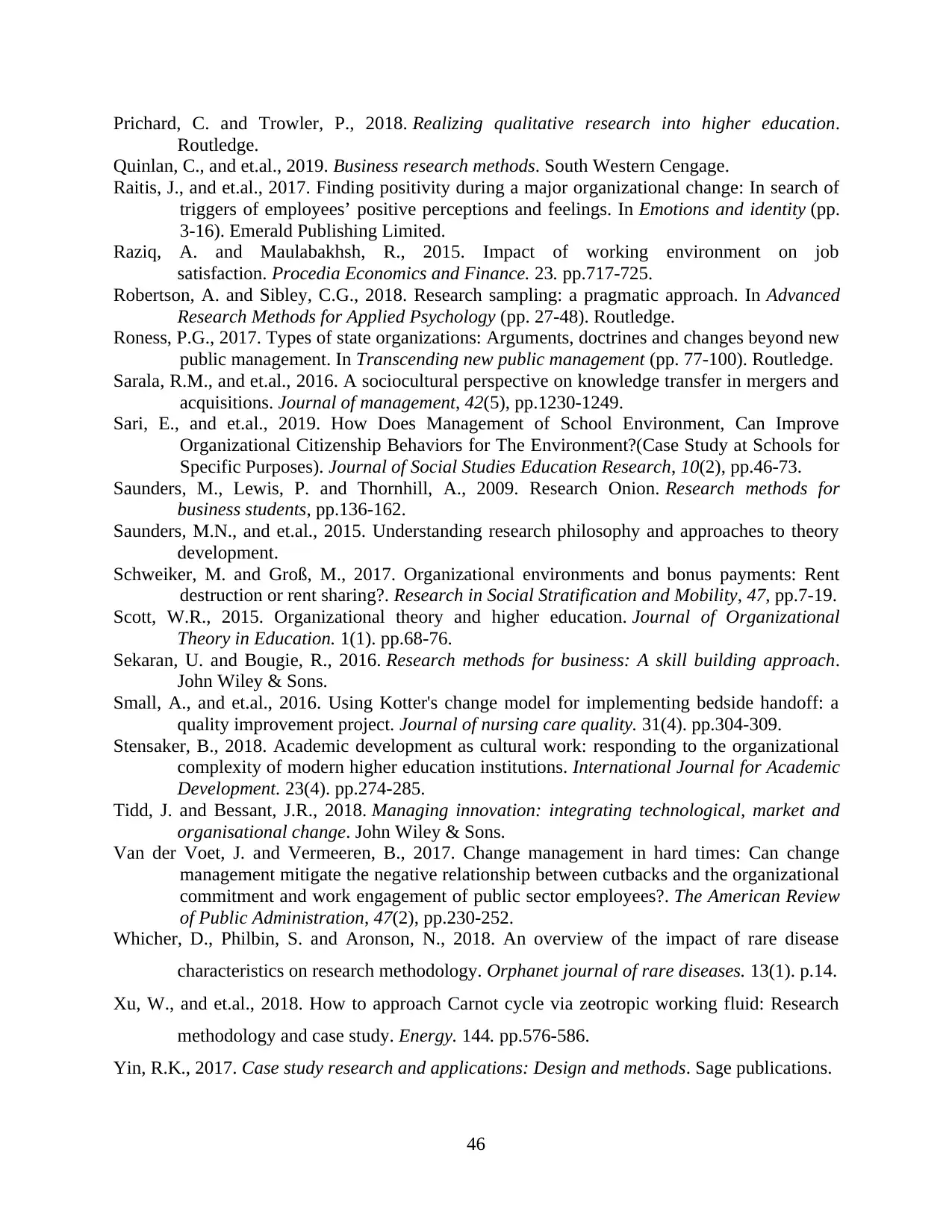
Prichard, C. and Trowler, P., 2018. Realizing qualitative research into higher education.
Routledge.
Quinlan, C., and et.al., 2019. Business research methods. South Western Cengage.
Raitis, J., and et.al., 2017. Finding positivity during a major organizational change: In search of
triggers of employees’ positive perceptions and feelings. In Emotions and identity (pp.
3-16). Emerald Publishing Limited.
Raziq, A. and Maulabakhsh, R., 2015. Impact of working environment on job
satisfaction. Procedia Economics and Finance. 23. pp.717-725.
Robertson, A. and Sibley, C.G., 2018. Research sampling: a pragmatic approach. In Advanced
Research Methods for Applied Psychology (pp. 27-48). Routledge.
Roness, P.G., 2017. Types of state organizations: Arguments, doctrines and changes beyond new
public management. In Transcending new public management (pp. 77-100). Routledge.
Sarala, R.M., and et.al., 2016. A sociocultural perspective on knowledge transfer in mergers and
acquisitions. Journal of management, 42(5), pp.1230-1249.
Sari, E., and et.al., 2019. How Does Management of School Environment, Can Improve
Organizational Citizenship Behaviors for The Environment?(Case Study at Schools for
Specific Purposes). Journal of Social Studies Education Research, 10(2), pp.46-73.
Saunders, M., Lewis, P. and Thornhill, A., 2009. Research Onion. Research methods for
business students, pp.136-162.
Saunders, M.N., and et.al., 2015. Understanding research philosophy and approaches to theory
development.
Schweiker, M. and Groß, M., 2017. Organizational environments and bonus payments: Rent
destruction or rent sharing?. Research in Social Stratification and Mobility, 47, pp.7-19.
Scott, W.R., 2015. Organizational theory and higher education. Journal of Organizational
Theory in Education. 1(1). pp.68-76.
Sekaran, U. and Bougie, R., 2016. Research methods for business: A skill building approach.
John Wiley & Sons.
Small, A., and et.al., 2016. Using Kotter's change model for implementing bedside handoff: a
quality improvement project. Journal of nursing care quality. 31(4). pp.304-309.
Stensaker, B., 2018. Academic development as cultural work: responding to the organizational
complexity of modern higher education institutions. International Journal for Academic
Development. 23(4). pp.274-285.
Tidd, J. and Bessant, J.R., 2018. Managing innovation: integrating technological, market and
organisational change. John Wiley & Sons.
Van der Voet, J. and Vermeeren, B., 2017. Change management in hard times: Can change
management mitigate the negative relationship between cutbacks and the organizational
commitment and work engagement of public sector employees?. The American Review
of Public Administration, 47(2), pp.230-252.
Whicher, D., Philbin, S. and Aronson, N., 2018. An overview of the impact of rare disease
characteristics on research methodology. Orphanet journal of rare diseases. 13(1). p.14.
Xu, W., and et.al., 2018. How to approach Carnot cycle via zeotropic working fluid: Research
methodology and case study. Energy. 144. pp.576-586.
Yin, R.K., 2017. Case study research and applications: Design and methods. Sage publications.
46
Routledge.
Quinlan, C., and et.al., 2019. Business research methods. South Western Cengage.
Raitis, J., and et.al., 2017. Finding positivity during a major organizational change: In search of
triggers of employees’ positive perceptions and feelings. In Emotions and identity (pp.
3-16). Emerald Publishing Limited.
Raziq, A. and Maulabakhsh, R., 2015. Impact of working environment on job
satisfaction. Procedia Economics and Finance. 23. pp.717-725.
Robertson, A. and Sibley, C.G., 2018. Research sampling: a pragmatic approach. In Advanced
Research Methods for Applied Psychology (pp. 27-48). Routledge.
Roness, P.G., 2017. Types of state organizations: Arguments, doctrines and changes beyond new
public management. In Transcending new public management (pp. 77-100). Routledge.
Sarala, R.M., and et.al., 2016. A sociocultural perspective on knowledge transfer in mergers and
acquisitions. Journal of management, 42(5), pp.1230-1249.
Sari, E., and et.al., 2019. How Does Management of School Environment, Can Improve
Organizational Citizenship Behaviors for The Environment?(Case Study at Schools for
Specific Purposes). Journal of Social Studies Education Research, 10(2), pp.46-73.
Saunders, M., Lewis, P. and Thornhill, A., 2009. Research Onion. Research methods for
business students, pp.136-162.
Saunders, M.N., and et.al., 2015. Understanding research philosophy and approaches to theory
development.
Schweiker, M. and Groß, M., 2017. Organizational environments and bonus payments: Rent
destruction or rent sharing?. Research in Social Stratification and Mobility, 47, pp.7-19.
Scott, W.R., 2015. Organizational theory and higher education. Journal of Organizational
Theory in Education. 1(1). pp.68-76.
Sekaran, U. and Bougie, R., 2016. Research methods for business: A skill building approach.
John Wiley & Sons.
Small, A., and et.al., 2016. Using Kotter's change model for implementing bedside handoff: a
quality improvement project. Journal of nursing care quality. 31(4). pp.304-309.
Stensaker, B., 2018. Academic development as cultural work: responding to the organizational
complexity of modern higher education institutions. International Journal for Academic
Development. 23(4). pp.274-285.
Tidd, J. and Bessant, J.R., 2018. Managing innovation: integrating technological, market and
organisational change. John Wiley & Sons.
Van der Voet, J. and Vermeeren, B., 2017. Change management in hard times: Can change
management mitigate the negative relationship between cutbacks and the organizational
commitment and work engagement of public sector employees?. The American Review
of Public Administration, 47(2), pp.230-252.
Whicher, D., Philbin, S. and Aronson, N., 2018. An overview of the impact of rare disease
characteristics on research methodology. Orphanet journal of rare diseases. 13(1). p.14.
Xu, W., and et.al., 2018. How to approach Carnot cycle via zeotropic working fluid: Research
methodology and case study. Energy. 144. pp.576-586.
Yin, R.K., 2017. Case study research and applications: Design and methods. Sage publications.
46
1 out of 51
Related Documents
Your All-in-One AI-Powered Toolkit for Academic Success.
+13062052269
info@desklib.com
Available 24*7 on WhatsApp / Email
![[object Object]](/_next/static/media/star-bottom.7253800d.svg)
Unlock your academic potential
© 2024 | Zucol Services PVT LTD | All rights reserved.





